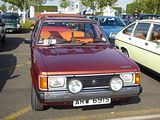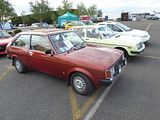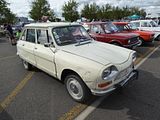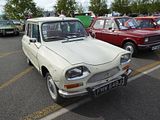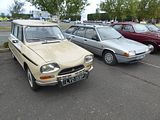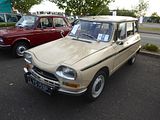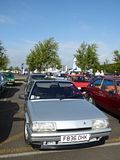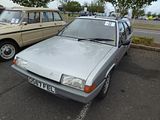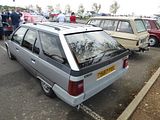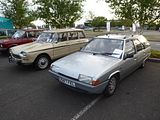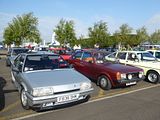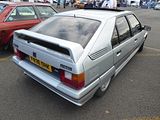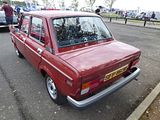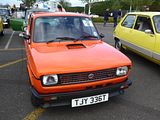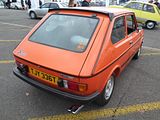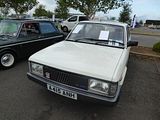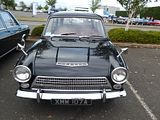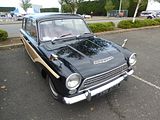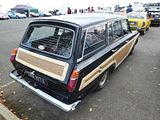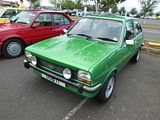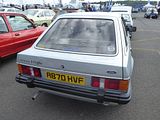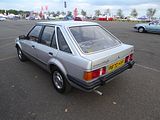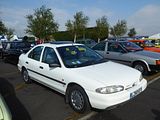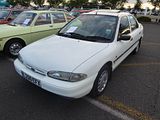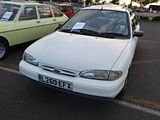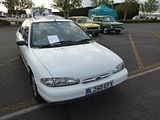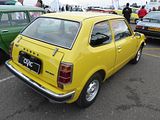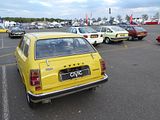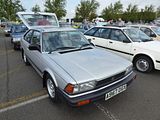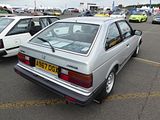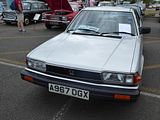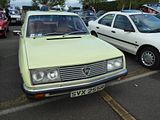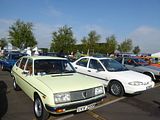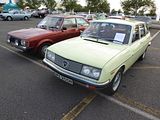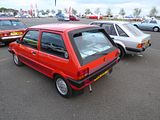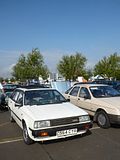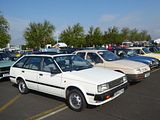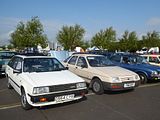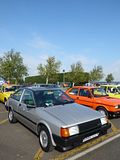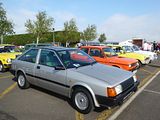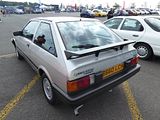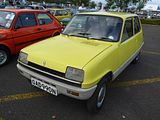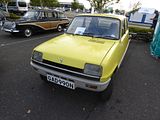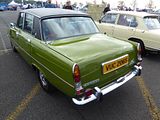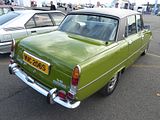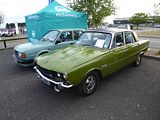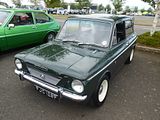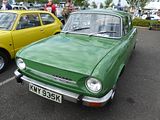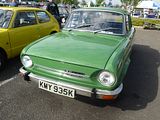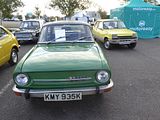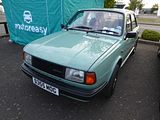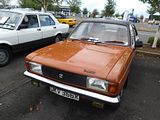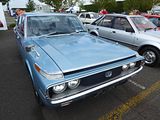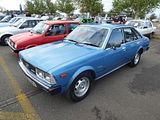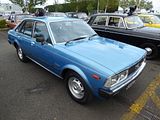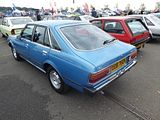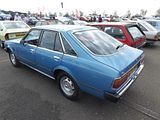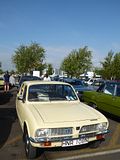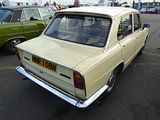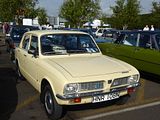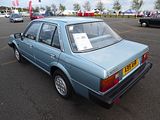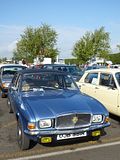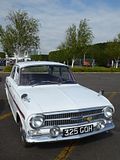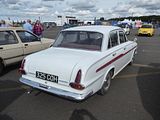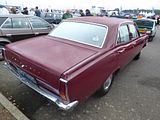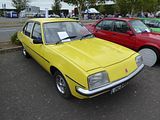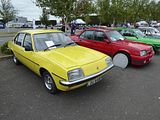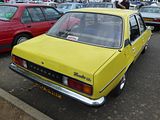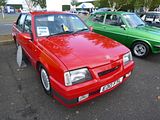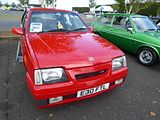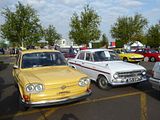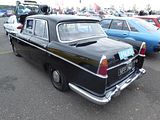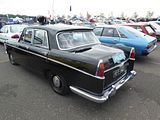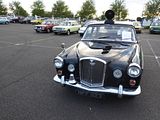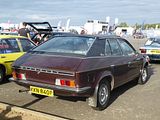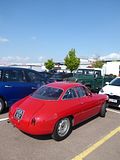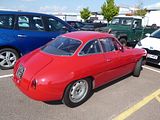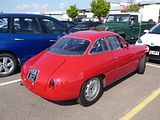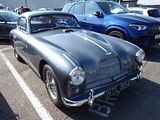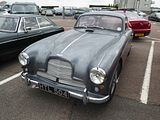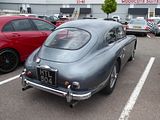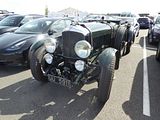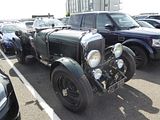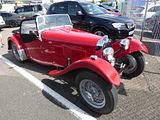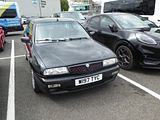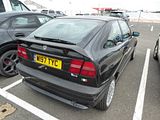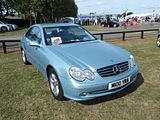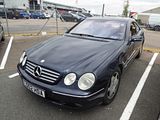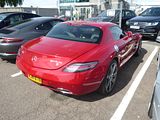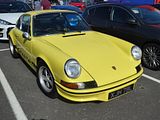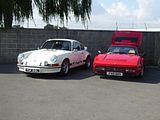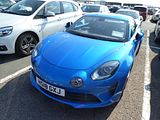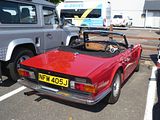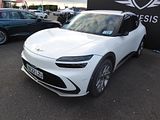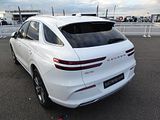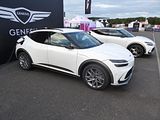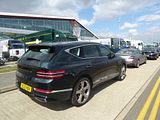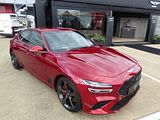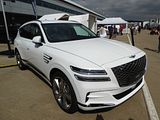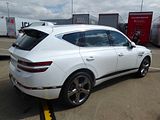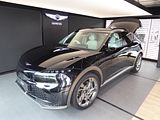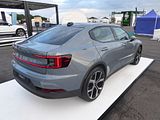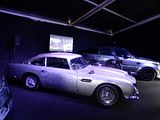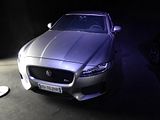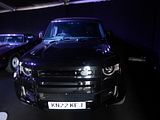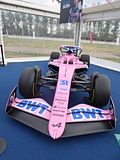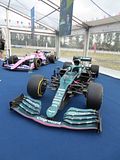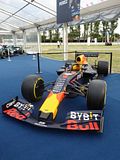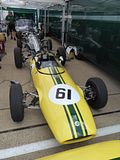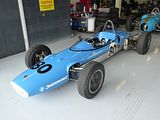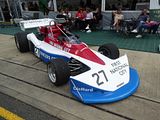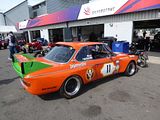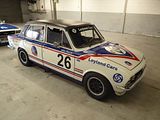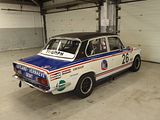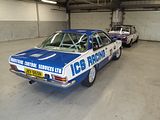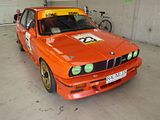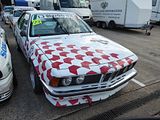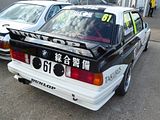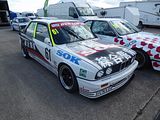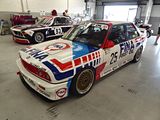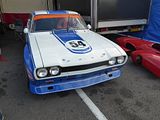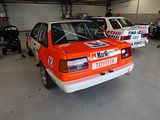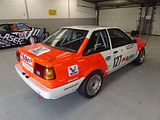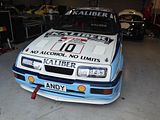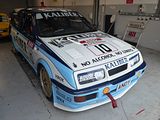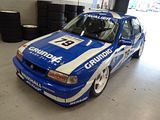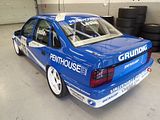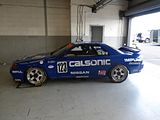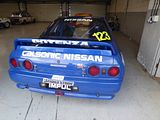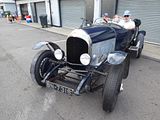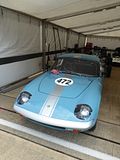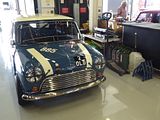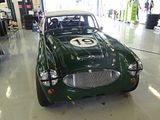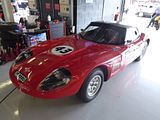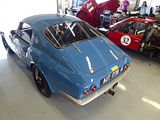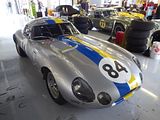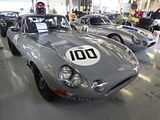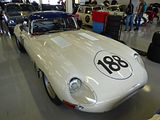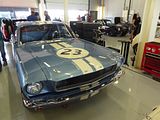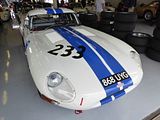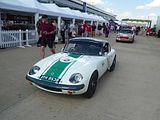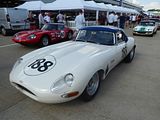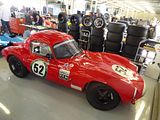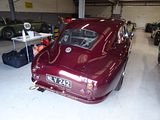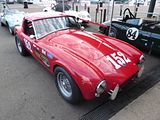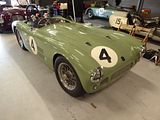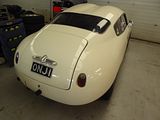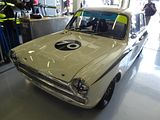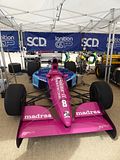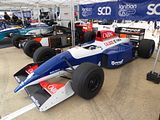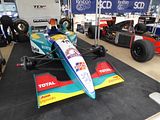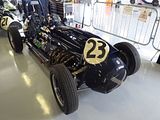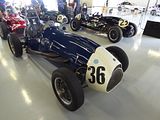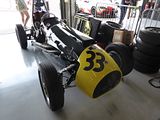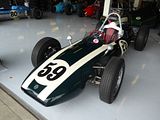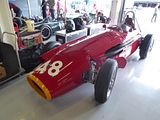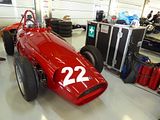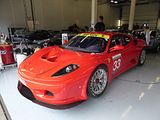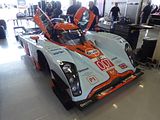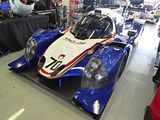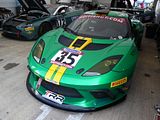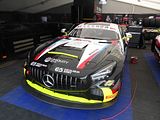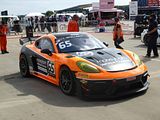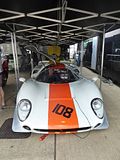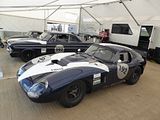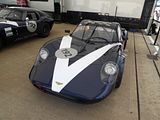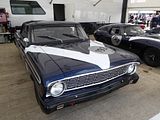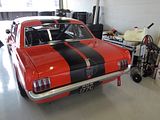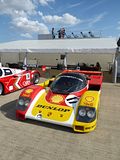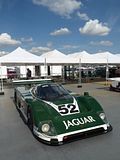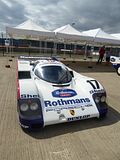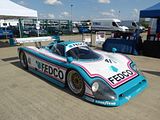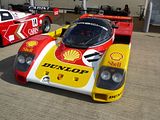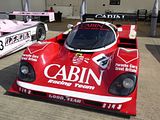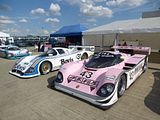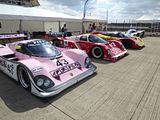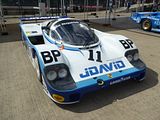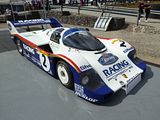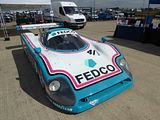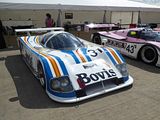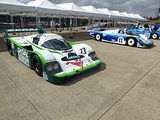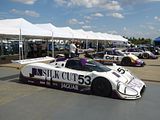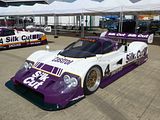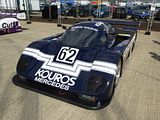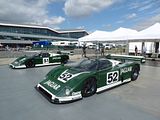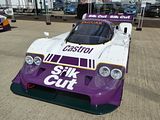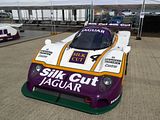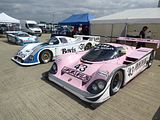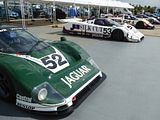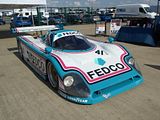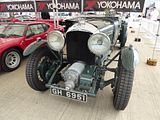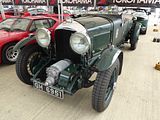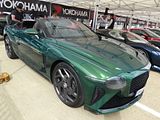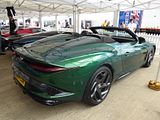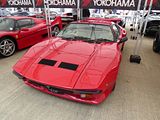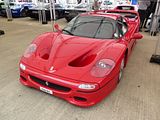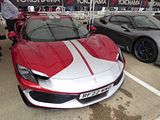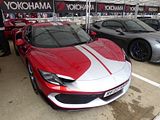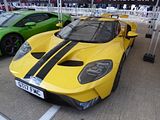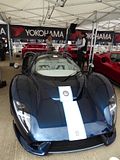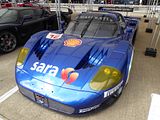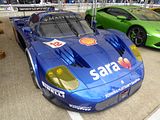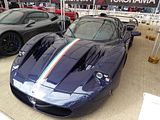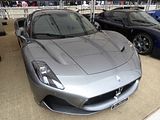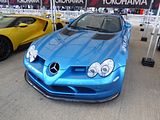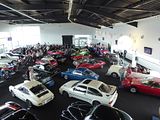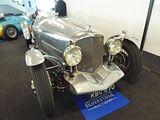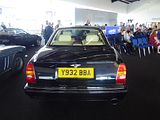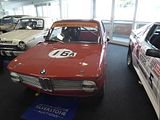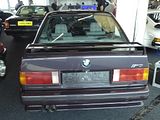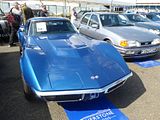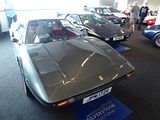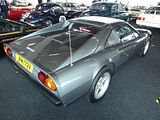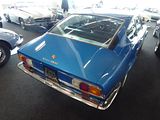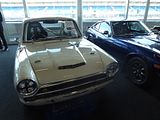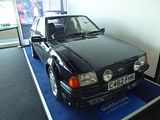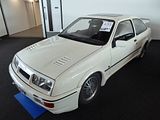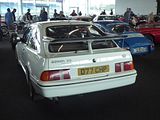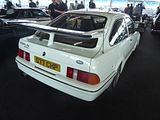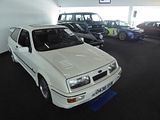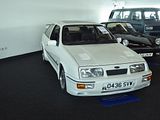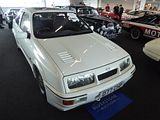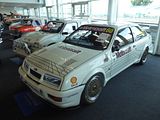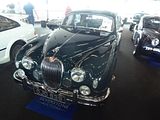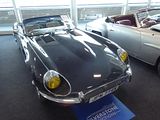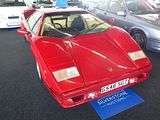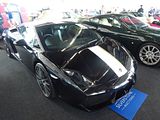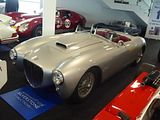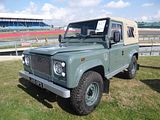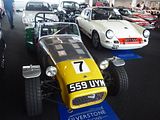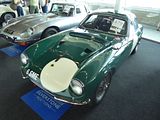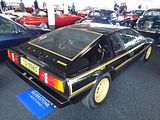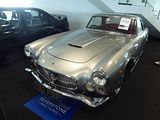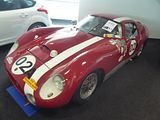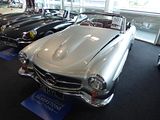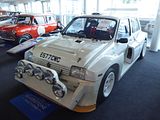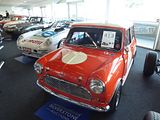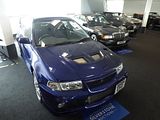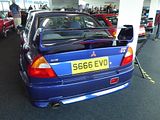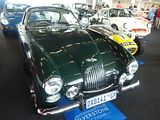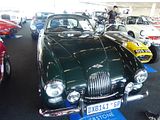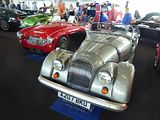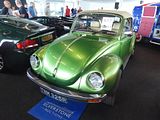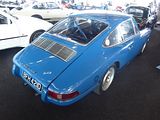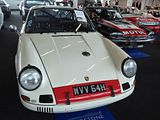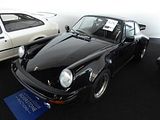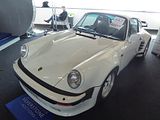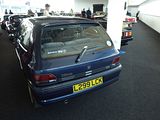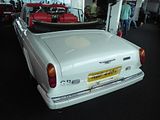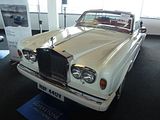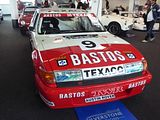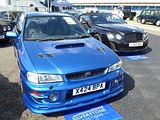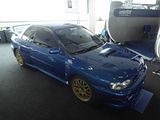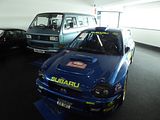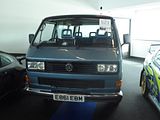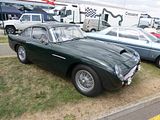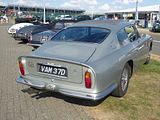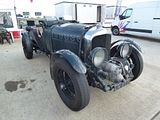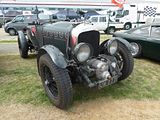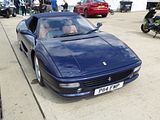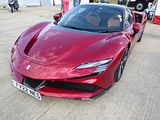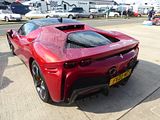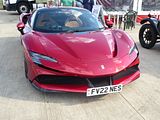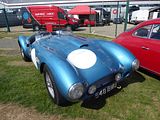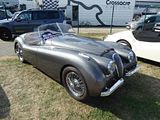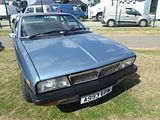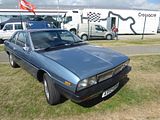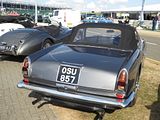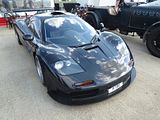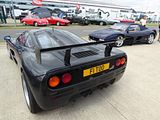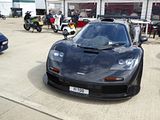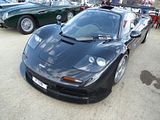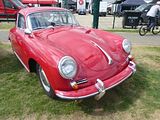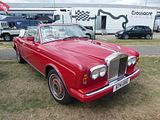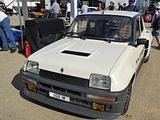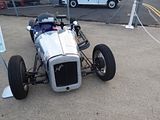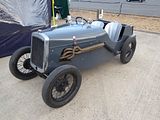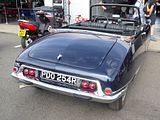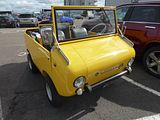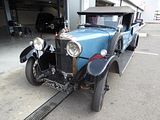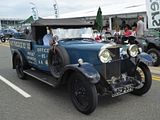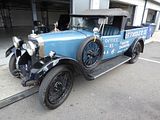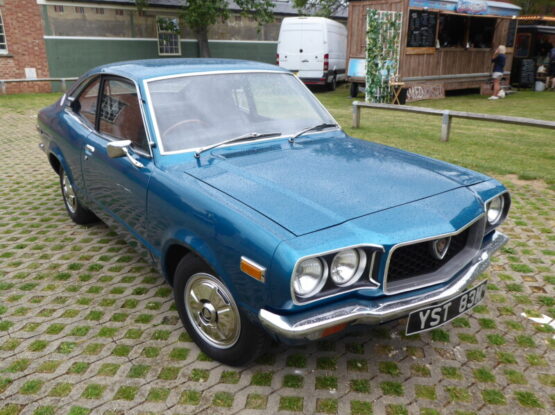RAREST CARS
Returning to the event after having been well received in 2021 was a feature called the UK’s “Rarest Cars”. Sponsored by the Daily Telegraph, this was a collection of cars that were once common (in most cases) but which are now down to very small number of survivors. Unlike last year, there was no clash with the “Festival of the Unexceptional” event so most of the cars were here for all three days, and I was also delighted to see that most of the collection, collated by renowned journalist Andrew Roberts, were different to the 2021 display. The cars were parked right by the Abarth area and this was the first place i went, and I spend some considerable time taking all the cars in. .
Audi 100LS: The premiere of the Audi 100 in 1968 was preceded by a turbulent history because its development was actually started in secret. In the mid-1960s, Volkswagen AG acquired Auto Union GmbH and prevented the company from developing any new models. This stipulation to only look after the existing models was ignored by Ludwig Kraus, then Technical Director at Auto Union GmbH. In 1965, Kraus wanted to expand the range of vehicles which the resuscitated Audi brand offered. He saw adding a model in the executive segment as the only way to keep an independent Auto Union GmbH afloat in a time when the Ingolstadt plant was being used for production of the VW Beetle. Without informing Volkswagen, Kraus developed and subsequently presented the concept before it was eventually given the go-ahead from the team in Wolfsburg. The Audi 100 debuted at the Frankfurt Show in 1968 in two-door and four-door sedan form. Rupert Neuer headed the design team, achieving a modern and aerodynamically efficient shape that managed to be visually lighter than the BMW and Mercedes-Benz competitors of the time while also distancing itself from the visual themes of its two rivals. The 100 had its own unique look, and the four rings were positioned prominently on the grille, signalling the re-emergence of the Audi marque. The 100 was initially powered by a longitudinally mounted, Daimler-based 1.7-litre four-cylinder, good for 115 hp and 119 lb-ft of torque, and was later joined by a 1.8-litre unit. Offered with a choice of a four-speed manual or a three-speed automatic transmission. “With the Audi 100, the Volkswagen Group suddenly added a car in its range that appealed to the up-and-coming Beetle buyers,” Audi says. “In addition, Audi managed to win many customers with the Audi 100 who identified themselves with other brands. The fact that from 1971, the large Audi could optionally be supplied with up to 112 hp also contributed to its success. Thanks to its lightweight construction, the Audi 100 GL was so appealing that customers increasingly switched from competing six-cylinder models to the new Audi.” Very quickly, the capacity of the Ingolstadt plant was pushed to its limits and thus Auto Union shifted the entire production of the Audi 100 to the Neckarsulm works in 1970. Volkswagen made an effort to push the model upmarket, in time setting its sights on offerings BMW and Mercedes-Benz, and the stylish Coupe was one manifestation of that ambition. It was not the only up-market car, of course, as there was still the NSU Ro80 as a stable mate, and there had been the ill-fated VW K70 but by 1976, however, it was clear which model had won out, and with nearly 800,000 produced, the Audi 100 pointed to a path forward for the entire Audi lineup, working to cement its place as Volkswagen’s upmarket division. From the first series alone, the company sold 800,000 units. There were four examples from the first generation here, a rare 2 door saloon and an even rarer 1969 Cabrio, the very stylish Coupe and a prototype electric car from 1976 which had a boot full of batteries.
Chrysler Sunbeam: The Chrysler Sunbeam is a small supermini three-door hatchback manufactured by Chrysler Europe at the former Rootes Group factory in Linwood in Scotland, from 1977-81. The Sunbeam’s development was funded by a UK Government grant with the aim of keeping the Linwood plant running, and the small car was based on the larger Hillman Avenger, also manufactured there. After the takeover of Chrysler’s European operations by PSA, the model was renamed Talbot Sunbeam and continued in production until 1981. A Talbot Sunbeam Lotus version was successful in rallying and won the World Rally Championship manufacturers’ title for Talbot in 1981. In the mid-1970s, the British automotive industry was in crisis, marred by bad management, frequent strikes and decreasing competitiveness compared to the increasingly successful French and Japanese automakers. It took its toll on Chrysler UK, which was the name given to the former Rootes Group after its takeover by the American-based Chrysler Corporation. In particular, the Linwood facility was generating losses due to many reasons, including underutilised capacity. In 1975, the infamous Ryder Report led to the effective nationalisation of Chrysler UK’s major competitor, British Leyland. Chrysler management decided that the company should therefore also benefit from state aid, and pressed the government for it by threatening to close the UK operations. The government agreed to a state grant reported at £55,000,000 to fund the development of a small car, to be developed in Chrysler’s UK facilities and manufactured in Linwood. The development of the new car started in January 1976, under the codename Project R424. The technical side was the responsibility of the engineering team in Ryton, while the styling was the responsibility of Chrysler’s Whitley design studio in Coventry, led by Roy Axe (who left the UK for Chrysler’s headquarters in the US before the car was launched). Many constraints, such as a very tight schedule, low budget and the need to use as many British components as possible, led to the decision to use the rear-wheel drive Hillman Avenger as the base for the new vehicle, rather than the more trendy front-wheel drive constructions of Chrysler’s French subsidiary, Simca. The Sunbeam was, unlike the larger Horizon and Alpine models which were launched by Chrysler in the mid to late 1970s, never sold in France as a Simca. Although it was targeted at the supermini size class, the Sunbeam’s Avenger underpinnings meant that it was slightly larger than its intended rivals, and overlapped with the Horizon model. For this reason, the Sunbeam was only available as a three-door derivative. Basing the car on the Avenger’s platform allowed for the car not only to use as many existing components as possible, but also to put it in production in Linwood quickly and at minimal investment. The Avenger’s wheelbase was shortened by 3 inches (76 mm), and some modifications were made to accommodate the 928 cc Coventry Climax-derived engine, an enlarged version of the 875cc unit used in the rear-engined Hillman Imp, also made in Linwood. Other than that, most components were identical to those of the Avenger. The car took its steering wheel and instrument pod from Chrysler’s recently launched award-winning Simca 1307/Chrysler Alpine. On the outside, with the exception of the doors, which were straight from the two-door Avenger, the R424 was given an all-new body, styled very much in line with Chrysler’s new, angular “international” style, conceived by Axe, which was first presented with the debut of the 1975 Simca 1307/Chrysler Alpine, and was later also represented by the 1977 Simca/Chrysler Horizon (Project C2). This ensured that the R424 fitted in well with the new Chrysler lineup and came across as fairly modern. Nevertheless, a constraint in the development process took its toll on the initial look of the car – as the C2’s (Horizon’s) headlamps were not available at the planned launch time of the R424, the small car was given the lamps of the pre-facelift Hillman Avenger, which required the characteristic recessed mounting in the front fascia. The GLS version had a vinyl roof as standard. There was only one body style for the Sunbeam, that of a three-door hatchback. The car was literally a hatchback, with the rear hatch formed out of a single piece of glass as seen previously on the Hillman Imp. This required a high rear sill, which, while increasing structural rigidity made the loading and unloading of luggage rather difficult. Although it was a good looking car with clean modern lines, the tricky luggage compartment and the lack of alternative bodystyles – the reasoning being that the Avenger range already offered saloon and estate variants – ultimately compromised the car’s appeal in the UK market. The Sunbeam’s main competitor in the UK, the Vauxhall Chevette was produced in different body styles, two- and four-door saloons and an estate, catering to a broader range of customers. On the interior side, the “GL” version was the first car to sport printed “melded” fabric from Cambrelle on its seats. These have been considered similar to the Avenger in their comfort. Until the R424’s launch, most Chrysler UK products were sold in export markets under the Sunbeam brand of the former Rootes portfolio. Chrysler, however, was striving to cut down on the Rootes brand palette (which at that time existed solely by means of badge engineering) and introduce a pan-European image using the Chrysler brand as the only one for the whole range. The result was naming the car, “Chrysler Sunbeam”, and the Sunbeam brand was discontinued, with the remaining Rootes Group models also rebranded as Chryslers in 1976. After a remarkably short development period of 19 months, the Chrysler Sunbeam was launched on July 23, 1977, to a quite positive reception by the British automotive press. An advertising campaign featured Petula Clark singing “…put a Chrysler Sunbeam in your life.” There were initially three engine sizes; 0.9, 1.3 and 1.6 litres, and three trim levels available – base “LS”, better-equipped “GL” and the most expensive “S”. To reduce in-house competition, the more basic versions of the two-door Avengers were dropped at the same time in the UK market, and the Chrysler Horizon was only available in five-door form. The Sunbeam sold well, but was not a runaway success. In spite of the ability to keep the UK business afloat, Chrysler was still making losses both in Europe and at home, and, facing the possibility of complete bankruptcy, decided to sell Chrysler Europe to PSA. The French company took control of the former Chrysler Europe effective January 1, 1979, and in the course of the year announced all former Chrysler Europe products would be rebranded to Talbots starting August 1, 1979. The Sunbeam was simply rebadged in the strictest sense of the word, with the Chrysler badge on the bonnet replaced by one that read “Talbot”, but retaining its grille with a prominent Chrysler pentastar until 1981.
Citroen Ami 8 and Super: The Ami was a four-door, front-wheel drive supermini (B-segment), made from 1961 to 1978. At times it was the best-selling new car model in France. The Ami was offered in saloon and break (estate) body styles over two generations, the Ami 6 and the Ami 8. The Citroën Ami had its formal French launch on 25 April 1961, four months ahead of the August introduction of the widely anticipated Renault 4. Both the Renault 4 and the Citroën Ami responded to a perceived market need for a vehicle slightly larger and less rustic than the 2CV. The Ami is a rebodied 2CV with certain mechanical upgrades (particularly a larger engine than the 1950s 2CV), to compensate for the added weight. At launch all the cars were powered by an air cooled 602 cc two-cylinder flat engine which would also be offered at extra cost in the 2CV from 1970. The platform chassis and suspension is similar to the 2CV, being independent all round using leading and trailing arms and coil springs interconnected front to rear. The Ami’s seats were easily removable. Sales pitches of the Ami included photographs of the seats being used as picnic chairs. The Ami and the Ford Taunus P3 were the first cars with rectangular or lozenge-shaped (non-round) headlights. This technical innovation was developed by lighting manufacturers Hella (Taunus) and Cibie (Ami). Soon this innovation found its way to the exclusive coach built Maserati 5000 GT. At the time, it was an unquestioned article of faith that headlights were round, and in the United States, it was the law, so these new headlights were illegal there until 1975. Ten years later this had inspired European automakers to come up with various non-round headlamp shapes. The car went on sale in France in April 1961, though Citroën implemented some simple upgrades in time for the Paris Motor Show only six months later. The most visible change involved the replacement of the fixed windows on the rear doors with two-part horizontal sliding windows, similar to those already fitted on the front doors. Sales initially were not as good as those of the older 2CV; the Ami’s first full year of production was 1962, during which only 85,358 of the cars were sold, while the thirteen-year-old 2CV managed 144,759 sales during the same period. Although the Ami had a modern body, it shared the aggressively minimalist underpinnings of the older car, and this made it hard to justify a starting price for the Ami which, at the end of 1961, was 35% higher. The 1961 Ami 6 sedan is distinguished by an unusual reverse-raked notchback rear window, similar in style to the 1959 Ford Anglia 105E. A Break (estate) model joined the range in the autumn of 1964. The later Ami 8 saloon, launched in March 1969 has a fastback rear window. It was redesigned by the French car design and bodywork company, Heuliez. Most notable changes were the front part and bonnet and the sloping, rather than inverted, rear window on the saloon. The estate version of the Ami 8 had a similar general appearance to that of the Ami 6 although the later car’s taillights were integrated into the rear wings. The Ami Super was a flat-4 variant powered by the engine of the GS and produced between 1973 and 1976. At the launch of the GS, its original flat four-cylinder air-cooled 1015 cc 55 bhp DIN engine was considered to be underpowered. With surplus engines available, Citroën decided to fit the engine into the Ami 8 in January 1973. The car, which became the Ami Super, then easily reached 140 km / h. From the outside, it had a new front grille with six additional vents underneath. On the sides of the front wing there was a badge marked 1015 in reference to the new engine. The body is the same as the Ami 8 apart from changes to inner front wings, bonnet, front panel and bumper mountings. The chassis was also modified from the standard Ami 8 with alterations made to accommodate the 1015 cc engine. Other changes included thicker wire in the suspension springs, to give a tauter ride and front anti-roll bars. Rear anti-roll bars were fitted from 1974 onwards until the end of Ami Super Production in 1976. The Ami Super and Ami 8 Break (Estate) were fitted with 135 15 ZX Michelin tyres as standard while the Ami 8 Berline retained the Michelin 125 15 X although 135 15’s could be ordered as an option. Also on the Ami Super headlamps with built in Quartz iodine fog lights were offered as an option, other options included heated rear screens. Inside, the gear change is floor mounted, in place of the dashboard mounted gear lever of the Ami 6 and 8 and to accommodate this the hand brake of the Super curves up instead of down. The speedometer was also specific to the Ami Super differing slightly to allow higher speed numbers to be shown. The Ami Super was offered in the same three trim levels as the Ami 8, Luxe, Confort and Club on Saloon and Luxe and Confort on Break (estate) versions. These trim differences were fairly minor with Luxe models having bench front and rear seats and vinyl floor matting. Confort trim offered reclining front seats in place of the front bench. The Club models can be considered the Pallas of the Ami range featured sound proofing pads on the floor and bulkhead, carpet including boot lining, stainless steel trim on the window frames and side rubbing strips on the doors and rear wings. Club trim was only available up to the end of the 1973 model year, after that point Ami 8 and Ami super were only available in Luxe and Confort specification. From 1974 Ami Super models were revamped to feature a double line graphic along the exterior of the body sides, either in black or silver depending on body colour, with slotted wheels and double line detailing on the hubcaps. The rear window also featured a graphic in white proclaiming “Ami Super 1015cm³” As the Ami Super looked very much like an Ami 8, and could surprise many by demonstrating its dramatic performance advantage compared to the Ami 8 (55 hp compared to 32 hp). Quoted by Autocar magazine in the UK as a “Q car par excellence” sadly in France its 5CV tax rating made little sense in a small car and as a result sales were low compared to the Ami 8. In the UK however where no such tax penalties existed the Ami Super attracted healthy sales although is now a rare sight due to poor corrosion resistance, a feature suffered by many vehicles of this era. The Ami Super production reached close to 42,000 in sedan and station wagon by February 1976. The Ami 8 continued until early 1979 and reached in the region of 722,000 production, a significant percentage of the total of 1,840,396 of all Ami models.
Citroen BX Estate and BX 16 valve: Despite the fact that 2,315,739 BXs were built during its 12-year production run, and the car sold well in the UK, these are getting increasingly scarce, so it was nice to see a couple here, a very rare 4×4, which the owner, a real enthusiast for the model. has recently sourced, he told me and from the other end of the range, a 14E Leader. The rather angular hatchback was designed by Marcello Gandini of Bertone, based on his unused design for the British 1977 Reliant FW11 concept and his 1979 Volvo Tundra concept car. It was the second car to benefit from the merger of Peugeot and Citroën in 1976, the first being the Citroën Visa launched in 1978. The BX shared its platform with the more conventional 405 that appeared in 1987, except the rear suspension which is from a Peugeot 305 Break. Among the features that set the car apart from the competition was the traditional Citroën hydropneumatic self-levelling suspension, extensive use of plastic body panels (bonnet, tailgate, bumpers), and front and rear disc brakes. The BX dispensed with the air cooled, flat four engine which powered the GS, and replaced it with the new PSA group XY, TU and XU series of petrol engines in 1360 cc, 1580 cc and, from 1984, 1905 cc displacements. In some countries, a weaker, 80 PS version of the 1580cc engine was badged as the BX15E instead of BX16. A 1124 cc engine, in the 11TE, very unusual in a car of this size, was also available in countries where car tax was a direct function of engine capacity, such as Ireland, Italy, Portugal and Greece. The 11TE model was seen by foreign motoring press as slow and uncomfortable. It was fitted to the cars made from 1988 to 1993 and produced 55 hp. The 1.1 and 1.4 models used the PSA X engine (known widely as the “Douvrin” or “Suitcase Engine”), the product of an earlier Peugeot/Renault joint venture, and already fitted in the Peugeot 104 and Renault 14. The 1.6 version was the first car to use the all-new short-stroke XU-series engine. It was produced in a new engine plant at Trémery built specifically for this purpose, and was later introduced in a larger 1.9-litre version and saw long service in a variety of Peugeots and Citroëns. The XUD diesel engine version was launched in November 1983. The diesel and turbo diesel models were to become the most successful variants, they were especially popular as estates and became the best selling diesel car in Britain in the late 1980s. Despite being launched on the continent in the autumn of 1982, it wasn’t launched onto the British market until August 1983, initially only with 1.4 and 1.6 petrol engines, although further engine options and the estate model would arrive later, and it would go onto become one of the most popular foreign-built cars here during the second half of the 1980s. A year after the launch of the hatchback model, an estate version was made available. In 1984 power steering became optional, welcome particularly in the diesel models. In the late 1980s, a four-wheel drive system and turbodiesel engines were introduced. In 1986 the MK2 BX was launched. The interior and dashboard was redesigned to be more conventional-looking than the original, which used Citroën’s idiosyncratic “satellite” switchgear, and “bathroom scale” speedometer. These were replaced with more conventional stalks for light and wipers and analogue instruments. The earlier GT (and Sport) models already had a “normal” speedometer and tachometer. The exterior was also slightly updated, with new more rounded bumpers, flared wheelarches to accept wider tyres, new and improved mirrors and the front indicators replaced with larger clear ones which fitted flush with the headlights. The elderly Douvrin engine was replaced by the newer TU-series engine on the 1.4 litre models, although it continued to be installed in the tiny BX11 until 1992. 1988 saw the launch of the BX Turbo Diesel, which was praised by the motoring press. The BX diesel was already a strong seller, but the Turbo model brought new levels of refinement and performance to the diesel market, which brought an end to the common notion that diesel cars were slow and noisy. Diesel Car magazine said of the BX “We can think of no other car currently on sale in the UK that comes anywhere near approaching the BX Turbo’s combination of performance, accommodation and economy”. In 1989, the BX range had further minor revisions and specification improvements made to it, including smoked rear lamp units, new wheeltrims and interior fabrics. Winning many Towcar of the Year awards, the BX was renowned as a tow car (as was its larger sister, the CX), especially the diesel models, due to their power and economy combined with the self levelling suspension. The biggest problem of the BX was its variable build quality, compared to its competition. In 1983, one quarter of the production needed “touchups” before they could be shipped, though later models were more solid. The last BX was sold around 1994, by which time its successors had already been launched. It had been partially replaced by the smaller ZX in early 1991, but its key replacement was the slightly larger Xantia that went on sale at the beginning of 1993. The BX was launched onto the right-hand drive UK market in August 1983, initially only with 1.4 and 1.6 petrol engines, although by 1986 it had been joined by more engine options as well as a five-door estate model. The BX enjoyed a four-year run as the UK’s best selling diesel engine car from 1987, and was consistently among the most popular imported cars.
Fiat 128: Named European Car of the Year in 1970, over three million were manufactured, but few are left.. Introduced in 1969, it was built in an entirely new plant in Rivalta, north-west of Turin, specifically to manufacture the car. With engineering by Dante Giacosa and engine design by Aurelio Lampredi, the 128 was noted for its relatively roomy passenger and cargo volume — enabled by a breakthrough innovation to the front-engine, front-drive layout which became the layout “adopted by virtually every other manufacturer in the world”. Front-wheel drive had previously been introduced to small, inexpensive cars with the British Mini. As engineered by Alec Issigonis, the compact arrangement located the transmission and engine sharing a single oil sump — despite disparate lubricating requirements — and had the engine’s radiator mounted to the side of the engine, away from the flow of fresh air and drawing heated rather than cool air over the engine. The layout often required the engine be removed to service the clutch. As engineered by Dante Giacosa, the 128 featured a transverse-mounted engine with unequal length drive shafts and an innovative clutch release mechanism. The layout enabled the engine and gearbox to be located side by side without sharing lubricating fluid while orienting an electrically controlled cooling fan toward fresh air flow. Fiat tested this then new engineering for a full five years in the Autobianchi Primula, Fiat’s less market-critical subsidiary, Autobianchi which allowed them to sufficiently resolve the layout’s disadvantages, including uneven side-to-side power transmission, uneven tyre wear and potential torque steer, the tendency for the power of the engine alone to steer the car under heavy acceleration. The compact and efficient layout — a transversely-mounted engine with transmission mounted beside the engine driving the front wheels through an offset final-drive and unequal-length driveshafts — subsequently became common with competitors and arguably an industry standard. The 128 used an all new 1.1 litre Fiat SOHC engine, engineered by noted engine designer Aurelio Lampredi, featuring an iron block mated to an aluminium head along with a belt-driven single overhead camshaft producing 49 hp. The 128 was styled similarly to the 124 and 125 and featured rack-and-pinion steering, front disc brakes, independent rear suspension with a transverse leaf spring, and a strut-type front suspension with integral anti-roll bar. Initially, the 128 was available as a two-door or four-door sedan. At the 1970 Turin Motor Show a three-door station wagon model called “Familiare” was added to the line-up. The car was only available with a 1116 cc engine on launch, though the two-door-only 128 Rally edition launched in 1971 used a 1,290 cc unit. Also in 1971, the Sport Coupé, an all-new coupé body on a shortened 128 platform, was unveiled at the Turin Show. On launch it was available with both existing 128 engines. The 128 range underwent a facelift in 1972, featuring a revised grille. 1974 saw the launch of the 128 Special, which used the Rally engine in a four-door sedan body. In 1975 the 128 3P (3-door) Berlinetta replaced the Sport Coupé. In 1976, the range received new bumpers, rectangular headlights, tail lights and dashboard as well as modifications to the engines. At this time, the estate was also renamed the “Panorama”. Production of all 128s except that of the base 1,100 cc powered model ended in 1979 after the introduction of the Fiat Ritmo/Strada in 1978. In 1980 production of the small three-door station wagon Panorama was dropped from the range and 128 production finally ended in 1985.
Fiat 127 Sport: You don’t often see examples of the once very popular 127 range here, so this 127 Sport was a pleasant surprise. Developed towards the end of the 1960s, the Fiat 127 was launched as a two-door saloon in April 1971. A three-door hatchback, using an identical body profile but with a full-depth rear door and folding rear seat, was launched the following year; this would prove to be the most popular version of the 127. This was Fiat’s first supermini-sized hatchback, along with a state-of-the-art transverse-engine/front-wheel-drive layout, with the transmission mounted on the end of the engine, both design ideas had been fully trialled since 1964, by Fiat’s Autobianchi subsidiary with the Autobianchi Primula and 1969 Autobianchi A112 and A111 – although these models were not as widely exported as the 127 was. The larger Fiat 128, launched in 1969, was the first Fiat badged car to use the same transverse powertrain layout. The 127 used, as the A112, a shrunken version of the 128 platform and the rugged Fiat OHV 100 series 903 cc engine, that had powered the Autobianchi and, with various cylinder capacities, earlier generations of Fiat cars. The 127 also featured a unique transverse leaf spring suspension at the rear. Safety was another area of innovation – the 127 included an articulated steering column and crumple zones for progressive deformation under impact. The car was one of the first of the modern superminis, and won praise for its utilisation of space (80 percent of the floor space was available for passengers and luggage) as well as its road-holding. It was launched a year before the comparable Renault 5, and before the end of the 1970s most mass market European manufacturers were producing similar cars, notable examples being the Ford Fiesta and Volkswagen Polo, while General Motors added a three-door hatchback to the Opel Kadett range, which was reworked for British production and sold as the Vauxhall Chevette. The 127 was also one of the more popular imported cars on the UK market, peaking at more than 20,000 sales in 1978. It was also the first car fitted with an all-polypropylene bumper on steel support. The 127 was an instant success, winning the European Car of the Year award for 1972, and quickly became one of the best-selling cars in Europe for several years. It was the third Fiat in six years to receive this accolade. In June 1974, slightly over three years after the model’s introduction, Fiat reported that the one millionth 127 had been completed at the Mirafiori plant in Turin, after just over three years in production. The (in its time) hugely successful Fiat 600 had taken seven years to reach that same milestone. The Series 1 car changed little during its lifetime. However, in May 1973 saloons became available in both standard and deluxe versions. In 1975 the 127 Special variant was released which featured a restyled front grille and detail changes to the interior. The deluxe version was differentiated by its reclining front seats and opening hinged rear side windows as standard equipment. During the next couple of years the Fiat 850, which had initially been marketed alongside the 127, was withdrawn from most markets. The Series 2 version of the 127 debuted in May 1977. It featured a restyled front and rear, a new dashboard (although almost identical in layout to that of the Series 1), larger rear side windows (using rear quarter pressings derived from those used on the Brazil market Fiat 147) and the option of the 1049 cc engine – uniquely for the 127 this was the five-bearing OHC “Brazil” 124 series engine from the 147 rather than the Fiat OHC unit from the 128. The tailgate was extended and now reached nearly to the rear bumper, addressing complaints about the high lip over which luggage had to be lifted for loading into the earlier 127 hatchbacks. A short-lived Series 3 came early in 1982, but when the Uno followed it just a year later, the car was deleted from most European markets.
Fiat Argenta: The Argenta was a comprehensive update of the Fiat 132 and the last mass-produced Fiat with rear-wheel drive until the 2016 124 Spider. The change to a name came about as Fiat was changing their naming strategy, changing from three-digit numbers to more meaningful names. This model was available in sedan/saloon bodystyle only. The Argenta was closely based on its predecessor Fiat 132. All body panels and windows except the doors were new. Other changes included new trim, wheels, dashboard, mirrors and rectangular headlights. Trim level was raised compared to the previous 132 and the contemporary 131 Mirafiori, with power steering, electric windows and door locking. Some markets had a large manually-sliding steel sunroof, others had air conditioning. The Argenta came with a choice of four different engines, although not all were available in all of the Argenta’s markets: a 96 bhp 1600, a 113 bhp 2 litre carburettor, a 122 bhp 2.0 litre injection and a 75 bhp 2.5 litre diesel. In 1984, the Argenta was facelifted. The grille was renewed with the then corporate 5-bar grille, new front end, new bumpers and an anti-roll-bar was mounted on the rear axle. The front axle was widened by 60 mm (2.4 in), and new wheels with flat wheel trims & chrome embellishers used. Some minor changes were made inside the car, most notably to the seat/door/rooflining trim and a new steering wheel. The radio antenna moved from inside the windscreen to the roof. The Argenta had also two new engines: Fiat’s first turbodiesel, 2.5 litre producing 90 bhp and for the Argenta VX a supercharged 2.0 engine with 135 bhp, shared with the Lancia Volumex models. Both these models had rear disc brakes and a 70-litre fuel tank instead of the usual 60 litres. The car remained in production until 1985 when it was replaced by the Croma.
Ford Consul Cortina Estate: Using the project name of “Archbishop”, management at Ford of Britain in Dagenham created a family-sized car which they could sell in large numbers. The chief designer was Roy Brown Jr., the designer of the Edsel, who had been banished to Dagenham following the failure of that car. The car was designed to be economical, cheap to run and easy and inexpensive to produce in Britain. The front-wheel drive configuration used by Ford of Germany for the new Ford Taunus P4, a similarly sized model, was rejected in favour of traditional rear-wheel drive layout. Aimed at buyers of the Morris Oxford Farina and Vauxhall Victor, the car was launched as the Consul Cortina was launched on 20 September 1962. with a 1,198 cc three-bearing engine, which was an enlarged version of the 997 cc engine then fitted in the Ford Anglia. A few months later, in January 1963, the Cortina Super was announced with a five-bearing 1,498 cc engine. Versions of the larger engine found their way into subsequent variations, including the Cortina GT which appeared in spring 1963 with lowered suspension and engine tuned to give a claimed output of 78 bhp ahead of the 60 bhp claimed for the Cortina 1500 Super. The engines used across the Mark I range were of identical design, differing only in capacity and setup. The formula used was a four-cylinder pushrod design that came to be known as the “pre-crossflow” version as both inlet and exhaust ports were located on the same side of the head. The most powerful version of this engine (used in the GT Cortina) was 1,498 cc and produced 78 bhp. This engine contained a different camshaft profile, a different cast of head featuring larger ports, tubular exhaust headers and a Weber double barrel carburettor. Advertising of the revised version, which appeared at the London Motor Show in October 1964, and which dropped the Consul name from its official designation, made much of the newly introduced “Aeroflow” through-flow ventilation, evidenced by the extractor vents on the rear pillars. A subsequent test on a warm day involving the four different Cortina models manufactured between 1964 and 1979 determined that the air delivery from the simple eyeball outlets on the 1964 Mark I Cortina was actually greater than that on the Mark II, the Mark III or the Mark IV. The dashboard, instruments and controls were revised, for the second time, having already been reworked in October 1963 when round instruments replaced the strip speedometer with which the car had been launched: twelve years later, however, the painted steel dashboard, its “knobs scattered all over the place and its heater controls stuck underneath as a very obvious afterthought” on the 1964 Mark I Cortina was felt to have aged much less well than the car’s ventilation system. It was also in 1964 that front disc brakes became standard across the range. The Mark 1 Cortina was available as a two-door and four-door saloon, as well as in five-door estate (from March 1963) forms. Standard, Deluxe, Super, and GT trims were offered but not across all body styles. Early Standard models featured a simple body coloured front grille, earning it the nickname ‘Ironbar’. Since this version cost almost the same as the better equipped Deluxe it sold poorly and is very rare today. Options included heater and bench seat with column gearchange. Super versions of the estates offered the option of simulated wood side and tailgate trim. In an early example of product placement many examples of the brand new Cortina featured as “Glamcabs” in the comedy film Carry On Cabby.
Ford Fiesta
Ford Escort Ghia: Codenamed “Erika”, the third generation Escort was launched in September 1980. The car, Ford Europe’s second front-wheel drive model, was originally meant to be called the “Ford Erika”, but ended up retaining the Escort name. Some say this was due to British consumers’ reluctance to let go of the “Escort” badge (as the first two generations of Escort had been among Britain’s most popular cars, with the Mk II being Britain’s best selling car in 1976), and some say that the Germans were concerned with the song Erika, which was a famous battlemarch of the German armed forces during World War II. The North American Escort introduced at this time was a distantly related derivative. Sales in the United Kingdom increased, and by 1982 it had overtaken the ageing Cortina as the nation’s best-selling car, beginning an eight-year run as Britain’s best selling car. Unlike the Mark II, which had essentially been a reskin of the original 1968 platform, the Mark III was a completely new design, and was conceived as a hi-tech, hhigh-efficiency vehicle which would compete with the Volkswagen Golf and Honda Civic – considered at the time the class benchmarks. The Mark III was therefore a major engineering and stylistic departure from the two previous models; the biggest changes being the adoption of front-wheel drive, the new hatchback body and the all-new CVH overhead camshaft engines. The suspension was fully independent all around, departing from the archaic leaf spring arrangement found on its predecessors and the bodyshell was on average, 75kg lighter than that of the Mk II, yet Ford claimed was stiffer than the outgoing car. Ford however, was conscious that loyal customers of the previous generation Escorts may be deterred by the Mk III’s advanced design, and hence the car was marketed in the United Kingdom with the strapline “Simple is Efficient”. It was Ford Europe’s second front-wheel drive model launch, the first being the smaller Fiesta in 1976. The car used Ford’s contemporary design language of the period with the black louvred radiator grille and straked rear lamp clusters, as well as introducing the aerodynamic “bustle-back” bootlid stump (trademarked by Ford as Aeroback) which would be further developed in the forthcoming Sierra and Scorpio; the stump was proven to reduce the car’s aerodynamic drag co-efficient significantly, which was a class-leading 0.38 at launch. New were the overhead camshaft CVH engines in 1.3 L and 1.6 L formats, with the older Ford Kent-based “Valencia” engine from the Fiesta powering the 1.1 L derivative, although there was a short-lived 1.1 version of the CVH engine sold in certain markets before it was discontinued in 1982. The Escort Mark III was voted European Car of the Year in 1981, fighting off stiff competition from Italy’s Fiat Panda and British Leyland’s Austin Metro. From launch, the car was available in base (Popular), L, GL, Ghia and XR3 trim. As was common for Ford during this period, there were different dashboard mouldings for “high” and “low” series trim levels. GL and above models had a slush-moulded dashboard with ‘soft feel’ covering, and faux chrome embellishment. Base and L specification models had a ‘hard feel’ injection moulded dashboard with fewer holes for switches – the base dashboard was a sub-variation of this which omitted the centre air vents, glovebox, side demister vents and speaker grille and only a two-position blower fan switch. These lead-in models were extremely basic even for their time; in addition to the aforementioned dashboard, they came with just partial door cards with no armrests, vinyl seats (cloth was an optional extra), and no rear parcel tray or push button tailgate release. Consequently, these models sold very poorly and most buyers opted for at least the L specification. From mid-1982, a five-speed manual gearbox was introduced across the range. This was now standard on the 1.6 L versions and could be specified as an option on most 1.3 L engines. A selection of features was available, either as standard fitment or optional extras depending on model, including a tilt-and-slide sunroof, central locking, and electric windows. All models except for base and L were fitted with a check-light system for low fuel, low oil, low coolant, low screenwash, and worn out brake pads. Power steering was not available on European Escorts although it was available on the US Escort. The 1983 model year saw the Ford ATX three-speed automatic transmission (developed primarily for the US version) becoming available on the 1.6 L engine, and the base models now had cloth seat trim as standard. The Escort estate was initially only available with three doors, but a five-door version was introduced in 1983. In that year, a saloon version of the Escort, the Orion, was launched. It used the same mechanicals as the hatchback, but had a more upmarket image and was not available with the smaller 1.1 L engine. It was also directed at buyers of the earlier Cortina, which had ceased production in 1982, with its Sierra successor not available as a saloon at the time. However, the car attracted criticism from the motoring press at launch due to its suspension, with positive camber on the front wheels and negative camber at the rear, giving rise to the Mark III’s infamous “knock-kneed” stance. The Mark III soon had a reputation for a harsh, unforgiving ride. In September 1983 the revised suspension mounts from the Escort-based Orion and the larger Sierra steering rack were introduced as running changes for the 1984 model year which also coincided with other minor upgrades across the range, which included revised trim and steering wheels, new style badging and improved sound systems across the range, whilst the austere base models were finally given the “L” specification dashboard and improved seat trim. Another engine, introduced in August 1983, was the diesel engine. Developed in Dagenham, it was remarkably economical for its time, and still is to this day, managing over 70 mpg. It was available on the L and GL models. However, the performance was worse than the 1.1 L petrol version, with only 54 bhp and a top speed of barely 90 mph (140 km/h) – which prompted Ford to eventually enlarge the engine to 1.8 L some years later in the facelifted Escort. The Mk III model (1980–1986), was the most common type of car on British roads in December 1989, with almost 1,500,000 examples registered. A convertible version, made by coachbuilder Karmann, appeared the same year as the five-door estate (1983). It was the first drop-top car produced by Ford Europe since the Corsair of the 1960s. The Escort Cabriolet was initially available in both XR3i and Ghia specification, but the Ghia variant was later dropped.
Ford Sierra: By 1978, Ford Europe was working on a new mid-range model to replace the Cortina/Taunus during the early 1980s, working under the codename “Project Toni”. Ford had confirmed during 1981, a year before the Sierra’s official launch, that its new mid-range car would carry the Sierra name, signalling the end of the Taunus and Cortina nameplates after 43 years and nine generations respectively 20 years and five generations. In September that year, it had unveiled the Probe III concept car at the Frankfurt Motor Show, hinting at what the new car would look like when the final product was unveiled 12 months later. At first, many found the design blob-like and difficult to accept after being used to the sharp-edged, straight-line three-box styling of the Taunus/Cortina, and it was nicknamed “the jellymould”. The shape served a purpose though, producing a drag coefficient of 0.34, a significant improvement over the boxy outgoing Taunus’s/Cortina’s 0.45. This aerodynamic design was key for reducing fuel consumption according to Ford, and was even used as compensation for the V6-engines. The interior was more conventional, although Ford took a page from BMW by angling the center of the dashboard towards the driver. Sales were slow in the first months – the situation being exacerbated by heavy discounting by Ford dealers of surplus Cortina stock from the autumn of 1982 onwards, with more than 11,000 new Cortinas being registered in 1983. However in 1983, its first full year of sales, the Sierra managed nearly 160,000 sales in Britain, outsold only by the smaller Escort. Ford had also launched the more conservatively designed Escort-based Orion saloon that year, which found favour with buyers who would otherwise have been the Sierra’s target customers. In West Germany, it was proving very popular from an early stage; within months of its launch, it was reportedly achieving treble the number of sales that the Taunus had been attaining – though in West Germany, the Taunus had not been quite as popular or iconic as its Cortina equivalent had been in Britain. It was later in the Sierra’s life that the styling began to pay off; ten years after its introduction, the Sierra’s styling was not nearly as outdated as its contemporaries, even though all major competitors were newer designs, though the Sierra had been tweaked on several occasions and many new engines had been added. The most notable changes came at the autumn of 1987, with a major facelift and the addition of a 4-door saloon (UK: Sapphire). As other manufacturers adopted similar aerodynamic styling, the Sierra looked more normal. At its peak, it was Britain’s second best selling car in 1983, 1988 and 1989, and was still Britain’s fifth best selling car in 1992. Its best year was 1989, when more than 175,000 were sold. However, it was outsold by the Vauxhall Cavalier in MK2 form during 1984 and 1985, and then from 1990 until its demise by the MK3 Cavalier. Nevertheless, it comfortably outsold its second key rival, the Austin Montego, which was launched in April 1984. Between 1985 and 1988, the Sierra faced fresh competition in Europe from the likes of the Renault 21 and Peugeot 405, while Japanese carmaker Nissan was producing its Bluebird model in Britain from 1986. Early versions suffered from crosswind stability problems, which were addressed in 1985 with the addition of “strakes” (small spoilers) on the rear edge of the rubber seals of the rear-most side windows. These shortcomings saw a lot of press attention, and contributed to early slow sales, when it was outsold by its key rival the Vauxhall Cavalier in 1984 and 1985. Other rumours that the car hid major crash damage (in part true, as the new bumper design sprung back after minor impact and couldn’t be “read” to interpret major damage) also harmed the car’s reputation. This reached near-hysterical heights in its early months on sale, with UK press making a report that Ford would reintroduce the previous Cortina model out of desperation. These reports were swiftly denied by Ford. However, sales began to rise during 1983, and it finished as Britain’s second best selling car behind the Escort. After being outsold by the Cavalier for the next two years, it regained its lead of the market sector in Britain during 1986, and a refreshed range (with more engine options as well as the introduction of a saloon) enjoyed a surge in sales from 1987, though the MK3 Cavalier finally outsold it in 1990. Even in 1992, the Sierra was still Britain’s fifth best selling car. It was nicknamed “the salesman’s spaceship” on account of its status as a popular fleet car in Britain. In contrast to the Sierra’s groundbreaking exterior design, the drivetrain was quite outdated as it was adopted from the outgoing Taunus/Cortina. Engines and gearbox wear upgraded, but the Sierra maintained the rear-wheel drive configuration. Most competitors were already switched to front-wheel drive around that time. Ford claimed however this set-up was required to offer V6-engines, which had to contribute to the Sierra’s driving comfort. New for the Sierra was a diesel engine, although the engine itself wasn’t new at all. Similar to the Ford Granada, Ford used an “Indenor”-engine which was designed by Peugeot in the 1950s. While the Granada was offered with 1.9, 2.1 and 2.5 diesels, the Sierra unit had a displacement of 2,3 litre. This engine was replaced only in 1989 by an all-new 1.8 liter turbodiesel, developed by Ford itself. The Sierra had a four-speed manual gearbox as standard, with a five-speed as option but standard on the 2.3D and 2.3 V6. At a time when the rival Vauxhall Cavalier was offered with a five-speed, this led to some critics commenting that the Sierra was somewhat underpowered. In the mid-1980s, many smaller cars (some even two segments smaller) featured five-speed gearboxes as standard. One of the most striking design features of the Sierra was its closed front panel instead of a grille, which was later also to be found on the 1985 Ford Taurus. The air intake was situated below the front bumper, making the Sierra a so-called ‘bottom breather’. The headlights were integrated in this front panel while the indicators were mounted in the bumper within a combined unit with the foglights. However, this set-up was only present on the top-of-the-line “Ghia”-trim as well on the later introduced XR4i sportmodel. The other Sierra models had a more traditional front end with a two-bar grille between the headlights, being unpainted on the base model. These models had the indicators in the bumper as well, although being slimmer but wider and without the foglights. Both the Ghia and XR4i had wide headlights with two lenses while the other models had smaller lights with a single lens. For the 1985 model year, all the lower-spec models, except the base model, adopted the Ghia and XR4i’s front grille and headlight treatment. However, the second lens of the lower-spec models had no actual light within it. On the Ghia and XR4i this lens contained additional high beam lamps. The South-African XR8 model’s front end was similar to the XR4i’s but featured a small grille between the headlights. The rear lights of the Ghia, as well as the very early XR4i’s, were the same shape and layout as other models, but featured tiny horizontal black strakes on the lenses to give the impression that they were smoked. The car was replaced by the Mondeo in Europe in April 1993, though stocks lasted for about two years afterwards. The Sierra remained a popular second-hand buy and common sight on British roads until well beyond the year 2000.
Ford Mondeo: The Ford Mondeo I (first generation) is a mid-size car that was produced by Ford, beginning on 23 November 1992, with sales beginning on 22 March 1993. It is also known as the Mk I Mondeo; the 1996 facelift versions are usually designated Mk II. Available as a four-door saloon, a five-door hatchback, and a five-door estate, all models for the European market were produced at Ford’s plant in the Belgian city of Genk. Instigated in 1986 (just before its Sierra predecessor received a major facelift), the design of the car cost Ford US$6 billion. It was one of the most expensive new-car programmes ever. The Mondeo was significant as its design and marketing were shared between Ford USA in Dearborn and Ford of Europe. Its codename while under development reflected thus: CDW27 signified that it straddled the C and D size classes and was a “world car”. The head of the Mondeo project was John Oldfield, headquartered at Ford Dunton in Essex. A large proportion of the high development cost was due to the Mondeo being a completely new design, sharing very little, if anything, with the Ford Sierra. Unlike the Sierra, the Mondeo is front-wheel drive in its most common form, with a rarer four-wheel drive version available on the Mk I car only. Over-optimistically, the floor pan was designed to accept virtually any conceivable drivetrain, from a transverse inline-four engine to a longitudinal V-8.[citation needed] This resulted in a hugely intrusive and mostly disused bellhousing cover and transmission tunnel. Resultingly the front interior, especially the footwells, feels more cramped than would be expected from a vehicle of this size. The Mondeo featured new manual and automatic transmissions and sophisticated suspension design, which give it class-leading handling and ride qualities, and subframes front and rear to give it executive car refinement. The automatic transmission featured electronic control with sport and economy modes plus switchable overdrive. By 1989, Ford had confirmed that it would be launching an all-new front-wheel drive car to replace the Sierra within the next four years, although it had not yet decided whether the Sierra name would continue or be replaced, with some subsequent reports even hinting that the Cortina name could make a comeback, having been axed in 1982 when replaced by the Sierra. Several prototypes were tested that year, but the launch of the Nissan Primera in 1990 prompted Ford to make a number of major alterations to the final product, as it saw the new competitor from Nissan to be the benchmark car in this sector, having previously identified the Honda Accord as the class leader. The car was launched in the midst of turbulent times at Ford of Europe, when the division was haemorrhaging hundreds of millions of dollars,[citation needed] and had gained a reputation in the motoring press for selling products which had been designed by accountants rather than engineers. The fifth-generation Escort and third-generation Orion of 1990 was the zenith of this cost-cutting/high-price philosophy, which was by then beginning to backfire on Ford, with the cars being slated for their substandard ride and handling, though a facelift in 1992 had seen things improve a little. The Sierra had sold well, but not as well as the all-conquering Cortina before it, and in Britain, it had been overtaken in the sales charts by the newer Vauxhall Cavalier. Previously loyal customers were already turning to rival European and Japanese products, and by the time of the Mondeo’s launch, the future of Europe as a Ford manufacturing base was hanging in the balance. The new car had to be good, and it had to sell. It was unveiled to the public on 23 November 1992, although sales would not begin for another four months. At this stage, Ford confirmed that the new car would feature a completely new name and would be called the Mondeo. Safety was a high priority in the Mondeo design, with a driver’s side airbag (it was the first-ever car sold from the beginning with a driver’s airbag in all of its versions, which helped it achieve the European Car of the Year title for 1994), side-impact bars, seat belt pretensioners, and antilock braking systems (higher models) as standard features. Other features for its year included adaptive damping, self-leveling suspension (top estate models), traction control (V6 and 4WD versions), and heated front windscreen, branded Quickclear. The interiors were usually well-appointed, featuring velour trim, an arm rest with CD and tape storage, central locking (frequently remote), power windows (all round on higher models), power mirrors, illuminated entry, flat-folding rear seats, etc. Higher-specification models had leather seats, trip computers, electric sunroof, CD changer, and alloy wheels.Intended as a world car, it replaced the Ford Sierra in Europe, the Ford Telstar in a large portion of Asia and other markets, while the Ford Contour and Mercury Mystique replaced the Ford Tempo and Mercury Topaz in North America. Despite being billed as a world car, the only external items the Mondeo shared initially with the Contour were the windscreen, front windows, front mirrors and door handles. Thus, the CDW27 project turned out not to be a true world car in the sense that the original Ford Focus and newer Fords developed under the “One Ford” policy turned out to be—that being one design per segment for the world. In May 1994, a revised model line up was introduced as part of Ford launching a new 24v V6 engine version in the 24v and Ghia trim levels. Minor changes were made to the estate roof luggage rails design, the fuel flap/boot release handle surround was removed, the drivers under dash glove box lid was removed and black bumper paint details changed to be full body colour on all models, thinner 3 piece side door strips replaced the previous wide mouldings on some models. A revised MTX75 gearbox has hydraulic clutch operation and an electronic speedometer and gearbox sensor, replacing the cable operation of the earlier clutch and speedometer. The security of the cars was improved with the introduction of the PATS system with transponders fitted to each of the 3 car keys issued ( 1 red key is a master) and coded to the ECU immobiliser system. Optional infra-red remote locking is made available on most models and standard on the Ghia. The premium sound system head unit with sub woofer was dropped as an option. The Aspen replaced the “Base” model, but retained the basic features and were the only models to have manual winding front windows. The 24v model was introduced as a budget performance version, with sports seats, 15” steel wheels and trims with 205/55 tyres, red transparent centre rear panel (saloon only) but otherwise only has an LX interior and exterior specification level. The Ghia interior was updated with new fabric and wood effect dashboard and centre console fascias and front door pull inserts, replacing the grey ones of the previous Ghia model. 15” alloy wheels as seen on the Scorpio were fitted with 205/55 tyres replacing the previous 5 spoke 14” alloys with 195/60 tyres. A new Chrome surround front grille is added and a transparent red rear centre panel replaces the dark panel (saloon only), to distinguish the model from the lower spec cars. Headlamp wash is dropped from the standard specification and made an optional extra. Further changes came in September 1995. A Ghia X model is introduced featuring nearly all the options available on the previous Ghia model, including leather seats and centre armrest (but retaining fabric on the interior door cards), headlamp wash, cruise control and fuel computer. The Ghia model is downgraded with 15” steel wheels and multi-spoke wheel trims and some interior comforts are removed and only available as extras. The 24v model was dropped and a Si 24v model added. The 2.0 Si short ratio MTX75 gearbox is quietly replaced by the standard 2.0 unit as customers feedback stated it was too noisy on the motorway. New 2 piece elliptoid side mouldings were introduced in line with other Ford models, replacing the linear 3 piece versions, along with a new front wing with the side indicator located lower down inline with the new door mouldings. The mid-cycle facelift, launched in October 1996, had three of the original Mondeo’s biggest criticisms addressed: its bland styling, the poor headlight performance, the reflectors of which quickly yellowed, and the cramped rear legroom. The lowering of specification levels around that time (e.g. air conditioning and alloy wheels became optional on the UK Ghia models) may have indicated a desire by Ford to cut costs and recoup some of the considerable sums invested in the original design. These specification levels were improved again in 1998 as the Mondeo approached replacement. The facelift left only the doors, the roof, and the rear quarter panels on the estate the same as the original model. Even the extractor vents on the rear doors were replaced by a panel bearing the name Mondeo. The most notable change was the introduction of the grille and larger, wraparound lighting units. The saloon version featured some distinctive rear lights. These incorporated an additional reflector panel that extended around the top and the side of the rear wings. Unlike the iterations seen on the heavily facelifted Scorpio and Mk IV Fiesta during the previous year, this facelift was well received. The interior was also mildly revised, though the basic dashboard architecture was the same as before. Safety specification was improved, with the car gaining a full-sized driver airbag in place of the smaller ‘euro-bag’ fitted in the Mk I Mondeo. The Mk II gained a ‘flagged’ three-star rating in EuroNCAP testing, which was average for rivals of its time (the same as the Vauxhall Vectra, better than the Citroën Xantia and Peugeot 406, and worse than the Nissan Primera). The cars’ structure suffered excessive footwell intrusion in the frontal impact and a disturbing B-pillar displacement in the side test. The Zetec engine was thoroughly revised in 1998. The updated version was far more refined at high revolutions, addressing a common criticism of it. The first generation Mondeo was replaced in 2000, by the larger second generation; in the United States and Canada, the Contour/Mystique were replaced by the Fusion and fourth-generation Taurus and fourth-generation Sable.
Honda Civic: The first-generation Honda Civic is an automobile that was produced by Honda in Japan from July 1972 until 1979. It was their first genuine market success, eschewing the air-cooling and expensive engineering solutions of the slow-selling Honda 1300 and being larger than the minuscule N-series. The Civic laid down the direction Honda’s automobile design has followed since. The Civic was largely developed as a new platform, and was the result of taking the previous Honda N600 and increasing the length, width, height and wheelbase. The engine displacement was almost double the N600 599 cc at 1,169 cc, with two more cylinders and mounted transversely while using water cooling, benefiting from lessons learned from the Honda 1300. The straight-four engine produced roughly 50 bhp and standard features included power front disc brakes, vinyl seating, reclining bucket seats, and a woodgrain-accented dashboard. The hatchback version added a fold-down rear seat, an AM radio, and cloth upholstery. The car had front and rear independent suspension. A four-speed manual transmission was standard. Options for the Civic were kept to a minimum, consisting of air conditioning, a two-speed semi-automatic transmission called the Hondamatic, radial tyres, and a rear wiper for the hatchback. The car could achieve 40 mpg‑US (5.9 L/100 km; 48 mpg‑imp) on the highway, and with a small 86.6 in (2,200 mm) wheelbase and 139.8-inch (3,550 mm) overall length, the vehicle weighed 1,500 lb (680 kg). The Civic was one of the first Honda cars to be sold in Britain when it was launched there in 1972, at a time when the sale of Japanese cars from Honda’s competitors Nissan and Toyota were soaring. Its compact design and economical engine ensured that it sold well in Britain in the aftermath of the 1973 oil crisis. The four-door sedan version of this body style (basically identical to the hatchback but with fixed rear window and opening lower trunk lid) was never available in the United States, and the five-door hatchback did not appear until 1978, just before the introduction of the second generation model. The five-door had been presented in Japan in September 1977, with the four-door sedan being retired in June 1978. The Civic’s smaller size allowed it to outperform American competitors such as the Chevrolet Vega and Ford Pinto. When the 1973 oil crisis struck, automobile buyers turned to economy cars. Good fuel mileage benefited the standing of the Honda Civic in the lucrative U.S. market. In the United States after 1976, the advertising campaign used to introduce the Civic was, “Honda, we make it simple.” (replacing the tagline “What the world is coming to.”) The tagline (also known by the WMIS acronym) was later used with other Honda motor vehicles until the 1984 model year when the company revamped its product lineup. For 1974, the Civic’s engine size grew slightly, to 1237 cc and power went up to 52 bhp. In order to meet the new North American 5 mph (8 km/h) bumper impact standard, the Civic’s bumpers grew 7.1 inches (18 cm), increasing overall length to 146.9 inches (373 cm). The CVCC (Compound Vortex Controlled Combustion) engine debuted in 1975 and was offered alongside the standard Civic engine. The optional 53 hp CVCC engine displaced 1488 cc and had a head design that promoted cleaner, more efficient combustion. The CVCC design eliminated the need for catalytic converters or unleaded fuel to meet changing emissions standards, unlike nearly every other U.S. market car. Due to California’s stricter emissions standards, only the CVCC powered Civic was available in that state. This created a sales advantage in Honda’s favor in that CVCC equipped Honda products afforded the buyer the ability to choose any type of fuel the buyer wanted, and due to emissions equipment not being damaged by using leaded fuel, the buyer could use any gasoline products available. This was also an advantage due to some regions of North America having to ration available gasoline supplies due to periodic shortages at the time. A five-speed manual transmission became available in 1974, as did a Civic station wagon (only with the 1500 CVCC engine), which had a wheelbase of 89.9 in (2,280 mm) and an overall length of 160 in (4,100 mm). Power for this version is 75 PS in the Japanese domestic market. Civic sales also increased and topped 100,000 units for this year. 1978 brought slight cosmetic changes: the grille was black; the rear-facing hood vents replaced the sideways vents; the tail lamps were changed from 1/3 amber signals to 1/2 amber signals of grooved lens; reverse light was doubled and mounted in the rear bumper integrated with reflectors; and turn indicators integrated with position lamps were mounted in the front bumper instead of in the grille. The CVCC engine was now rated at 60 h. The second generation car reached Europe in 1980.
Honda Accord: Debuted on 22 September 1981, in Japan, Europe, and North America, this second generation of the Accord being produced in Japan, also became the first to be built in the United States, at Honda’s plant in Marysville, Ohio. Since its first year in the American market, it also became the best-selling Japanese nameplate in the United States, retaining that position for about 15 years. In Japan, a sister model called the Honda Vigor was launched simultaneously with the new Accord. This allowed Honda to sell the product at different sales channels called Honda Clio, which sold the Accord, and Honda Verno, that sold the Vigor. Modernizing the interior and exterior, the second-generation Accord was mechanically very similar to the original, using the same 1,751 cc EK-1 CVCC engine in the Japanese market. Vehicles with a manual transmission and the CVCC carburetor earned 13.6 km/L (38 mpg‑imp; 32 mpg‑US) based on Japanese Government emissions tests using 10 different modes of scenario standards, and 108 bhp, and 23 km/L (65 mpg‑imp; 54 mpg‑US) with consistently maintained speeds at 60 km/h. European market cars received the tested 1.6-litre EL1 engine with 79 bhp DIN at 5000 rpm. This car included popular features of the time such as shag carpet, velour cabin trim, and chrome accents. An optional extra on the 1981 Accord was an Electro Gyrocator, the world’s first automatic in-car navigation system. Japanese market cars were available in Silver, Sky Blue, and Beige. The LX hatchback offered a digital clock and slightly higher fuel economy (due to its lighter weight). In Europe, the Accord was available as a fairly well equipped (for the time) standard version, as well as a very luxurious EX model at a modest upcharge. In the United States, Federal lighting regulations required headlamps of sealed beam construction and standard size and shape on all vehicles, so Accords in North America were equipped with four rectangular headlamp units rather than the aerodynamic composite replaceable-bulb units used on Accords sold outside North America (note European specification imagery). Other Automotive lighting variations included amber front and red rear side marker lights and reflectors in North America, and headlamp washers and a red rear fog lamp for European markets. Japanese-market Accords were unique from all other markets in that they offered adjustable ride height control and side-view mirrors installed on the mid-forward wings. In November 1982, Honda made a fully four-speed automatic available with the 1.8-litre engine, a major improvement over the earlier, three-speed semi-automatic “Hondamatic” transmission. This quickly filtered through to export markets, where the outdated Hondamatic was soon superseded entirely. The manual five-speed transmission remained unchanged. A new 120 mph speedometer replaced the earlier 88 mph unit. The Special Edition (SE) featured Novillo leather seating, power windows, a power sunroof, and door locks. Gray was added as a colour option. A slightly modified EK-2 engine was introduced, replacing the earlier EK-1, albeit still carbureted. A new model arrived in late 1985.
Lancia Beta Berlina: The Lancia Beta (Type 828) was an entry-level luxury car produced by Italian car manufacturer Lancia from 1972 to 1984. It was the first new model introduced by Lancia after it had been taken over by Fiat in 1969. The Beta was made in several body styles, namely 4-door fastback saloon (Beta berlina), 4-door three-box, notchback saloon (Beta Trevi), 2-door coupé (Beta Coupé), 2-door targa (Beta Spider), 3-door estate (Beta HPE); a mid-engined sports car was also sold under the Beta name, the Lancia Beta Montecarlo. When Fiat acquired Lancia in 1969, the company had been without a Technical Director for the year following the death of Technical Director Antonio Fessia. Ing. Sergio Camuffo was given the job of developing the new model in early 1970. Although in the difficult years before the Fiat take-over, a number of the engineering staff had left the company, Camuffo was able to pull together a core of Lancia engineers — who were tasked with getting the car into production by the end of 1972. Romanini, chassis design, Zaccone Mina, engine development, with Gilio and Bencini in testing. This was a very short timeframe, and development money was relatively limited. These were key factors that influenced the decision to use an existing power plant: the Fiat twin overhead cam straight four engine with its alloy head and cast iron block. At the Beta’s launch late in 1972 Fiat chief Gianni Agnelli told journalists that Lancia’s output would be about 40,000 units in 1972 at a time when a volume of 100,000 was needed to cover the fixed costs involved in developing and building the cars. Lancia’s lack of profitability was also evidenced by the absence of replacement models under development at the time of the Fiat take-over. The Lancia Fulvia, though much loved, had been developed with little concern for making it cost-effective to manufacture; it had therefore been sold at a high price in correspondingly low volumes. The company’s new owner’s objective with the new Beta was to retain the quality image and price premium of existing Lancias, while minimising development time and production costs — using in-house Fiat group technology and parts where possible. The project adapted a well-regarded existing Fiat engine, fitted transversely and driving the front wheels, in line with Fiat’s investment in this configuration during the previous decade. The gear box was a development of a transmission unit then being developed by Fiat-partner Citroën for a forthcoming model of their own. Above all, and in contrast with the Fulvia, the Beta design was relatively inexpensive to produce in volumes significantly higher than those achieved by predecessor Lancia saloons. The company chose the name Beta for a new vehicle to be launched in 1972. The choice of name symbolised a new beginning as it reflected the fact that the company’s founder, Vincenzo Lancia (1881–1937), had used letters of the Greek alphabet for his early vehicles — such as Alpha, Beta, Gamma, Delta, and so on. “Beta” had been used before, for Lancia’s 1908 car and again for a 1953 bus. Lancia had previously used the first letter of the Greek alphabet, Alpha, but this was not chosen for the new 1972 Lancia due to the obvious confusion it might cause with Alfa Romeo. All versions of the car came with DOHC engines, five-speed gearboxes, rack and pinion steering, fully independent suspension using MacPherson struts, both front and rear, with disc brakes on all four wheels. The front-wheel-drive models were available in a number of engine capacities ranging from 1.3 L to 2.0 L. Breathing was provided by a single Weber carburettor until fuel injection was introduced on late two litre HPE and Coupe models. As with a number of previous front-wheel drive-Lancia models, the engine and gearbox were mounted on a subframe that bolted to the underside of the body. However, in the Beta the engine and manual gearbox were fitted transversely in-line. This Fiat-inspired configuration not only enabled neat engine bay packaging, but also, by tilting the engine 20 degrees rearwards, the Lancia engineers achieved improved weight transfer over the driven wheels and towards the centre of the car, as well as lowering the centre of gravity. The rear-wheel drive Lancia Montecarlo employed a similar layout except the subframe was mounted at the rear. On the front-wheel drive Betas, Lancia designed a particularly original independent rear suspension with MacPherson struts attached to parallel transverse links that pivoted on a centrally mounted cross member bolted to the underside of the floorpan. An anti-roll bar was fitted to the floorpan ahead of the rear struts with both ends of the bar trailing back to bolt to the rear struts on each side. This unique design went on to be used in later Lancia models. The design was never patented by Lancia, and consequently inspired similar rear suspension system layouts in other manufacturers’ vehicles during the 1980s and 1990s. A short wheelbase coupé was introduced in June 1973, then the following year the 2+2 Spider convertible. At the 1975 Geneva Motor Show Lancia launched the HPE (High Performance Estate), styled in a similar vein to the Reliant Scimitar and Volvo 1800ES while utilizing the wheelbase of the Berlina. Later the Beta Montecarlo, a two-seater mid-engined coupé was launched. The different models all underwent various revisions and improvements over the years. Power steering specially produced by the German company ZF became available on certain Left Hand Drive models and was also used on the Gamma. For 1975 the exterior styling was modified by Pininfarina: “the back window has been relocated in a more upright position” to aid visibility, the rear quarter pillars gained sharper trailing edges, the waistline was lowered and windows made larger. Electronic ignition became available in 1978. Automatic transmission became available the same year; the Beta was the first Lancia manufactured with an automatic transmission factory option. In 1981 power steering also became available on certain Right Hand Drive models. Also in that year a fuel-injected version of the 2.0-litre engine became available on certain models. The Coupé and HPE underwent a facelift in June 1983 (at the same time that the supercharged VX versions were introduced) and remained available for a little while longer than the other bodystyles. Introduced in 1972, the first body style to appear, and the most common was the four-door berlina (saloon), with a wheelbase of 2,535 mm (99.8 in) and ‘fastback’ styling giving the appearance of a hatchback, although in fact it had a conventional boot like a saloon. This practice was common in the industry at the time as manufacturers deemed that hatchback designs would not be accepted in this market sector. It featured 1400, 1600 and 1800 transversely mounted twin-cam engines based on earlier Fiat designs along with five speed gearbox. In 1974 the 1.8ES version was launched featuring electric windows, alloy wheels and sunroof. At the Turin Auto Show in November 1974 a 1300 engine joined the range at the bottom, then in the fall of 1975 the existing 1600 and 1800 engines were replaced by new 1600 and 2000 units. The 2.0 litre units had improved torque (up 20% to 128 lb ft at 2800 rpm). In the same year Lancia returned to the US market with the Beta. Automatic versions were introduced in 1978. In 1981 the 2.0 became available with electronic fuel injection. Berlina production ended in 1981
MG Metro: The Metro range was expanded in May 1982 to include the luxury Vanden Plas and higher performance MG versions; the MG Metro marked a quick comeback for the marque previously used on sports cars until the Abingdon plant making the MG B closed in 1980. The Vanden Plas featured higher levels of luxury and equipment, while the slightly more powerful MG Metro 1.3 sold as a sports model (0–60 mph in 10.9 seconds, top speed 103 mph). The Vanden Plas variant received the same MG engine from 1984 onwards (with the exception of the VP Automatic, which retained the 63 bhp 1275 cc unit). The luxury fittings marking out the Metro Vanden Plas took the form of a radio-cassette player, electric front windows, an improved instrument panel with tachometer, and a variety of optional extras such as trip computer, leather trim, remote boot release, and front fog lamps. The changes between the MG engine (taken directly from the Mini Cooper) and the standard 1275 included a modified cylinder head, with larger valves and improved porting, altered cam profile and larger carburettor leading to a 20% increase in BHP to 72 bhp. At the October 1982 Birmingham Motor Show the MG Metro Turbo variant was first shown. With a quoted bhp of 93, 0–60 mph in 9.9 seconds, and top speed of 112 mph (180 km/h) this car had few direct competitors at the time, although the growing demand for “hot hatches” meant that it soon had a host of competitors including the Ford Fiesta XR2, Peugeot 205 GTI and Renault 5 GT Turbo. This model had a few addition modifications bolted on over the normally aspirated MG model to give an additional 21 bhp. Aside from the turbocharger and exhaust system itself, and what was (at the time) a relatively sophisticated boost delivery and control system, the MG Turbo variant incorporated stiffer suspension (purportedly with engineering input from Lotus), and an uprated crankshaft of nitrided steel and sodium-cooled exhaust valves. Both MG variants were given a “sporty” interior with red seat belts, red carpets and a sports-style steering wheel. The Turbo also benefitted from an LCD boost pressure gauge. The Turbo also received alloy wheels, black wheel arch extensions, blacked out trim, a rear spoiler surrounding the windshield, and prominent “TURBO” decals. While it retained rear drums, the front disc brakes were changed to ventilated units. The later MG variants were emblazoned with the MG logo both inside and out, which only served to fuel claims of badge engineering from some of the more steadfast MG enthusiasts. Others believed that this sentiment was unfounded, particularly in the case of the turbo variant, due to the undeniably increased performance and handling when compared to the non-MG models
Mitsubishi Sigma: Mitsubishi’s fourth iteration of the Galant Σ/Eterna Σ debuted many new innovations for Mitsubishi. The car was sold as the Mitsubishi Galant in most export markets, although in both Australia and New Zealand it was known as the Mitsubishi Sigma. The fourth generation sedan and coupé were both slightly larger than the third generation cars. Additional emphasis was given to ergonomics, aerodynamics, and safety. Shoulder room, leg room, and head space were all increased, and the trunk was slightly enlarged for more luggage capacity. The interior was made quieter with additional carpeting and other acoustic dampening materials and a double-thickness front bulkhead. The wagon version was also changed, although from the firewall back the vehicle remained the same as the previous version. Their new ‘Sirius’ engine was offered in turbocharged form for performance enthusiasts in some markets, with 145 PS for Japanese market cars and 156 PS for those export markets unencumbered by strict emissions rules. A new electronic fuel injection system was introduced on some versions of the gasoline Astron engine. For economy, an ‘Astron’ 4D55, the first turbo-diesel engine in a Japanese passenger car, was also offered. Unusually, the fourth Galant was never offered with a naturally aspirated diesel engine. The 2.3 Turbo D has 84 PS, enough to be considered “sporty” at the time, and was first shown at the 1980 Paris Motor Show. The diesel had some initial reliability issues; a redesigned cylinder head which appeared in 1982 took care of the problems. This model proved very popular in some markets, such as the BeNeLux countries, where it helped establish Mitsubishi in general and the Galant in particular. For the second generation in a row Mitsubishi could claim to be building an award-winning car, as this was chosen as Car of the Year in New Zealand in 1981. The cars sold there were again locally assembled with 1.6 and two-litre engines, and a choice of transmissions and trim. As elsewhere, the wagon versions carried over the old body style with a new nose and interior. Production of the wagon version continued in Australia until 1987 when it was replaced by the new Magna. From 1982 to 1983, some of the Australian Sigmas, which had the carried-over 2.0 or 2.6-litre locally made inline-four engine, were exported to the United Kingdom with the Lonsdale badge, in en effort at circumventing the voluntary import quota restrictions adopted by Japanese manufacturers. However the car was unsuccessful, and for 1983 and 1984 it carried Mitsubishi Sigma badges in the UK before imports were finally discontinued. The two door coupé was also redesigned for 1980 and was sold through 1983. While continuing with the Galant Λ/Eterna Λ label for the domestic Japanese market, the fourth generation was known as the Mitsubishi Scorpion in Australia, and the Dodge Challenger and Plymouth Sapporo in the United States.
Morris 1100: The BMC ADO16 is a range of small family cars built by the British Motor Corporation (BMC) and, later, British Leyland. Launched in 1962, it was Britain’s best-selling car from 1963 to 1966 and from 1968 to 1971. The ADO16 was marketed under various make and model names; however, the Austin 1100 and Morris 1100 were the most prolific of all the ADO16 variants. The car’s ubiquity at the height of its popularity led to it simply being known as the 1100 (eleven-hundred) in its home market. Also made with a 1300cc engine, it was then typically called 1300. In line with BMC’s policy at the time, Austin badged versions of the ADO16 were built at Longbridge, whilst Morris and MG versions were assembled at Cowley. However, some were also built in Spain by Authi, in Italy by Innocenti, in Yugoslavia (Slovenia) by IMV, and at the company’s own plant in Belgium. It was the basis for locally adapted similar cars manufactured in Australia and South Africa. Various versions including Austin, Morris, MG, Wolseley and Riley were assembled in New Zealand and Malta from CKD kits from 1963 until the final Austin/Morris versions were discontinued in 1974, a year after the launch of its replacement, the Austin Allegro. The vehicle was launched as the Morris 1100 on 15 August 1962. The range was expanded to include several rebadged versions, including the twin-carburettor MG 1100 (introduced at the end of September 1962), the Austin 1100 (August 1963), the Vanden Plas Princess 1100 (October 1963)[and finally the Wolseley 1100 (1965) and Riley Kestrel (1965). The Morris badged 1100/1300 models were discontinued on the launch of the Morris Marina in 1971, but the Austin and Vanden Plas versions remained in production in the UK until June 1974. The three-door estate version followed in 1966, called Countryman in the Austin version and Traveller in the Morris one, continuing the established naming scheme. The Austin 1100 Countryman appeared in the Fawlty Towers episode “Gourmet Night”, in which the short-tempered owner of Fawlty Towers Basil Fawlty (John Cleese) gave it a “damn good thrashing”. This episode was first shown in October 1975. In 1964 the 1100 was Wheels magazine’s Car of the Year. For most of its production life, the ADO16 was Britain’s best selling car, holding around 15% of the new car market at its peak, before finally being outsold by the Ford Cortina in 1972. In production for 12 years, the ADO16 range sold 2.1 million units between 1962 and 1974, more than half of those being sold on the UK home market. British Leyland phased out the 1100/1300 between 1971 and 1974 in favour of the Morris Marina and the Austin Allegro.
Morris Ital: The Ital was given the design code ADO73 F/L (as internally it was considered a facelift of the Series 2 Marina (ADO73) launched in 1976) and was first launched on 1 July 1980. It took its name from Giorgetto Giugiaro’s Italdesign studio, who had been employed by BL to manage the reengineering of the Morris Marina, a car which had been produced by the company since 1971. BL’s advertising emphasised the car’s connection with the Italian design house, which had not had a direct role in the styling of the new car, which had been handled in-house by Harris Mann. Italdesign had been involved in a consultancy role to help design new tooling and assembly methods and work out how to integrate the altered parts of the new car into the existing Marina production chain. This is why, despite bearing the studio’s name, the Ital is absent from lists of the styling jobs handled by the firm. It was originally planned to brand the car as the Morris Marina Ital, but for most markets the Marina name was dropped on the orders of Michael Edwardes and only the Ital name was used. The Ital had revised exterior styling, but retained the Marina’s 1.3 and 1.7 litre petrol engines and rear-wheel drive chassis. The dashboard and interior of the Marina were also carried over largely unaltered, including the main fascia panel which faced ‘away’ from the driver. The Marina’s coupé variant was not produced in Ital form, but the four door saloon, five door estate and pick up and van versions were carried over from the Marina range. From October 1980, an automatic version of the Ital was available with the 2.0 litre O-Series power unit, as the range topping 2.0HLS. Only about 1,000 2.0HLS models were sold so due to this and their short production run, the 2.0HLS is now the rarest Ital model. In November 1981 all HL and HLS models were fitted with upgraded interior trim. Finally, in September 1982, a revised Ital range was introduced. The L and 2.0 litre models were dropped and the HL and HLS were replaced by the SL and SLX models. Front suspension was changed to telescopic front dampers across the range and parabolic rear springs were also fitted, together with additional soundproofing and improved trim. Thus cropped, the range now consisted of the 1.3 SL and SLX saloon, 1.3 SL estate, 1.7 SLX saloon, and the 1.7 SL saloon and estate. The saloon models were dropped in February 1984, with the estate models remaining in production until the summer of that year.
Nissan 300C Estate: The Nissan 300C was the export version of the Nissan Cedric Y30 series, a luxury car made by the Japanese manufacturer Nissan. It was produced between 1984 and 1987 and available as a saloon and an estate. Arriving in the European market at the same time as the larger estate model, the saloon was meant to target the German luxury executive cars that dominated the class in the 80s (Mercedes E-Class, BMW 5 Series). Trimmed in moquette cloth, the car featured adjustable front seats, adjustable steering wheel, power steering, air conditioning, tinted windows, a LW/MW/FM stereo/cassette player, and a 3.0L V6. The saloon featured the same independent front suspension as the estate, but had a five-link suspension system for ride quality. An automatic with overdrive gearbox and a 3.0L V6 engine gave the saloon a max speed of 120 mph (193 km/h), with 0-60 mph being achieved in about 8.4 seconds. The wagon’s primary differences were a five speed manual gearbox, and no air conditioning (at least for UK market.) The estate had steel wheels and rear drum brakes instead of the saloon’s discs, and had one less exhaust silencer. Altogether a less luxurious but more rugged car. There is a flip-up rear-facing seat in the cargo area technically making the 300C wagon a seven seater. The VG series engine was Nissan’s first mass-produced V6. It found its way into dozens of different Nissan vehicles, of which the 300C was among the first models. The VG design was used alongside the VQ series engine starting in 1994, and in 2004 the VG was retired, and the VQ was used solely. The car sold in very small numbers in Europe.
Nissan Sunny Estate: Introduced in late 1981 (at the Tokyo Motor Show), the B11s were the first front-wheel-drive Sunnys, predating by a year and a half the switch to front-wheel drive by their main Toyota Corolla rival, and were exported to the United States as the Nissan Sentra from the 1982 model year onwards. European sales began in May 1982, with this version of the Sunny going on sale at a time when front-wheel drive was quickly becoming the most popular layout on family cars in Europe. The B11 series shared its engines and much of its underpinnings with the Nissan Pulsar (N12) which launched around the same time, effectively providing the hatchback body style in this size class which in the European market was becoming the widely preferred configuration. Because the Sunny and Cherry/Pulsar had grown substantially to fill this market need, the supermini size class was filled by the Nissan Micra/March that also launched the same year. Ultimately, the Sunny and Cherry/Pulsar lines converged in the European market for the N13 generation in 1986. The chassis code returned to the original “B” designation, then added “11” to signify a new start. The B11 was the first Sunny to be available with a diesel engine, the 61 PS CD17 of 1.7 litres. Most markets received 1.3 or 1.5-litre four-cylinder engines, although for some markets with strict taxation (such as Greece), the 50 PS 1-litre E10 engine was also available. The 1.3 and 1.5 as sold in Europe have 60 and 75 PS respectively. The fuel injected 1.5 L turbo was introduced to Japan only September 1982, offered only in the 3-door hatchback body style, and was called the “Sunny Turbo Leprix”, and was rarely exported. The installation of a turbo on the top level model enabled Nissan to offer a performance version without unduly increasing emission tax liability for Japanese buyers, while offering higher fuel efficiency and lower emissions than a larger, conventionally tuned engine. The turbo and the diesel were both later additions to the lineup, having been presented in September 1982. The Sunny Turbo Leprix was sold in the United Kingdom as the “Sunny Maxima Coupe”, alongside the “Sunny Maxima” sedan. The B11 series was regarded as one of Nissan’s most modern ranges at the time, and was the first to abandon the Datsun name formally (though a small ‘Datsun’ still appeared on boot lids for the first two years). The wagon was known in its home market as the “Nissan Sunny California”, and Nissan installed the turbocharged engine in October 1983 for Japanese customers only. It was launched in late 1981 and continued into 1985. After the succeeding B12 had been presented, the B11 Sunny soldiered on as the “Sunny 130Y” as a lower-cost alternative in certain export markets, including Malaysia; production there continued well into the nineties. While a hatchback version was available for a little while in Japan (and very briefly in North America), this body style was built in comparably small numbers as the Pulsar generally replaced the hatchback in most markets. The two-door sedan was only sold in North America, with Sentra badges. The station wagon model remained in production until 1990, as no estate version of the next generation Sunny was produced. In Europe the range was replaced by a new generation in 1986.
Nissan Cherry Europe: On 9 October 1980, Takashi Ishihara of Nissan and Alfa Romeo President Ettore Massacesi signed a memorandum in Tokyo for increased cooperation between their two firms, and revealed their intent to create a joint production venture called AR.N.A. S.p.A. (Alfa Romeo Nissan Autoveicoli). Italian Prime Minister Francesco Cossiga endorsed the deal, despite political and auto industry opposition, because he hoped to bolster the fortunes of the state owned manufacturer, which had a cult following but was losing money. The immediate priority of Alfa management, including Massacesi and managing director Corrado Innocenti was to field a competitor in the increasingly lucrative family hatchback market sector where the compact Volkswagen Golf and Lancia Delta were proving successful, and they hoped an alliance with Nissan would bring a competitive model to market faster and more cheaply. During that period, European countries were engaging in protectionism to guard their domestic car industries, with France even banning the import of Japanese made vehicles. Working with Alfa Romeo, who controlled a respectable amount of European auto sales at the time was seen as a good hedge for Nissan and a chance to establish a foothold in the European market. For the joint venture, a new plant was constructed in Pratola Serra, near Naples. The body panels of the car were constructed in Japan by Nissan, then shipped to Italy for final assembly. Nissan and Alfa Romeo also engaged in a commercial cabover truck, called the Romeo and rebadged as the Nissan Trade for a short time. The product of the relationship was launched at the 1983 Frankfurt Motor Show; the car’s name was an acronym meaning Alfa Romeo Nissan Autoveicoli. The Arna was largely based on the N12 series Nissan Pulsar / Nissan Cherry but featured Alfa Romeo engines carried over from the Alfasud, as well as an Alfa transmission, steering, front brakes and front suspension. It did however use an independent rear suspension and rear brakes from Nissan. The Arna was also briefly marketed as the Nissan Cherry Europe in the United Kingdom and Spain. Italian built cars badged as Nissan Cherry Europe can be readily identified by their rear lighting clusters, which match those of the Arna rather than the Japanese built Cherry. Although no variants of the Italian built Arna were ever sold in Japan, a domestic version of the N12 Nissan Pulsar, labelled the Nissan Pulsar Milano X1, made use of the Alfa Romeo connection in its publicity and was fitted with the same black and green interior as the Arna Ti or Cherry Europe GTi. The model was entirely N12 based, though, and featured the usual transversely mounted the infamous Nissan E engine. While British Leyland and Honda had a limited partnership in the United Kingdom at that time, the Nissan and Alfa Romeo alliance was the first of its kind between a European and Japanese automaker with joint investment into manufacturing and development. It was feared by the European Economic Community and ironically, Alfa’s future parent Fiat, that the success of this partnership would create a Trojan horse, enabling Japanese automakers to compete “unfairly” in Europe, and thereby take sales away from other European auto-makers. However, such fears were quickly allayed upon the Arna’s release when it became obvious that the Arna exhibited the worst qualities of each of its parents. The Arna featured tempestuous mechanicals, rust prone bodywork and indifferent build quality courtesy of Alfa Romeo, married to a Nissan body of questionable build and frumpy, box like styling, with insipid handling common to Japanese cars of the time. This mismatch of technical strengths served to kill the sales of the Arna very rapidly. As the car gained a reputation for poor build quality and questionable reliability, sales of the Nissan badged Cherry Europe sister car also nosedived, as loyal Nissan customers shunned it in favour of the “genuine” Japanese built Cherry instead. By 1986, Alfa Romeo’s parent company, the Italian government owned Istituto per la Ricostruzione Industriale was suffering from heavy losses, and IRI president Romano Prodi put Alfa Romeo up for sale, with Fiat ultimately emerging as the new owner of Alfa. Fiat’s first decision was to cease Arna production owing to its poor reputation and poor sales, and to terminate the unsuccessful Alfa Romeo Nissan alliance. Production ceased in 1987, with Fiat intending to strengthen the competitiveness of the Alfa Romeo 33 as Alfa’s entry in that segment. By this time, Nissan had set up a European operation of its own at Nissan Motor Manufacturing UK in Sunderland, which became hugely successful. The Arna was initially sold as a three-door L and a five-door SL, and was fitted with the Alfasud 1.2 boxer engine (63 PS). In 1984, a three-door TI version, with an 85 bhp 1.3-litre boxer four engine, was introduced, which was capable of reaching a top speed of 170 km/h (106 mph). In November 1984 came a more powerful 1.2 engine in the same trim configurations with 67 bhp, while there were no external differences there were light alterations to the interior. Later, there were also some TI trim cars built with 1.5-litre engines, sold also as the Nissan Cherry Europe GTI. The more powerful 1.5 TI/Cherry GTI had a top speed of 175 km/h (109 mph).[10] The TI version was discontinued halfway through 1986.
Renault R5L: The Renault R5 was styled by Michel Boué, who designed the car in his spare time, outside of his normal duties. When Renault executives learned of Boué’s work, they were so impressed by his concept they immediately authorized a formal development programme. The R5 was launched in January 1972, going on sale in Europe that year, but not reaching the UK until 1973. It was well received and narrowly missed out on the 1973 European Car of the Year award, which was instead given to the Audi 80. The R5 borrowed mechanicals from the similarly popular Renault 4, using a longitudinally-mounted engine driving the front wheels with torsion bar suspension. OHV engines were borrowed from the Renault 4 and larger Renault 8: there was a choice, at launch, between 782 cc and 956 cc according to price level. A “5TS/5LS” with the 1,289 cc engine from the Renault 12 was added from April 1974. As on the Renault 4, entry level Renault 5s had their engine sizes increased to 845 cc in 1976 and at the top of the range later models had the engine sizes expanded to 1,397 cc. It was one of the first modern superminis, which capitalised on the new hatchback design, developed by Renault in the mid 1960s on its larger R16. It was launched a year after the booted version of the Fiat 127, and during the same year that the 127 became available with a hatchback. Within five years, a number of rival manufacturers – namely Ford, General Motors and Volkswagen – had launched a similar car. The Renault 5 was targeted at cost conscious customers, and the entry level “L” version came with the same 782 cc power plant as the cheaper Renault 4 and drum brakes on all four wheels. In 1972 it was priced in France at below 10,000 francs. However, for many export markets the entry level version was excluded from the range and front wheel disc brakes were offered on the more powerful 956 cc “Renault 5TL” along with such attractions under the bonnet and an alternator, and in the cabin reclining back rests for the front seats. From outside the “TL” was differentiated from the “L” by a thin chrome strip below the doors. The early production R5 used a dashboard-mounted gearshift, linked by a rod which ran over the top of the engine to a single bend where the rod turned downwards and linked into the gearbox, which was positioned directly in front of the engine. A floor-mounted lever employing a cable linkage replaced this arrangement in 1973. An automatic version, with the larger 1,289 cc engine, was added in early 1978. At the time, the automatic usually represented just under five percent of overall Renault 5 production. Door handles were formed by a cut-out in the door panel and B-pillar. The R5 was one of the first cars produced with plastic (polyester and glass fibre) bumpers, which came from a specialist Renault factory at Dreux. These covered a larger area of potential contact than conventional car bumpers of the time and survived low speed parking shunts without permanently distorting. This helped the car gain a reputation as an “outstanding city car”, and bumpers of this type subsequently became an industry standard. The R5’s engine was set well back in the engine bay, behind the gearbox, allowing the stowage of the spare wheel under the bonnet/hood, an arrangement that freed more space for passengers and luggage within the cabin. The GTL version, added in 1976, featured a 1,289cc engine tuned for economy rather than performance and was distinguished from earlier versions by thick polyester protection panels along the sides. A five-door R5 was added to the range in 1979, making it one of the first cars of its size to feature four passenger doors. The three-speed Automatic, which received equipment similar to the R5 GTL but with a 1,289 cc 55 bhp engine, a vinyl roof, and the TS’ front seats, also became available with five-door bodywork. In March 1981 the automatic received a somewhat more powerful 1.4 litre engine, which paradoxically increased both performance and fuel economy at all speeds.
Rover 3500S
Singer Chamois: The Chamois was the luxury version of the Hillman Imp, added to the range in the autumn of 1964, just over a year after the launch of the Hillman versions. It was updated during the 1960s inline with the Imp versions and was deleted in 1970 when the Singer name was phased out.
Skoda 110L: The Škoda 100 and Škoda 110 were two variations of a rear-engined, rear-wheel drive compact car that was produced by Czechoslovakian automaker AZNP in Mladá Boleslav from 1969 to 1977. They were the successors for the Škoda 1000 MB and Škoda 1100 MB. With a total of 1,079,798 units produced in their eight-year production run, the Škoda 100/110 series was the first Škoda car to exceed a million in production figures. Engine sizes were 1.0 litre (Škoda 100) and 1.1 litre (Škoda 110) respectively. The derived Škoda 110 R coupé (1970–1980), was styled similarly to the Porsche of the time, but with a much lower price and performance. The sporty 120 S and the 130 RS were Sport/Rallye cars, produced in small numbers.
Skoda Estelle: The Škoda 105, Škoda 120 and Škoda 125 were three variations of a rear-engined, rear-wheel drive small family car that was produced by Czechoslovakian car manufacturer AZNP in Mladá Boleslav, Czechoslovakia between 1976 and 1990. Engine sizes were 1.05 and 1.2 litres respectively. The range was face lifted in 1984 with a revised design and engine improvements, together with the introduction of a new 1.3 liter version known as the Škoda 130. The related models followed in 1987 with the Škoda 130/135/136. All 105/120/125 and 130 models known by their Škoda internal reference as Type 742, and the later 135 and 136 models as Type 746. In the UK, the 105/120 models were known as the Super Estelle until 1984, when the face-lifted models were called Estelle Two. In the early 1970s, Škoda had originally intended to produce their successor to the S100/110 as a front-engined front-wheel drive model. However, because of the lack of funding (Škoda had even applied for license in Moscow to produce their new car with a front-engine and front-wheel drive), Škoda was refused a licence and was forced to update the earlier S100/110 saloon models. The main reason Škoda was not granted a licence to produce their new car was because it would have turned out to be a thoroughly more modern car than any other car from the Soviet Union, something which the Russians wouldn’t have been too happy about. At that time, most cars from the Soviet Union had either a front engine driving the rear wheels or a rear engine driving the rear wheels. There was even a front-engined front-wheel drive Škoda 105/120 prototype, which looked almost identical to the rear-engined one. Because imports were banned, Škoda would not have had the proper resources or technology to produce a front-engined car with front-wheel drive. The Škoda 105/120 went into production in August 1976. Despite being basically the same as the previous S100/110 under the skin, the new cars featured a lot of improvements, such as a front-mounted radiator with a thermostatic fan. The heating unit was now inside the dashboard, and the fuel tank was now underneath the rear seat. All models had much the same mechanical specification as the previous models, with a 4-speed gearbox, independent suspension at the front, worm-and-drive steering, and swing-axle rear suspension. An interesting feature found on the 105/120 was the side-hinged bonnet, which opened up like the top of a concert piano. The Škoda 105/120 was initially available in three model forms with a choice of two engines: the 105 S and 105 L were powered by the 1046cc 44 bhp engine, while the 120 L was powered by the 1174cc 49 bhp engine. The 120 LS and 120 GLS models, which had the more powerful 1174cc 54 bhp engine and higher levels of equipment, joined the line-up in 1977 and 1978 respectively. The cars were initially criticised for unpredictable handling “at the limit” but it is unlikely that most motorists would notice anything untoward under normal conditions. The cars continued to win their class with monotonous regularity on international rallies, and were increasingly popular with budget-conscious motorists across Europe. The location of the radiator at the front of the car had the advantage of cooling the engine much more efficiently on the motorway. However, because it was much more complex than in the earlier models, the cooling system was very prone to airlocks, which often led to overheating and even head gasket failure. Rugged and robust vehicles, they were designed for the often poor quality roads of Soviet-dominated Central and Eastern Europe, where the best traction layout of a two-wheel drive car is a significant benefit. They were once a common sight in Czech Republic, Slovakia, Hungary and Poland. Even enthusiasts for the marque would agree that quality control could sometimes have been improved in this era. It was these cars that inspired the famous Škoda jokes, but re-evaluation of the models with the benefit of many years hindsight means that the cars are much more highly regarded today. The existing 105/120 lineup was joined with the 120 LS in 1977. It had a more powerful 54bhp version of the 1174cc engine from the 120 L as well as a higher equipment level. April 1978 saw the arrival of the top-spec 120 GLS as well as the 120 standard model. In March 1981, the 105 GL was added to the lineup. It was mechanically identical to the existing 105 S and 105 L models only it featured the equipment specification of the 120 GLS model. Both the 105 GL and the 120 GLS were given black bumpers and horizontal taillights. In November 1981, the range was supplemented by an attractive Škoda Garde coupé, which was equipped with the 1174 cc, 54 bhp (40 kW; 55 PS) engine from the 120 LS and 120 GLS Saloon models. This had much improved semi-trailing arm rear suspension, and paved the way for the 130-136 models of the late 1980s. The later coupé Škoda Rapid was a facelifted version of Škoda Garde. In November 1982, the 105 SP and 120 LE were added to the range. The 105 SP essentially a commercial version of the 105 S, having no rear seats and no glass just solid metal in the rear doors; it was only available in Czechoslovakia, sometimes used for postal delivery. The 120 LE was identical to the 120 L but with a modified top gear ratio to improve fuel economy (hence ‘E’ for Economic). The Škoda 130 models followed in 1984 and introduced many improvements into the existing 105/120 range. The very first Škoda 130 models were introduced in August 1984, shortly after the earlier Škoda 105/120 models were given a mild revamp. Developed from the earlier Škoda 105/120 models (some of which continued [alongside the Škoda 130 models] in production, like the 105S, 105L, 120L, 120GL, 120LS, 120LX and 120GLS), the 130 series used a new 1289 cc engine (which produced 58 bhp, and which was just an enlarged version of the 1174 cc engine used in the 120 series); this 1289 cc engine also saw use in the car’s successor, the Škoda Favorit. In addition, the rear suspension was now redesigned to a semi-trailing arm layout, and the track of the car was widened to 55 inches (1395 mm). 5 speed gearboxes and “four pot” front brake disc calipers were other updates. The new models countered the earlier criticism that had been made in some quarters of tail-happy handling, with the prominent UK motoring magazine “Autocar and Motor” remarking in 1988 that the new 136 Rapid model “handles like a Porsche 911”. In 1987, with the introduction of the new Škoda Favorit, the Škoda 105/120 series was trimmed to just the 105 L, 105 SP, 120 L and 120 GL. The 125 L (which was identical to the 120 L but with a 5-speed gearbox) was added in October 1988 and was the final model to evolve from the 105/120 series. From 1989 onward, production of the 105/120 series was gradually wound down as production of the Škoda Favorit progressed. Production of the 105 SP had ended in July 1988, followed by the 105 L and 120 GL in January and November 1989. The 120 L and 125 L (the last remaining models of the 120/125 series) were finally discontinued in January 1990. After a production run of fourteen years, which included a total of 1,961,295 cars (counting just the Škoda 105/120/125 series cars alone), production of the 120 L and 125 L (the last remaining models of the Škoda 120/125 series) ended in January 1990.
Talbot Avenger: Sitting below the Hunter in the Hillman range of the 1970s was the Avenger, a conventionally engineered small saloon that competed with the Ford Escort and Vauxhall Viva. 1250 and 1500cc models from launch were upgraded to 1300 and 1600cc in the autumn of 1973 and these garnered the majority of sales, but they are not the cars that have survived in the greatest numbers. The ones that you most often see now are the Tiger models. Named to evoke memories of the Sunbeam Tiger, the Avenger Tiger concept began as a publicity exercise. Avenger Super (four-door) cars were modified by the Chrysler Competitions Centre under Des O’ Dell and the Tiger model was launched in March 1972. Modifications included the 1500 GT engine with an improved cylinder head with enlarged valves, twin Weber carburettors and a compression ratio of 9.4:1. The engine now developed 92.5 bhp at 6,100 rpm. The suspension was also uprated, whilst brakes, rear axle, and gearbox are directly from the GT. The cars were all painted in a distinctive yellow called Sundance and they featured a bonnet bulge, whilst a rear spoiler and side stripes were standard, set off with “Avenger Tiger” lettering on the rear quarters. They are also distinguished by the fact that have rectangular headlights. Road test figures demonstrated a 0–60 mph time of 8.9 seconds and a top speed of 108 mph, which beat the rival Ford Escort Mexico, but fuel consumption was heavy. All Avenger Tigers were assembled by the Chrysler Competitions Centre and production figures are vague but around 200 of the initial Mark 1 seems likely. In October 1972, Chrysler unveiled the more “productionised” Mark 2 Tiger. The Avenger GL bodyshell with four round headlights was used. Mechanically identical to the earlier cars, the bonnet bulge was lost although the bonnet turned matt black, and there were changes to wheels and seats. These cars went on sale at £1,350. Production was around 400. These were available in a bright red colour called Wardance as well as the earlier Sundance, both with black detailing.
Toyota Crown: Launched in February 1971, the 4M 2600 engine was introduced with this generation, as was the luxurious Super Saloon trim level, followed by the Super Deluxe and Deluxe. The top-of-the-line Royal Saloon was first introduced in the facelifted Crown from 1973, adding luxury features from the Century limousine. The 2.0-litre 5R inline-four engine and the 2.0-liter M six-cylinder engine were also available. As for the previous generation, the M-C engine (in Japanese specifications) has 104 bhp, while the 5R’s output increased somewhat to 97 bhp. In some markets the previous 2.3-litre “2M” six remained available, in sedan or “utility wagon” forms. The Utility Wagon was a version halfway between commercial and passenger car, and had chassis codes MS67V until the early 1973 facelift when it was replaced by the MS68V with the 2.6 engine. Previous generations of the Crown had been marketed under the Toyopet name but the fourth-generation model was the first version to be officially known worldwide as the Toyota Crown. The Sedan and Wagon (Custom) are coded RS60/MS60/MS64/MS65 and MS62/MS63, while the Van was coded MS66V with the two litre “six”. The Hardtop Coupé is MS70 (2.0-litre), or MS75 (2.6-litre). The Japanese market Crown Custom (Wagon) was classified as a seven-seater. This generation was the first Crown marketed as a Toyota in Japan, as previous models were marketed as Toyopets. Also, in Japan, this model was known as the “whale” or “kujira” Crown. In 1973, Japanese television commercials introduced Japanese actress Sayuri Yoshinaga as a co-spokeswoman, joining Satoshi Yamamura, and together they appeared in commercials until 1983. While the domestic market Hardtop has rectangular halogen headlights, all export models come with twin round headlights. This model achieved few sales in the US due to its high price when compared to competing domestic models, and possibly its styling with flush bumpers, called “spindle-shaped” in period marketing. Only the first two years were imported to North America, where it was the last Crown to be sold until 2022. The Corona Mark II replaced the Crown in North America. The boot could be opened remotely by turning the ignition key to the far left, and a button on the floor caused the radio to engage the signal seeking feature. A separate signal seeking feature was installed for rear seat passengers, installed behind the front seat facing the rear seat compartment. The 60-series Crown underwent a facelift in January 1973. Australian models were assembled in Australia by AMI. It was available in New Zealand fully imported from 1971 to 1973, with local assembly beginning at Steels Motor Assemblies, who also built the Corona, not long before the mid-life facelift, improving availability. Steels subsequently became Toyota NZ’s Christchurch CKD assembly plant. The replacement model debuted in Japan in 1974 and reached export markets the following year.
Toyota Corona Liftback: Introduced in Japan in September 1978, the T130 series Corona adopted a boxier design over the outgoing T100/110/120 series. It maintained the standard front-engine / rear-wheel-drive layout of all Coronas that preceded it. The T130 series was available in a wide range of body styles across various markets including a four-door sedan, two-door hardtop coupe, four-door wagon and new five-door liftback, which featured a 40:60 split fold rear seat. The assignment of “T130” to all Corona body styles signified a new approach from having different series number identifiers for the various body styles. This was also the first Corona to be sold as a “Toyota” rather than a “Toyopet” in the Japanese domestic market. All models featured MacPherson strut independent front suspension as well as a four-link trailing arm rear suspension arrangement with a Panhard rod, except for the wagon, which used leaf springs, like the Corolla and Cressida wagons. Disc brakes were fitted as standard equipment on the front of all models. Rear disc brakes were fitted as standard on the 2000GT and 2000SL, which were not available to all international markets. Other models were fitted with rear drum brakes. The Corona range received a thorough facelift in August 1980, with new rearwards sloping rectangular headlights which gave it a more modern appearance at the front. The T130 series was manufactured with a wide range of engine and transmission combinations. 1.6-litre 12R, 2T (and associated 12T) and 2.0-litre 18R engines are the most common. The LPG-powered 12R engine became available in the Japanese domestic market in February 1979 and, along with the LPG-powered 5R engined model, continued to be built until August 1982. The rest of the Corona range was taken out of production for the Japanese market in December 1981. Amongst other minor changes, the 1.8-litre 3T / 13T engine was added in 1981 to replace the 1.6-litre 2T/12T. The North American Corona shared the 2.2-litre 20R engine with the Celica. Emission regulations passed in 1978 were applied across the range of models offered. The 1.8L engine was equipped with electronic fuel injection as well as the 2.0L engine. In Japan the venerable 2.0L 18R-G was offered in the range-topping 2000GT, developing 101 kW (135 hp) at 5800 rpm. The station wagon was, as usual at the time, marketed as a “light van” in Japan. This was registered as a commercial vehicle for certain tax benefits and less restrictive emissions standards. When introduced, the Corona Van was available as a 1600 (TT137V) or an 1800 (RT137V), both using engines not installed in the rest of the range. The 2T-J in the 1600 Standard produces 93 PS at 6000 rpm while the DX and GL models’ 1.8-litre 16R offered 95 PS at 5600 rpm but with considerably more torque. The 2T and 16R were both replaced by the newer 12T-J engine in December 1979, reflecting newly tightened emissions standards for commercial vehicles in Japan. This model, the TT138V, produces 86 PS at 5600 rpm. Only the Liftback was sold in the UK, from the summer of 1979. Production of the T130 ended in 1982, to be replaced by the T140 series.
Triumph Toledo: The Triumph Toledo was introduced in August 1970 as a cheaper version of the Triumph 1300, which was at the same time replaced by the Triumph 1500. The Toledo, like the front-wheel drive 1500, came with a new split grille at the front, but instead of the 1500s twin round headlamps, it had single rectangular units set in a grey plastic grille. The rear end was like that of the 1300 except for the tail lights, which were of a simpler, flat-faced design. The biggest change for the Toledo was a move to rear-wheel drive and live rear axle (still with coil springs), in the interest of simplicity and low production costs. The interior was also cheaper, with wood confined to a dashboard consisting of a simple plank with holes drilled for the quite basic instrumentation but the interior was a cut above most other small cars at a time when black plastic was commonplace. Initially, the Toledo was only available as a two-door saloon with the 1296 cc engine Standard SC engine of 58 bhp. Drum brakes were fitted all round and there was no overdrive or automatic option available. In March 1971 a 4-door “special export” version was launched at the Geneva Motor Show, featuring a 1500 cc engine in single and twin carburettor “TC” form producing 61 and 64 bhp, respectively. From late August 1971 the four-door model was also available on the home market. The four-door Toledo featured the same side body pressings as the Triumph 1300. The interior furnishings were in most respects indistinguishable between the two versions, but buyers of the four-door car received two extra ashtrays in each of the extra doors. Radial ply tyres were specified in place of the cross-plies offered on the two-door car, compensating for the additional 50 kg (approx) of weight involved in installing the extra doors. The two-door model differed very little from the more popular four-door model in overall appearance, the two-door featured non-wraparound front and rear bumpers (although this would change in 1973 to full wraparound bumpers), whilst the four-door featured wraparound bumpers from the start. Two front bumper under-riders were fitted to the two-door model; however these were deleted on later cars from around late 1972 / early 1973. The specification gradually improved over the years. In October 1972 front disc brakes were fitted as standard on both models and a heated rear window became standard equipment by late 1973 / early 1974. In March 1975 the two-door version was dropped: the four-door model continued in production for another year, but in improved specification form. The existing Triumph Herald three-rail type gearbox was replaced with a Triumph Spitfire 1500 type single-rail gearbox and the car was fitted with a new clutch. The new look Toledo was also fitted with side body trims, new look black type front grille (replacing the silver type front grille) and a stainless trim was added to the side roof guttering. The specification again improved; standard equipment now included a rear-view dipping mirror, fasten seat belt warning light, reclining front seats (previously an option), twin reversing lights (also previously an option), cigar lighter, hazard warning lights and a driver’s exterior door mirror. A laminated windscreen, front head rests and brushed nylon seat facings were optional extras. The Toledo was finally replaced by the Dolomite 1300 and 1500 in March 1976. Total production was 119,182 cars, making it one of Triumph’s best-selling small saloon cars.
Triumph Acclaim: A front-wheel drive medium-sized family car made from 1981 to 1984, it t was based on the Honda Ballade and used a Honda-designed engine, but met United Kingdom component-content requirements which were still in place at the time. Not only was it the final model of the Triumph marque, and the first fundamentally Japanese car to be assembled in Europe, it was also the first product as a result of the partnership with Honda which ran for over 15 years. The development process began in 1978, when British Leyland entered into negotiations with Honda to develop a new small family saloon, originally intended as a stopgap measure until the Maestro/Montego models were to be ready for production in 1983. On 26 December 1979 Michael Edwardes officially signed a collaboration between the two companies. The new car went into production 18 months later, badged as the Triumph Acclaim and based on the Honda Ballade. It replaced the Triumph Dolomite of the 1970s. The Acclaim was officially launched by BL on 7 October 1981 and with the ending of Dolomite and TR7 production, it meant that the Acclaim was the only car to wear the Triumph badge after 1981. The Acclaim was significant as the first essentially Japanese car to be built within the European Economic Community (now the European Union), to bypass Japan’s voluntary limit of 11 percent market of the total number of European sales. The Acclaim was also a major turnaround point for BL itself, with the car sporting good reliability and build quality from the outset. The Acclaim holds the record for the fewest warranty claims for a BL car. Unlike previous Triumphs, it was assembled at the Pressed Steel Fisher Plant at Cowley Oxford, taking over the withdrawn Austin Maxi production lines. It paved the way for the Honda-based, Rover-badged range of cars which BL, Austin Rover and Rover Group would develop throughout the 1980s and 1990s. There was not time to do much about the styling, with the most notable outward change from the Honda being the appearance of a central badge on the grille. At the time, the Japanese model had “Honda” to the right-hand side of the grille. Other changes included twin Keihin carburettors (the Ballade had only a single carburettor), the mirrors were situated on the doors, the independent front and rear MacPherson strut suspension was tweaked for the UK market and the seats were based on Morris Ital frames. The Acclaim was provided in a more luxurious interior trim than its Honda equivalent, even in its base models. The brakes were disc at the front and drum at the rear. All Acclaims were powered by the transverse-mounted all alloy and overhead-cam 1335 cc engine found in the Honda Civic driving the front wheels through either a five-speed manual gearbox or a three-speed Trio-matic gearbox (a manually selectable automatic transmission, the same as the Hondamatic) and the interior was nearly identical (except for the seats). The usual BL trim levels were offered: L, HL, HLS and the top of the range CD, which had front and rear electric windows, chrome bumpers, headlamp washers, 165/70 tyres (the L had 145/80 tyres and the HL & HLS had 155/80 tyres), plastic wheel trims, velour upholstery with seat pockets on the back of the front seats, front seat head restraints and optional air conditioning. The car remained largely the same throughout its production life. A Mark 2 version of the Acclaim came out in 1983 (from VI No. 180415 onwards). The main changes were to the exterior door handles, an electronic digital clock replaced the previous mechanical one, a restyled steering wheel, a restyled gear knob, the rear interior door handles (they were just swapped) and the heater recirculation control, which was moved. Mark 2 HL and HLS cars were better equipped than the earlier ones. There was a limited-edition Avon Acclaim that had leather seats with piping to match the body colour, leather door panels, wooden and leather trimmed dashboard, wooden door cappings, two-tone metallic paint, colour-coded wheels with chrome embellishers, chrome-plated grille, colour-coded headlamp surrounds, vinyl roof and extra soundproofing. There was also an Avon Turbo, which had Lunar alloy wheels with 205/60 tyres, suede upholstery, front air dam, and side decals. A Turbo Technics turbocharger increased the engine’s power output from the standard 70 bhp to 105 bhp. It is thought that there are only four surviving Avon Turbos including the press car (VWK689X), which was the first Avon Turbo. In 1982 and 1983, the Acclaim featured in the top-ten-selling cars in Britain, the first Triumph to achieve this feat since records began in 1965. Production finished in the summer of 1984 when the Rover 200 was launched, based on the next incarnation of the Honda Ballade. A total of 133,625 Acclaims were produced, the vast majority of which were sold in the UK, with the last Acclaim off the production line (a silver CD with the Trio-matic) now in the Heritage Motor Centre. The Acclaim’s demise saw the end of the Triumph marque as a car.
Vanden Plas 1500: Although we think of these cars as an Allegro, that badge was not used, and the car was officially called the Vanden Plas 1500, and later the Vanden Plas 1750. Introduced in September 1974, this car followed on from the popular Vanden Plas 1100 and 1300 models as a very upmarket version of a volume selling car. It featured a prominent grille at the front and an interior enhanced by a range of modifications designed to attract traditionally inclined customers, including: special seats upholstered in real leather, with reclining backrests; deep-pile carpets; extra sound insulation; a new instrument panel in walnut; walnut folding tables for the rear passengers; nylon headlining; and for the luggage, a fully trimmed boot. In 1974, a time when the UK starting price for the Austin Allegro was given as £1159, BLMC were quoting, at launch, a list price of £1951 for the Vanden Plas 1500. The larger 1750 cc engine was added to the range a few years later. The model changed little during its production run.
Vauxhall VX 4/90 FB: Vauxhall followed up the FA Series with the FB Victor in the autumn of 1961. Among many changes was a substantial improvement regarding rust protection. Quite in contrast to its “junky” predecessor, it was considered a solidly built, well-proportioned vehicle. It was widely exported, although sales in the US ended after 1961 when Pontiac, Oldsmobile and Buick came up with home-grown compact models of their own, with the all-new GM “Y” platform Consequently, the FB only achieved sales of 328,000 vehicles by the time it was replaced in 1964. The body styling owed nothing to any US GM influence. Mechanically, the main change was the option of a 4-speed all-synchromesh transmission with floor change but the previously used 3-speed all-synchro column change unit was still fitted as standard. The engine was also revised with higher compression ratio and revised manifolding increasing the power output to 49.5 bhp. This gave the model a top speed of 76.2 mph and could accelerate from 0–60 mph in 22.6 seconds, and slightly better fuel consumption at 32.2 mpg. In September 1963 the engine was enlarged from 1508 to 1594 cc. The increased capacity coincided with a further increase in the compression ratio of the standard engine from 8.1:1 to 8.5:1, reflecting the continuing increase in the average octane level of “premium grade” fuel offered in the UK, now to 97 (RON). 1963 was also the year when front disc brakes with larger 14 in wheels became an option. Models with the larger engine had a revised frontal treatment with a block style grille element and revised parking lights at either lower extreme of the grille. A Vynide-covered bench front seat was standard on the base model and Super Victor but individual seats were standard on the De Luxe and optional on the lower-priced cars. Other options included a heater, fog lamps, radio, screen washers, reversing light and seat belts. Estate and “sporty” VX 4/90 models were also offered, and it is this latter which is seen here.
Vauxhall Cresta PC: The last of the Cresta series, the PC, was introduced for the London Motor Show in October 1965. No longer offered as a lower specification Velox version, it was designated PCS (standard), PCD (Deluxe) and PCE (Executive), this last having its own name, ‘Viscount’. It was a different car, larger and styled with the coke-bottle look that would also be seen in the FD Victor series: it now resembled a slightly smaller Chevrolet Impala. It was similar to the Australian Holden HR, but larger and better trimmed, and featured the 123 DIN/142 SAE hp 3.3-litre straight-six engine for its entire seven-year production run. Though a small-block V8 would have dropped straight in, this option was never offered in Europe. Initially, the three-speed column-shift manual transmission was standard with optional overdrive; four-speed manual and two-speed Powerglide were also optional. Later cars, from about 1971, came with four-speed manual or three-speed automatic, both having floor shift and bucket seats. The De-Luxe version had four headlamps instead of the two fitted on the (much rarer) base models. In January 1967 domestic market deliveries began of the Vauxhall Cresta estate car. This vehicle resulted from a conversion by Martin Walter of Folkestone, a firm better known for their (primarily Bedford based) Dormobile motorhome conversions. The estate version was 2 1⁄2 inches higher than the saloon due to a combination of heavy-duty rear suspension, an increase in the outer diameter of the tyres (to 7.00-14 in from 5.90-14in) and the modified roof line.] The Cresta estate was initially offered in the UK at £1,507, which represented a price premium of around 40% over the equivalent saloon. The long established Humber Hawk estate and recently introduced Ford Zephyr estate carried UK sales prices of £1,342 and £1,379 respectively. The Cresta estate offered a load platform length of 47 inches (120 cm) which increased to an impressive 76 inches (190 cm) when the back seat was folded down, but Vauxhall’s contender was never priced to be a big seller and the last estate cars were made in 1968. The saloon ran until 1972 and was not directly replaced.
Vauxhall Cavalier 1.6 GL: This is one of the press cars from the launch in 1975 and is believed to be the oldest survivor of the Mark 1 Cavalier range. The car is well known and appears at all manner of events throughout any given year. The Cavalier was a critical model for Vauxhall, who had been trailing Ford and BL in the sales charts in the all important home market for some time. Much of the reason for that is because they lacked a car to compete directly against the market-leading Ford Cortina, their rival, the Vauxhall Victor having grown in size with every model update marking it more of a Granada competitor, a size up. The Cortina class was crucial, as the United Kingdom tax system meant that sales to company car fleets comprised a larger proportion of the overall market – especially for middle-weight saloons – than elsewhere in Europe. It was dominated by the Cortina, which regularly achieved over 10% of the total market and yet when Cortina Mk II had been replaced by the Ford Cortina Mk III in 1970, in the eyes of the all important company car fleet managers, the newer Cortina never quite matched the earlier car for reliability, notably in respect of problems with its cable clutch and with camshaft wear in the 1.6 and 2.0 litre ohc units. With alternatives in a market which only really wanted “British” cars, and traditionally engineered ones at that, limited to the Morris Marina, there was a clear need for some competition, which meant that the market should have been particularly receptive to Vauxhall’s new Cortina challenger. There was a slight problem that the new car was actually made in Belgium, but that objection was pushed to one side by many when they saw this smartly styled car. Launched with a choice of 1596 and 1,896 cc engines, the Cavalier was a restyled version of the second generation German Opel Ascona, offered as a two and four-door saloon, and with a two-door booted coupé body, withe coupe only available with the larger engine, The Ascona/Cavalier was built on what GM called the U-car platform. Whilst the Cavalier was originally intended to have its own bodywork, it ended up with the front of an Opel Manta B model and the rearend of an Opel Ascona B model, to keep costs down. A different nose, designed by Wayne Cherry, was the only obvious styling feature to set the Vauxhall apart. Although van, pick-up and estate versions were also on the drawing board, these never made production and nor did the prototype that was built using the 2.3 litre Vauxhall Slant-4 engine, planned for use in a high performance variant, which meant that the larger engined Cavaliers were exclusively powered by the Opel CIH engine. The Cavalier did not replace the larger Victor, which remained in production until 1978, as the VX1800/VX2000, With growing demand, and also a desire to answer the “but it is not British built” objection, Vauxhall started to produce the Cavalier in the UK, with the first Cavalier to be assembled at Vauxhall’s Luton plant being driven off the production line by Eric Fountain, Vauxhall’s manufacturing director, on 26 August 1977, after which the 1256 cc version, assembled at Luton and using engine and transmission already familiar to Viva 1300 owners, broadened the range. At that stage the 1584 cc Cavalier and the 1897 cc which had joined it were still being imported from Belgium, but in due course these, too, started to emerge from the Luton production plant. The range was revised in 1978, when the 1.9 litre engine was enlarged to 2 litres and a few weeks later, a three-door hatchback known as the Sports hatch (also seen on the Manta) was added to the range. Apart from minor updates, that was it until the model was replaced in the autumn of 1981 by the new front wheel drive J-car, but there was a new trim added to the range in 1980, the LS, and there was a rare survivor of that on show here. The original Cavalier was a relatively strong seller in Britain, even though it never quite matched the runaway sales success of the Ford Cortina, or even the sales figures attained by British Leyland’s Morris Marina (which sold well throughout the 1970s despite an adverse reputation) but it at least managed to help Vauxhall regain lost ground in a market sector where it had declined during the first half of the 1970s as Victor sales slumped. Nearly 250,000 were sold but there are few survivors of any type of the Mark 1, so it was nice to see this one here.
Vauxhall Cavalier Calibre: Tickford were behind the Cavalier Calibre. It is over 35 years this year since the launch of the Mk 2 Cavalier, a model which marked the introduction of front wheel drive and the availability of a hatchback to a market segment that was still very conservative in its taste. That the new car was head and shoulders above all its rivals was very evident very quickly, with lusty 1.3 and 1.6 litre engines making it good to drive just adding to the appeal. The range expanded with the more luxurious CD version arriving in late 1982, at which point a five speed gearbox became an option, and a 1.8 litre injected engine added some spice to the SRi version which every 1.6L driver aspired to. Diesels came in 1983 and there was also a practical Estate model in the UK (but not the rest of Europe) which used pressings developed for the Australian Holden Camira version. An open topped model was offered later. A mild facelift in 1986 was enough to keep the car fresh until its replacement by the more rounded and aerodynamic looking Mark 3 in 1988, but somehow it never quite hit the same spot, and GM have struggled ever since to find the same appeal as this car did. Seen here was one of the Calibre versions which were a conversion done by Tickford. 500 cars were produced with the engine from the SRi 130 and a 5 speed close ratio box. All were produced in Carmine Red with Grey Chicago velour trim. The bodywork was a joint design by Tickford and Irmscher. The price new was £13,127 It is believed that just 5 are left on the road.
VW 412: The 412 replaced the 411 in August 1972 in Germany, having been restyled by designer Brooks Stevens. Halogen lights were fitted,[8] the headlight surround was reshaped and the nose panels were redesigned. In August 1973 (for the 1974 model year), the engine capacity was raised to 1795 cc and fuel management reverted to a twin carburettor system; the 412LE was renamed 412LS. This was to be the last model year for the 412, with production ending in June 1974. The visual design of the Volkswagen 412 Variant was retained when the Brazilian Type 3 models TL, Variant, Variant II, and later Brazilian Variant-based Volkswagen Brasilia were produced in Brazil, primarily for the Latin American markets. In February 1974 on the German market, the four-door 412L was priced at DM 10,995 (DM 11,145 for the 412 LS). The 412 was also built in South Africa from 1972 to 1974. The specification varied from European models with the omission of the Petrol heater, no rear window de-fogger as standard and with different paint options and interior trim. A total of 34,452 Type 4’s (411 and 412) were produced in South Africa between 1969 and 1974
Wolseley 6/110: This 6/110 Series 2 is one of the “large Farina” models which were first seen in 1959. These were updated in 1961 as the Austin A110 Westminster and Vanden Plas Princess 3-Litre Mk. II. They used the same engine but now tuned to give 120 bhp. The gear lever moved to the floor from the steering column. Hydrosteer variable ratio power steering and air conditioning were options from July 1962. Wolseley 6/99s with left hand drive shipped to Canada used the 4-speed floor mounted shift with overdrive identical to that in the Austin-Healey 100/6 and 3000. A Mark II model was released in 1964 with smaller 13-inch wheels and a 4-speed transmission, overdrive was still available but now an option. Production of the Mark II ended in March 1968. Only the Austin was replaced directly, with the unsuccessful Austin 3-litre, which remained in production until 1971.
Wolseley: this is the very short-lived Wolseley version of the ADO71. It was announced in March 1975 with the less plush versions, but by September when the range became the Princess, it ceased production. Mechanically it carried much forward from the Six which it replaced, including the 6 cylinder E Series 2226cc engine all clothed in the futuristic looking body.
BRDC PARKING
Members of the BRDC have their own parking around the back of their own building, and it is always worth having a look to see what treasures are to be found parked up here. I went to have a look a couple of times, and that yielded these cars, most of which were further examples of cars I had seen elsewhere on site
Alfa Romeo Giulietta SZ: The SZ (for Sprint Zagato, officially the Tipo 101.26, or “Type 101.26”) was an aluminium-bodied 2-seater berlinetta, built by Zagato for competition use on the chassis and mechanicals of the Sprint Speciale. A crashed Sprint Veloce was rebodied by Zagato in late 1956, and was immediately successful in competition. Zagato ended up building 18 rebodied Veloces, called the SVZ and the version gave rise to a full production version. The SVZ was about 120 kg (260 lb) lighter than the Coupé on which it was based, and had the highest tuned, 116 hp, version of the Giulietta engine. A production competition version of the Giulietta, with lightened bodywork designed by Franco Scaglione for Bertone was then premiered at the 1960 Geneve Salon. Handbuilt by Zagato, entirely in aluminium and with plexiglass windows, the lightened Sprint Zagato (SZ) was light, fast, and expensive. Two hundred seventeen were built, the original design with a rounded rear and with the last thirty (some say 46) receiving a longer kamm-style rear end as well as disc brakes up front. The original design is called the “Coda Tonda” (round tail), while the Kamm-design is referred to as the “Coda Tronca” (truncated tail). The Coda Tronca is sometimes also referred to as the “SZ2”. The first examples were built in December 1959, and production continued into 1962. Zagato also rebodied a few existing cars with this bodywork, leading to discrepancies in the production numbers. The SZ was very successful in racing, on a national level as well as internationally. The SZ helped Alfa Romeo secure a victory in the 1.3 litre class of the International Championship for GT Manufacturers in 1962 and 1963. Michel Nicol won the Tour de Corse in 1957. On the rare occasions that these cars come up for sale, the price is massive compared to other Giulietta family models
Alpina B3 Touring
Aston Martin DB2: The DB2/4 was the first new post-war Aston, and the first car to adopt the now legendary DB naming convention, reflecting the fact that in 1947 David Brown had bought the Aston Martin and Lagonda companies and incorporated them as Aston Martin Lagonda Ltd. Lagonda’s 2.6 litre dual overhead cam, straight-six engine, more powerful than the pushrod 1.9 litre unit in the Aston Martin 2-Litre Sports, was the main objective in Brown’s acquisition of the company. W. O. Bentley had supervised the engine’s design, which was largely by William (Willie) Watson, an engineer with the pre-war Invicta company who had collaborated on Lagonda’s pre-war V12 and also designed the short-lived post-war version. Work then started on producing a new car, which was called the DB2. This new model would utilise a version of the Lagonda engine in a shortened version of the tube-frame chassis designed by Claude Hill for the Aston Martin 2-Litre Sports, with a fastback coupé body designed by Frank Feeley. Three pre-production cars were entered for the 1949 24 Hours of Le Mans. One, which would become the development car for the production DB2, had the Lagonda straight-6, while the four-cylinder Aston Martin 2-litre unit powered the other two. After six laps the Lagonda-powered car, driven by Leslie Johnson, retired with overheating caused by failure of the water pump. One of the 2-litre cars was in 4th place and running without brakes when it crashed two hours short of the finish, fatally injuring driver Pierre Maréchal. The other finished 7th, crewed by Arthur Jones and Nick Haines. A month later, the larger-engined car, driven by Leslie Johnson and Charles Brackenbury, finished 3rd in the Spa 24-hour race, where one of the 2-litre cars was driven to 5th by Nick Haines and Lance Macklin. For 1950 all three factory team cars were equipped with the Lagonda engine. At the 1950 Le Mans race the one driven by George Abecassis and Lance Macklin finished 5th, with Brackenbury and Reg Parnell bringing another home 6th, which won Aston Martin 1st and 2nd in the 3-litre class. Across the Atlantic, Briggs Cunningham drove his DB2 to 2nd in its class at the inaugural Sebring race meeting in December 1950. The factory team cars continued racing in Europe throughout 1951, including at Le Mans, where Macklin and Eric Thompson took 3rd overall, with Abecassis and Brian Shawe-Taylor 5th. David Brown soon embarked on a series of Aston Martins designed specifically for competition use, starting with the DB3. Meanwhile, the production DB2 debuted at the New York Auto Show in April 1950 and continued in production until April 1953, by which time 411 had been made. The first 49 had a chrome-framed front grille in three separate parts, and large rectangular cooling vents in the front wings. Subsequent cars had a one-piece grille with horizontal chrome slats, and no side vents. The single-piece bonnet was hinged at the front. At the rear of the fixed-head coupé (FHC) a small top-hinged lid gave access to the spare wheel, and luggage space was behind the front seats, accessible only from inside the car. Later in 1950, a Drophead Coupé (DHC) variant was introduced. At least 102 were built. In April 1950, an engine with larger carburettors, inlet camshaft the same as the exhaust (for increased duration), and higher compression ratio pistons (8.16:1) was made available. Aston Martin’s first Vantage upgrade option offered 125 hp. Initially the higher compression ratio made the engine unsuitable for the British market, as the postwar austerity measures of the early 1950s restricted UK vehicles to 72 octane “Pool petrol”. The first DB2 Vantage, LML 50/21, was delivered to, and raced by, Briggs Cunningham in the United States. A revised version of the DB2 was launched in 1953, called the DB2/4. It was available as a 2+2 hatchback, marketed as a Saloon, as a Drophead Coupé (DHC) and as a 2-seat Fixed Head Coupe. A small number of Bertone bodied spiders were commissioned by private buyers. A further update in 1957 created the Mark III, and this was produced until the launch of the DB4 in 1958.
Aston Martin Vantage
Audi S8: Audi introduced the S8 4.2 quattro into the European market in 1996. The S8 followed the naming convention of other high-performance Audi “S” models such as the Audi A6-derived S6 and was similar in vein of Mercedes-Benz AMG models. In some markets such as the UK, the S8 was only available with the automatic transmission. Cosmetically, Audi differentiated the S8 from the A8 with solid aluminium alloy door mirror housings, chrome-effect beltline and lower front grille trim, and polished twin exhaust pipes, along with subtle “S8” badging. 14-way power adjustable and heated sports front seats with memory function were fitted as were heated rear seats. Standard alloy wheels were 18-inch cast aluminium alloy “Avus” six-spoke style. After the 1999 facelift, 20-inch polished nine-spoke RS wheels became an option. In 2002, 18-inch nine-spoke RS wheels became a no-cost option. At the same time of the A8’s facelift in late 1999, the S8 received the same cosmetic upgrades. This update marked the release of the S8 to the North American market. Production of the D2 series S8 ended in September 2002. The D2 series S8 featured an uprated, 335 bhp version of the 4.2-litre V8 with four valves per cylinder. From late 1999, Audi increased this to five valves per cylinder with power increased to 355 bhp and 430 Nm (317 lb⋅ft). From launch in 1996, European-market models came standard with a six-speed manual transmission. A sports-recalibrated version of the ZF 5HP24 five-speed tiptronic automatic, featuring “Dynamic Shift Programme” (DSP) was released a year later and was the only transmission available in most other markets. A retuned, 20-millimetre (0.8 in) lowered sports suspension included a 30 percent stiffer spring rate and 40 percent more compression damping in the shock absorbers. Speed-sensitive “servotronic” power assisted steering was also standard. The brakes featured Bosch 5.3 anti-lock braking system (ABS), with electronic brakeforce distribution (EBD), and worked radially ventilated front discs. From 2002, an upgraded Bosch 5.7 electronic stability programme became standard fitment. Production ceased when the next generation A8 family was launched in late 2002.
Bentley 4.5 litre
Bentley Continental R: The success of the Mulsanne Turbo and Turbo R brought new life to Bentley, changing the position of the preceding 15 years where sales of the marque’s badge-engineered Rolls Royce cars had been only a very small percentage of the company’s sales. The obvious next step would be further to enhance the distinctive sporting nature of the Bentley brand and move away from a Bentley that was merely a re-badged Rolls Royce. Bentley appointed stylists John Heffernan and Ken Greenley to come up with ideas for a new, distinctive, Bentley coupé. The fibreglass mock up was displayed at the 1984 Geneva Motor Show in Rolls-Royce’s “Project 90″ concept of a future Bentley coupé. The concept was met with an enthusiastic reception, but the Project 90 design was largely shelved as the company began to work towards a replacement for the Rolls-Royce Corniche. During this process, Graham Hull, chief stylist in house at Rolls Royce, suggested the designs before the board for the Corniche, would suit a Bentley coupé better. From this point it was decided the Corniche could continue as it was, and efforts would once again be channelled into a new Bentley coupé. In 1986 Graham Hull produced a design rendering of a new Bentley coupé which became the Continental R. Based on the Rolls Royce SZ platform (which was an evolution of the SY platform), an aerodynamically shaped coupé body had been styled. John Heffernan and Ken Greenley were officially retained to complete the design of the Continental R. They had run the Automotive Design School at the Royal College of Art and headed up their own consultancy, International Automotive Design, based in Worthing, Southern England. Greenley and Heffernan liaised constantly throughout the styling process with Graham Hull. The interior was entirely the work of Graham Hull and the small in house styling team at Rolls Royce. The shape of the car was very different from the somewhat slab sided four door SZ Rolls-Royce and Bentley vehicles of the time and offered a much improved 0.37 coefficient of drag. The Continental R also featured roof-cut door frames, a necessity to allow easier access into the car which had a lower roof line than its 4-door contemporaries. A subtle spoiler effect was also a feature of the rear. The finished car is widely acknowledged as a very cleverly styled vehicle, disguising its huge dimensions (The Continental R is around 4” longer than a 2013 long wheelbase Mercedes S Class) and a very well proportioned, extremely attractive, car. The “Continental” designation recalls the Bentley Continental of the post-war period. The “R” was meant to recall the R Type Bentleys from the 1950s as well as the Turbo R of the 1980s and 90’s where the “R” refers to “roadholding”. 1504 Continental R and 350 Continental T models were made before production finally ceased in 2003. The revival of the Bentley marque following the introduction of the Bentley Mulsanne Turbo, and then the Continental R, is widely acknowledged to have saved Rolls Royce Motor cars and formed the groundwork which led to the buyout and parting of the Rolls Royce and Bentley brands in 1998. Bentley was once again capable of standing alone as a marque in its own right.
BMW E21 Baur Cabrio
Ferrari 550
Ford Sierra RS Coswrth
Frazer Nash Le Mans replica
HRG: HRG Engineering Company also known as HRG, was a British car manufacturer based in Tolworth, Surrey. Founded in 1936 by Major Edward Halford, Guy Robins and Henry Ronald Godfrey, it took its name from the first letter of their surnames. Having raced together at Brooklands, Ron Godfrey approached Major Edward Halford in 1935 as regards the development of a new sports car. Having shown the prototype in late 1935, the company was formed in 1936 with Guy Robins formerly of Trojan joining as the third partner. Taking space at the premises of the Mid-Surrey Gear Company in Hampden Road, Norbiton, the cars were heavily influenced in their design by Godfrey’s previous long involvement — from 1909 — with both the GN company and subsequently Frazer Nash. The first Meadows-engined HRG cost £395, about half the cost of the 1.5-litre Aston Martin, and weighed almost 1000 pounds (450 kg) less. In 1938 the Company announced the 1100cc model using an OHC engine from Singer’s Bantam Nine. and then in 1939 they also started using the OHC 1500cc Singer Twelve later Singer Roadster engine in place of the old OHV Meadows unit. Post-war, the 1100 and 1500 2-seaters continued being made to the same pre-war design. HRG also commenced manufacturing the Aerodynamic model on basically the same vintage chassis. In 1950 Guy Robins left the company and S. R. Proctor joined as technical director, having been associated with Godfrey on the ill-fated Godfrey-Proctor in the 1920s. Sports car production ended in 1956 after 241 cars had been made, although the company remained in business as an engineering concern and as a development organisation for others, including Volvo. In 1965, they made a prototype Vauxhall VX 4/90-powered sports car. The company ceased trading in 1966, making a profit until the end. The factory’s racing team, Ecurie Lapin Blanc, achieved several notable successes. In the 1938 Le Mans 24-hour race. the works entry driven by Peter Clark and Marcus Chambers was the highest-placed British car (10th out of 15 finishers from 42 starters). The following year Clark and Chambers returned to win the 1.5 litre class. In 1947 Chambers took 3rd place in the Grand Prix des Frontières at Chimay, and HRG won the team prize in the Isle of Man Empire Trophy race. In 1948 Chambers was 4th at Chimay, and HRG won the team prize in the Spa 24 hour race, where team leader Peter Clark had the cars equipped with two-way radios for communication between the drivers and the pits. Innovative at the time, radio communication is common in racing today. The team prize again went to HRG at Spa the following year. Also in 1949, the 1.5 litre class at Le Mans was won for the second time by an HRG, driven on this occasion by Eric Thompson and Jack Fairman. Proving that HRGs were still competitive 59 years later, a three-car team won the 2006 Vintage Sports Car Club 2-hour team relay race at Donington Park. They raced as “Ecurie Lapin Blanc”. Of the 241 cars made, it is estimated that 225 survive.
Lancia Delta 2: The first generation Delta had been given a second lease of life by its rallying successes, but by the 1990s it was over ten years old and due replacement; its four-door saloon sibling, the Prisma, had already been replaced by the Lancia Dedra. By the time the new car was ready, Lancia had all but pulled out of the UK, so the car was never officially sold here. A few have since been brought in, though, and there were two of them here. Both are the three door HPE models, and are familiar sights at Italian car and other gatherings in the area. The “Nuova Delta” (Tipo 836)—always referred to by Lancia as Lancia δ with the lower-case Greek letter – was introduced at the Geneva Show in 1993, alongside the final “Evo 2” HF Integrale. Sales commenced in May 1993. Initially the Nuova Delta was offered with three engines and outputs varying from 76 to 142 PS: an entry level SOHC 1.6-litre, and two DOHC inline fours with Lancia’s twin counter rotating balance shafts, an 8-valve 1.8 and a 16-valve 2.0 litre. Trim levels were three: base and LE for the 1.6 and 1.8, base and richer LS for two-litre models. The sportier 2.0 HF was also unveiled in Geneva, but went on sale in September; it used a version of the 16-valve 2.0 litre equipped with a Garrett T3 turbocharger and an intercooler to produce 186 PS. Mechanical changes from the other Deltas included up-sized 205/50 tyres, stiffer suspension, standard 4-way ABS, a “Viscodrive” viscous coupling limited slip differential and, in the HF LS trim, electronically adjustable dampers with two settings. Visually the HF turbo was set apart by an eggcrate grille with a gunmetal surround and a yellow HF badge, a sportier front bumper complementing 1.1 inch wider front wings, black side skirts, specific 15 inch 7-spoke alloy wheels and a spoiler at the base of the rear window. Larger disk brakes and optional Alcantara Recaro sport seats were shared with the 2.0 LS. About a year after the launch, in June 1994, the 1.9 turbo ds turbodiesel variant was added to the range; it was powered by the usual 1,929 cc SOHC unit, pushing out 90 PS. The turbo ds was given the flared fenders and bumper of the HF, and was available in base and LE trim. Presented a month later and put on sale in autumn, the Delta 2.0 GT paired the naturally aspirated 2-litre engine with the looks of the HF—flared wings, bumper and spoiler. Although a three-door had been rumoured since 1991, it was not until the 1995 Geneva Motor Show that one became available. It was christened HPE—a denomination that had previously been used for a variant of the Lancia Beta, and standing for “High Performance Executive”. At first the HPE was only available with the three top engines: 2.0 16v, 1.9 turbodiesel and 2.0 16v turbo in HF guise. The three-door bodyshell had entirely redesigned body sides, but retained the roof and rear section of the five-door model; rear wheelarch flares complemented the HF-derived wide front wings and bumper, sported by all HPE versions. This meant the HPE was around 2.4 inches wider than a standard Delta, while all other exterior dimensions remained unchanged. Styling differences from the five-door included specific side skirts and a body-colour grille, to which the HPE 2.0 HF added all the accoutrements of the five-door HF and additional air intakes under the headlights. At the beginning of 1996 the range was updated. All naturally aspirated engines were replaced; the 1.6 and 1.8 8-valve by 16-valve units, while the 2.0 16v was discontinued in favour of a 1.8 16v equipped with variable valve timing. Trim levels for the 5-door were now three: base LE, richer LX and GT, exclusive to the 1.8 V.V.T. engine. The three-door HF turbo remained the only one offered, as the five-door version was discontinued. In addition to the turbocharged engines, the HPE was available with 1.8 V.V.T. and also the smaller 1.6 engines; the latter, entry level HPE adopted the bumper and narrow front wings of the standard Delta. Minor styling changes were introduced, such as alloy wheels and wheel covers of a new design, chrome vertical bars to the 5-door cars’ grille, and body colour mirror caps. November 1997 brought the last revisions for the Delta. Seven models made up the updated range: 5-door and HPE with a choice of 1.6, 1.8 V.V.T. or 1.9 td engines—the 18 16v having been phased out—and a renewed 2.0 HF, again in HPE form only. The 5-door range was reduced to a single LS trim. More of the plastic exterior details were now painted in body colour, namely bumper, bodyside and C-pillar inserts. All HPEs donned flared front wings. The updated HPE 2.0 HF was shown at the Bologna Motor Show in November. Visually it continued the monochrome theme of the restyled cars, and it was made more distinctive by bumpers, side skirts, and spoiler of a new design, and 16 inch Speedline Montecarlo alloy wheels with 215/50 tyres; inside the seats were upholstered in black leather with contrasting colour Alcantara centres. Mechanically it received a tweaked engine, producing 193 PS, which made for a 5 km/h higher top speed. The Delta was dropped from Lancia’s lineup in 1999, with no immediate successor.
Mercedes CL500: The Mercedes-Benz W140 is a series of flagship vehicles that were manufactured by the German automotive company Mercedes-Benz from 1991 to 1998. On November 16, 1990, Mercedes-Benz unveiled the W140 S-Class via press release, later appearing in several February and March editions of magazines. The W140 made its public debut at the Geneva Motor Show in March 1991, with the first examples rolling off the production line in April 1991 and North American examples on August 6, 1991. Short (SE) and long (SEL) wheelbase sedans were offered initially, as well as the coupé (SEC = S-Klasse-Einspritzmotor (Fuel injection engine)-Coupé) body style C140 from October 1992. Like all Mercedes-Benz lines, the W140 S-Class was rationalized in late 1993 using the new “letter-first” nomenclature. The SE, SEL, and SEC cars were renamed the S-Class, with alphanumerical designations inverted. For example, the 500 SE became the S 500, and the 500 SEL became the S 500 L. In 1996 the coupé models following a mid-life update were separated into the CL-Class. As with its predecessor, the W126, the W140 was the first of the “next generation” of Mercedes-Benz models to feature the company’s new design theme. This design was adopted for the new C-Class in 1989 and during 1991 for use on the facelifted W124 in 1993. Development on the W140 began in 1981, originally set for an October 1989 production start. From 1982 to 1986 several designs were reviewed, until December 9, 1986 when a definitive design by Olivier Boulay was approved. Several prototypes were tested onwards from early 1987 and the final production exterior design was frozen in September 1987, with domestic design patents being filed on February 23, 1988 and U.S. patents six months later on August 23. The design was said by lead designer Bruno Sacco to be influenced by Jaguar’s XJ40 sedan and BMW’s E32 7-Series. Before production started, the exterior appearance of the W140 was revised in the form of the grille on all W140s being recessed as opposed to a planned exclusive grille on the top model, a feature which later spread to the rest of the Mercedes-Benz range. In 1987, an 18-month delay was made from 1989 to 1991 to accommodate a V12 engine and a high-performance braking system. This resulted in the final development prototypes being completed in June 1990. Pilot production models were made from June 1990 to January 1991. The W140 introduced innovations such as double-pane window glazing, power-assisted closing for doors and trunk lid, electric windows which lowered back down upon encountering an obstruction, rear-parking markers which rose from the rear wings (discontinued on later vehicles, and replaced with sonar-assisted parking) and a heating system which, if desired, continued to emit warm air after the engine was turned off. For details like this, the W140 is often known as the last Mercedes to be “over-engineered,” a Mercedes trait that was costing the company in product delays and overbudgeting. According to Motor Trend, this action reportedly caused project cost overruns and resulted in the departure of Wolfgang Peter, Daimler-Benz’s chief engineer. The vehicle is believed to have cost Mercedes-Benz over $1 billion to develop. For the consumer, the W140 cost a considerable 25 percent more than its predecessor, the W126. The W140 was to feature air suspension as an option, but it was dropped shortly before launch because Mercedes was still perfecting the technology at the time. Mercedes chose to launch air-suspension (AIRMATIC) in the next generation S-Class in 1998.[citation needed] The W140 instead used a rear hydropneumatic suspension, first introduced on the W116 450 SEL 6.9 (introduced in 1975) to be used on the S 500 and S 600 models. Following the mid-year facelift in 1995, Mercedes-Benz made Electronic Stability Control an optional fixture to both sedan and coupé body styles in the W140 range. Both the sedan and coupé body styles were equipped with Acceleration Slip Regulation (ASR) traction control as a standard feature on V8 models after the 1994 model year (V12 models always had ASR standard), and then the 1997 model year for I6 models. Like its predecessor, the car was available in two wheelbase lengths (short W140 and long V140) along with the C140 coupé. In 1991, a new M120 6 litre 402 horsepower V12 engine joined the lineup for the first time with the 600 SEL and 600 SEC. A “V12” badge was affixed to the C-pillar. In 1993, the 402 bhp ( 408 bhp Europe ) V12 engine was slightly detuned to 389 bhp to comply with tighter emission control regulations in the United States and Europe. The V8 models were tuned down from 322 to 315 bhp. This de-tuning, among other changes, involved the deletion of the full-throttle enrichment circuit,. The W140 600 SEL was available with wooden rear ash tray covers, wood/leather shift knob, leather dashboard and a suede headliner, unlike the V8 and inline 6-cylinder models. Following the facelift in 1994, the S 600 was updated with a wood/leather steering wheel, a V12 badge on the wood/leather shifter, double needle stitching all over the interior and two tone nappa leather seating – further distinctions from its lower rung siblings. In June 1993, as part of the new corporate naming campaign, the model range was renamed. This resulted in all SE and SEL models now being redesignated as “S”, being followed by the numbering. In late 1991, after worldwide launch, work begun on improvements to the W140. By the end of 1992, final design changes were approved and later patented(application) on February 27, 1993, exactly 5 years after the original W140 design patent application in 1988. In March 1994, the updated models were unveiled at the Geneva Auto Salon and went on sale in April 1994 in mainland Europe and in other markets during the second half of the year. The clear turn signal indicator lenses on the front and new taillights were the most obvious change, as was the grille including a new and distinctive one for S 600s. Headlamps were fitted with separate low H7, H1 fog, and high H1 beam reflectors in 1994; pre-1995 models used an H4 bulb and H3 for the fog lamp. In April 1995, “Parktronic” replaced the parking guiders on the rear boot lid. In 1995, the two tone exterior appearance was made to be monotone, low-beam xenon headlamps were added and the rear indicator lenses became clear. The changes were later introduced in June 1996 as 1996.5 models in Europe and 1997 models in the United States. The range was replaced by the far less bulky looking W220 saloon and C215 coupe in 1998 by which time Mercedes-Benz had built 432,732 examples, comprising 406,710 sedans and 26,022 coupés.
Mercedes-Benz SLS: The SLS was the first Mercedes-Benz designed and built from scratch entirely by AMG. Upon its introduction at the 2009 Frankfurt Motor Show, the SLS AMG’s 571 PS (563 bhp) M159 engine was according to AMG “the world’s most powerful naturally aspirated production series engine” ever produced. The SLS AMG was designed by Mark Fetherston to be a modern 300SL Gullwing, adopting the feature of the gull-wing doors that swing open upwards on gas struts, and must be closed manually as AMG engineers decided against the 41 kg (90 lb) of additional weight that auto-closing systems would have added to the car. In case of a roll-over, the doors can be fully detached to allow the occupants to leave the vehicle. The SLS AMG Roadster was unveiled at the 2011 Frankfurt International Motor Show, as convertible variant, with conventional doors and three-layered fabric soft top (having a magnesium, steel and aluminium construction) which opens and closes in 11 seconds, and can be operated on the move at up to 50 km/h (31 mph). The roadster’s DIN kerb weight is 40 kg (88 lb) more than the SLS AMG Coupé. Certain reinforcements were made to the roadster in order to compensate for the loss of roof which includes side skirts with greater wall thicknesses and more chambers, a dashboard cross-member is supported against the windscreen frame and centre tunnel by additional struts, a curved strut between the soft top and the tank reinforces the rear axle, a reinforcing cross-member behind the seats to support the fixed roll-over protection system. An electric version of the car, the SLS AMG Electric Drive, was presented at the 2012 Paris Motor Show, but never entered production. The more focused Black Series, with more power and reduced weight did, though, following a presentation at the 2012 Los Angeles Show. Plenty of special editions of the car did, though, culminating in the 2014 SLS AMG GT Final Edition. The SLS was replaced by the somewhat cheaper (to build and hence to buy) AMG GT which remains in production.
Mercedes-Benz EQS
MGB GT
MG Midget
Nissan GT-R
Porsche 911 Carrera RS 2.7
Porsche 991 GT3
Renault-Alpine A110
Rolls Royce Silver Shadow
Triumph TR6
NEW CARS
A sizeable area in the centre of the event was given over to a display of the latest electric cars, called Switch Live powered by MyEnergi, with several examples on show for people to have a look at and most of those represented offering short test drives as well.
CUPRA
This was my first chance to have a good look at the Cupra Born. It certainly appeals more than the VW ID3 to which it is closely related, but the interior quality is nearly as horrid.
FORD
Ford have been selling the Mustang Mach E in Europe for a couple of years now, and so you do see them out on the roads reasonably regularly.
GENESIS
This Korean brand had both a stand here with the other electric cars and also a separate display – with ICE fuelled cars – in the International Pits. Everything they showed had real appeal visually, I need to get to drive some of them to see what they are like on the road.
MG
As well as the established MG5 estate car and the ZS crossover, the latest and much lauded MG4 hatch was making an appearance here.
NISSAN
Nissan had the new Ariya here to join the familiar Leaf
POLESTAR
Final brand with cars in this section was Polestar with the Polestar 2 on show.
“NO TIME TO DIE” – BOND CAR DISPLAY
One of two special displays on the outfield, was this collection of cars that were used in the Bond film “No Time to Die”, being shown together before they head off to auction at Christies, with the proceeds being donated to charity. Topping the display was an iconic Aston Martin DB5 stunt car as driven by James Bond (Daniel Craig) in the opening chase sequence set on the historic streets of Matera in Italy. It is the only DB5 stunt car ever to be released for public sale and is expected to raise between £1,500,000 and £2,000,000 under the Christie’s hammer.
There were seven other vehicles including an Aston Martin V8 and Triumph Scrambler 1200 XE also driven and ridden by James Bond in No Time To Die plus limited edition Land Rover and Jaguar models, as driven by 007’s adversaries in the box office smash
THE FORMULA 1 CARS OF LEWIS HAMILTON
The other display was a celebration of the successes of Formula 1 driver Lewis Hamilton with a collection of all 7 cars with which he won the World Championship presented together for the first time. Oldest of the septet is the #22 McLaren-Mercedes MP4-23 in which Hamilton won his maiden crown in 2008 plus the six #44 Mercedes’ in which he won further titles in 2014, 2015, 2017, 2018, 2019 and 2020.
IN THE PADDOCK and PITS
This event is so big and with over 900 cars competing over the 3 days, both pit complexes are in use throughout. There is pretty much unrestricted access, so you can wander freely not just among the paddocks but also into the pit garages. Whilst the national pits (the old ones) are easily accessible, the international pits are further away. Although you can walk there, most people prefer to take one of the shuttle buses which trundle back and forth from the centre of the circuit all day. There did not seem to be quite such long queues as I had encountered in previous years, but even so, you do need to allocate quite a bit of time for the trip down there, to have a look and to get back. I went down a couple of times over the weekend, and there was plenty to see, as expected. Whilst some cars will be present throughout the entire event, you do need to remember that for the classes whose final race is on the Saturday, many of the teams will pack up and leave the site, so if you wait til Sunday – as I have done some times in the past – you will miss seeing some of the cars altogether.
There were no fewer than 20 memorable showdown of the very best and closes retro racing staged over the weekend. Friday was practice day with racing on the Saturday and Sunday. Several of the races had packed grids with over 50 cars and the scope covered cars from all genres you can think of from the last 100 years, with some modern machinery to be seen in action here than has been the case in the past.
FORMULA JUNIOR
A grind with in excess of 50 jostling Formula Juniors from the late fifties and early sixties opened the track action in thrilling style on both days.
HSCC FORMULA 2
Winner of this race was Ben Mitchell in a 1977 Martini MK19/20, On the Sunday, Ben Mitchell then made it two out of two in the second of the HSCC Historic F2 races
TONY DRON MRL HISTORIC TOURING CARS
This race was dedicated to the late Tony Dron who sadly passed away aged 75 at the end of 2021. Having earned himself a reputation as a promising young driver in Formula Ford and Formula Three, Dron in later life became a leading light in the classic car world both as one of historic motorsport’s top drivers and as a leading journalist writing for the Daily Telegraph and Octane magazine and editing Classic Cars for nine years. It is, though, for his giant-killing exploits in the British Touring Car Championship during the late seventies that Dron is best remembered, often amazing the crowds as he conquered the larger engine Capri cohorts in his plucky Triumph Dolomite Sprint. Inspired by those heroics, several years ago Motor Racing Legends named its evocative historic racing championship for saloon cars of that period The Tony Dron Trophy. In recent stagings of The Classic at Silverstone, The Tony Dron Trophy has been part of a larger grid featuring more modern tin-tops including Rover Vitesses and Sierra Cosworth RS500s. Now, in a special salute to Dron’s remarkable lifetime achievements, the entire grid ran under the banner of the Tony Dron Memorial Trophy for MRL Historic Touring Cars
The flame-spitting 1990 Nissan Skyline of Andy Middlehurst was the winner after the Sierra RS 500 opposition was side-lined by a first corner coming together of multiple cars.
PRE-WAR SPORTSCARS BRDC500
With more than 30 cars entered, most them dating back nearly 100 years, the BRDC 500 was quite a spectacle. Victory went to the 1928 Fraser Nash TT replica shared by a delighted Gregor Fisken and Pat Blakeney-Edwards.
INTERNATIONAL TROPHY for CLASSIC GT CARS (pre 1966)
An incredible grid of more than 60 cars lined-up for this race on the Saturday afternoon, Julian Thomas and Calum Lockie winning the fiercely fought 50-minute encounter in their 1965 Shelby American Cobra Daytona, less than two seconds clear of James Dodds in his solo driven 1965 Jaguar E-type. Sir Chris Hoy, sharing the drive with Marco Attard, was also in the mix this year contesting the International Trophy in a Chevrolet Corvette Stingray.
MASTERS SPORTS CAR LEGENDS
Saturday’s evening’s final race, the Yokohama Trophy for Masters Sports Car Legends, produced even more drama with Tom Bradshaw’s 1971 Chevron B19 staggering across the line with broken front suspension. Bradshaw’s late troubles should have handed victory to the hard-charging 1971 Lola T70 Mk3B of Alex Brundle but he was forced to retire to the pits on the penultimate lap allowing the hobbling Chevron to take the spoils. In the same race, Dean Forward propelled his similar Lola T70 from the back of the grid to finish a heroic fifth and claim a stunning Bremont watch recognising the Bremont Classic Moment.
MRL RAC WOODCOTE TROPHY and STIRLING MOSS TROPHY
Sunday morning’s first race was won outright by Roger Wills in his 1958 Lotus XV with the 1955 HWM shared by Fisken and Martin Stretton pipping the similarly aged Jaguar D-type of John and Gary Pearson to top honours among the Woodcote Trophy runners by a bonnet length.
RAC HISTORIC TOURIST TROPHY (pre 63)
James Cottingham and Harvey Stanley teamed up in their 1961 Jaguar E-type to take top honours in the coveted Royal Automobile Club Historic Tourist Trophy (MRL Pre ’63).
FRANK WILLIAMS MEMORIAL TROPHY for MASTERS RACING LEGENDS
As his home Grand Prix circuit, Silverstone always held a very special place in the heart of Williams who sadly passed away last November aged 79. It was at Silverstone that his illustrious team scored the very first of its 114 Grand Prix victories (only Ferrari, McLaren and Mercedes have more wins) and it was at Silverstone in 2019 that Sir Frank celebrated his unrivalled golden anniversary as a Formula One team leader, 50 years after entering the sport in 1969. Williams’ big break-through weekend at Silverstone in 1979 was one to remember. On the Friday, Aussie ace Alan Jones took the locally-based team’s debut pole position and then, on Saturday, his Swiss team-mate Clay Regazzoni romped home to an emotional victory after Jones’ pacesetting FW07 had retired with engine failure. It heralded the start of two decades of remarkable success. A year later Jones was crowned World Drivers’ Champion and Williams dominated the Constructors’ Championship winning nearly twice as many points as its nearest rival. Thereafter followed 14 further championships – six more among the Drivers and eight among the Constructors. Seven further British Grand Prix wins followed, too, most memorably three crowd-rousing triumphs for Nigel Mansell in 1987, 1991 and 1992 plus Damon Hill’s equally patriotic victory in 1994. Underlining the enduring popularity of the magical marque, many of the Cosworth DFV powered FW07 and FW08 chassis dating back to Williams’ breakthrough seasons are still racing – and winning – in their evocative original liveries at The Classic today. Celebrating that evergreen legacy, the two blue-riband Masters Racing Legends showdowns for iconic 3-litre Grand Prix cars from 1966 through to 1985 are being dedicated in honour of Sir Frank Williams and titled: The Frank Williams Memorial Trophy for Masters Racing Legends. Adding to the special tribute, an iconic FW07 – kindly loaned by Williams Heritage – was on public display throughout the three-day festival among the Yokohama Legends in Silverstone’s International Paddock.
Appropriately both Frank Williams Memorial Trophy Races for Masters Racing Legends were won by Mike Cantillon in his Williams FW07C – the car raced by Carlos Reutemann in the 1981 Las Vegas title decider – with the trophies awarded on Sunday by Sir Frank Williams’ two sons Jonathan and Jaime.
HGPCA Pre ’66 GRAND PRIX CARS
Will Nuthall also did the F1 double winning both HGPCA Pre ’66 Grand Prix Cars in his 1960 McLaren Cooper T53 raced by the legendary Bruce McLaren in period.
MASTERS ENDURANCE RACING LEGENDS
After Jamie Constable powered his Pescarolo LMP1 to victory in Saturday’s opening Masters Endurance Legends contest, Tim De Silva won Sunday’s follow-up encounter in another of the low-slung French prototypes, but only after a thrilling last corner lunge on Mike Lyons’ Lola B12/80.
HSCC THUNDERSPORTS
Adding further spectacle to the show, Dean Forward seemed set to dominate the HSCC Thundersports contest before retiring his mighty 8-litre V8 powered 1972 McLaren M8F and handing the laurels to the far less potent 2-litre 1974 Chevron B26 of John Burton.
TRANSATLANTIC PRE ’66 TOURING CARS
The weekend was bought to a rousing finale by the Adrian Flux Trophy for Transatlantic Pre ’66 Touring Cars. With tin-top legends such as Steve Soper and Andy Priaulx at the helm, the big American muscle cars put on a fabulous show. The 1964 Ford Falcon giving drivers Thomas and Lockie their second major success of the meeting.
GROUP C DISPLAY
Perhaps the highlight of the whole event was this amazing display of Group C Cars. As well as being the birthplace of the Formula One World Championship, the famous Northamptonshire circuit also had the honour of hosting the very first race for lionised Group C cars. The opening round of the 1982 World Endurance Championship – the Six Hours of Silverstone – took place on Sunday 16 May and heralded the dawn of a glorious new generation of sports racing cars which quickly rivalled Formula One for popularity among fans and manufacturers. Such was its immense global popularity that seminal Group C remains one of the most revered motor sport series of all times. Now, 40 years on, The Classic will salute the significance of Group C’s birth at Silverstone with a special display of iconic Group C cars topped by evocative track demos on both Saturday and Sunday.
Fittingly, back in 1982 Silverstone’s curtain-raiser was won by the car and driver pairing that would become Group C deities: a blue and white Rothmans liveried Porsche 956 shared by Jacky Ickx and Derek Bell. The Porsche debutant actually finished second on the road behind the Lancia LC1 of Riccardo Patrese and Michele Alboreto (which was running to less restrictive Group 6 regulations) but crucially took Group C honours on debut. Backing-up this milestone success at Silverstone, just five weeks later the same holy trinity won the most famous endurance race of them all: the epic Le Mans 24 Hours. Despite increasing competition from numerous rival global manufacturers all keen to jump aboard the burgeoning bandwagon, Porsche dominated Group C in the early days… but slowly its stranglehold was loosened.
Jaguar, Mercedes, Mazda and Peugeot all became Le Mans winners in the Group C era while other global automotive giants including Ford, Lancia, Nissan and Toyota all enjoyed their own lesser successes before ever-rising costs spelt the end for Group C and resulted in the introduction of new technical regulations in the mid-nineties.
Crowd-pleasing retro races for cars of that incredible epoch have been on the bill at The Classic in the past but, sadly, the number of entries has dwindled in recent years giving this one-off celebration added magnitude.
Derek Bell, celebrating his 80th birthday in the year was there for interviews, photos and also to lead the field when the majority of these cars took to the track for some demo laps. The iconic blue and white Rothmans Porsche 962 that Bell drove was awarded the Stuart Graham ‘Scarf and Goggles’ Trophy presented annually to what is judged to be the most admired car on track at The Classic. Bell joined Stuart Graham to present the trophy to arch Group C enthusiast, collector and racer Henry Pearman who helped to curate this incredible display.
SUPERCAR DISPLAY
Once again the central area of the International Pits housed a display of supercars, and most of these took to the track for some demo laps as well. Sadly, the collection never seemed compelte as not all cars were present on all three days, but even so, they proved a major crowd puller.
Bentley 4.5 litre
Bentley Bacalar: Bentley has been incredibly slow to cash-in on the trend for megabucks in-house specials. While almost every other luxury and supercar brand from Aston Martin to Lamborghini has tapped into demand for $1-million-plus low-volume halo cars, Bentley has been busy focusing on its regular production models. But that all changes with this new Bacalar roadster from Bentley’s Mulliner special projects team. You might remember the bright yellow Bacalar concept revealed last March – it would have been the focal point of Bentley’s Geneva stand if the show hadn’t been cancelled. Bentley has started to deliver the first of 12 customer cars, and it let us get close to the Car Zero development Bacalar and revealed some incredible details about the build process that might help explain why it costs $2m (£1.5m). Bentley claims its Mulliner division is the oldest coachbuilder in the world, being almost as old as the brand itself. Originally an independent company that gained a reputation for its work clothing Bentley and Rolls-Royce chassis, it was acquired in 1959 by Rolls-Royce, which had swallowed Bentley up over 25 year earlier. Mulliner stayed with Bentley when BMW took Rolls-Royce, and these days Mulliner’s operations are split into three. There’s Mulliner Collections, which can sort paint-to-sample colours or bespoke stitching for your Bentayga or Continental; Classic, which is currently building the Blower Continuation Series; and Coachbuilt, the department responsible for the Bacalar. Though the Bacalar is based on the Continental GTC convertible, you’ll never mistake one for the other thanks to the 750 new components that go into making one. The Bacalar takes styling cues from 2019’s stunning EXP 100 GT concept, most obviously the huge radiator grille, twin hood vents and headlights that bleed out into the fenders behind them. There are more EXP 100 echoes in the concave rear and its slim tail lamps, the slimmer waist, and the rear arches, which lose the GTC’s retro-style flares. But where the 100 was a four-seat coupe, the Bacalar is a two-seat roadster with a double-bubbled rear canopy – and, incredibly, is only the second dedicated two-seat Bentley since 1930. There’s no roof, not even an emergency top, so it’s no surprise that the 12 cars have found homes in places like Miami and Monaco. Inside, you get two luggage pods where the back seats would be, and a unique wraparound cockpit with a taller console that emphasizes the supposed sportiness. There are even Porsche RS-style door release pulls, though this being a Bentley, they’re made of the leather. The classic round air conditioning vents on the console have gone, a small detail, but one that, together with the flat-bottom wheel, sci-fi design of the graphics in the digital gauge cluster, and very different trim materials, creates an overall impression of a much more modern car than the GTC. But the craftsmanship, in and out, is right up to Bentley’s usual standard. The new wheel design has three finishes: satin, polished and gloss. Mind you, you don’t choose between them, you get all three on every rim, which is why it takes Bentley a week to paint each one. The dark wood dashboard is built from Riverwood, which has been preserved for 5000 years in peat bogs, lakes and rivers in eastern England, and wool is used sparingly on the dashboard, seats and door panels. Each Of The 12 Bacalars Is Different Inside And Out. The choice of those materials is theoretically up to each customer, but Bentley has been careful to guide each buyer to make sure no two Bacalars are the same. That means only one was able to order the Flame Yellow paint from the 2020 concept. Under the the Bacalar gets the four-wheel steering system Bentley recentlyv announced for the Continental GT Speed, but carbon ceramic brakes are optional, which seems a bit stingy given the $1.5m price. But you do get the Speed’s 650 hp twin-turbo W12, instead of the stock W12 GTC’s 626 hp. And the curb weight is down 66 lb (30 kg), albeit it to a still massive 5,262 lb (2,384kg), so 0-60 mph in 3.5 seconds seems entirely possible. Bentley also went to the trouble of testing its 200 mph top speed, even though it’s almost certain no owner will ever do the same. If you want one, you’re out of luck because all 12 Bacalars have already sold – and, interestingly, half went to people new to the brand.
De Tomaso Pantera: Designed by American Tom Tjaarda, and unlike the Mangusta, which employed a steel backbone chassis, the Pantera was a steel monocoque design, the first instance of De Tomaso using this construction technique. The Pantera logo included a version of Argentina’s flag turned on its side with a T-shaped symbol that was the brand used by De Tomaso’s Argentinian cattle ranching ancestors. The car made its public debut in Modena in March 1970 and was presented at the 1970 New York Motor Show a few weeks later. Approximately a year later the first production Panteras were sold, and production was increased to three per day. The curious slat-backed seats which had attracted comment at the New York Show were replaced by more conventional body-hugging sports-car seats in the production cars: leg-room was generous but the pedals were off-set and headroom was insufficient for drivers above approximately 6 ft. Reflecting its makers’ transatlantic ambitions, the Pantera came with an abundance of standard features which appeared exotic in Europe, such as electric windows, air conditioning and even “doors that buzz when … open”. By the time the Pantera reached production, the interior was in most respects well sorted, although resting an arm on the central console could lead to inadvertently activating the poorly located cigarette lighter. The first 1971 Panteras were powered by a Ford 351 cu in (5.8 litre) V8 engine that produced a severely underrated 330 hp. Stock dynos over the years proved that power was more along the lines of about 380 hp. The high torque provided by the Ford engine reduced the need for excessive gear changing at low speeds: this made the car much less demanding to drive in urban conditions than many of the locally built competitor products. The ZF transaxle used in the Mangusta was also used for the Pantera: a passenger in an early Pantera recorded that the mechanical noises emanating from the transaxle were more intrusive than the well restrained engine noise. Power-assisted four-wheel disc brakes and rack and pinion steering were all standard equipment on the Pantera. The 1971 Pantera could accelerate to 60 mph in 5.5 seconds. In the summer of 1971, a visitor to the De Tomaso plant at Modena identified two different types of Pantera awaiting shipment, being respectively the European and American versions. From outside, the principal differences were the larger tail lamps on the cars destined for America, along with addition of corner marker lamps. The visitor was impressed by the large number of cars awaiting shipment; but in reality, spending the best part of a year under dust covers in a series of large hangars probably did nothing for the cash-flow of the business or the condition of some of the cars by the time they crossed the Atlantic. Late in 1971, Ford began importing Panteras for the American market to be sold through its Lincoln Mercury dealers. The first 75 cars were simply European imports and are known for their “push-button” door handles and hand-built Carrozzeria Vignale bodies. A total of 1,007 Panteras reached the United States that first year. These cars were poorly built, and several Panteras broke down during testing on Ford’s test track. Early crash testing at UCLA showed that safety cage engineering was not very well understood in the 1970s. Rust-proofing was minimal on these early cars, and the quality of fit and finish was poor, with large amounts of body solder being used to cover body panel flaws. Notably, Elvis Presley once fired a gun at his Pantera after it would not start. An L model (“Lusso”) was added in 1972 and a GTS version in 1974, but it was not enough and Ford ended their importation to the US in 1975, having sold around 5,500 cars. De Tomaso continued to build the car in ever-escalating forms of performance and luxury for almost two decades for sale in the rest of the world. A small number of Panteras were imported to the US by grey market importers in the 1980s, notably Panteramerica and AmeriSport. After 1974, Ford US discontinued the Cleveland 351 engine, but production continued in Australia until 1982. De Tomaso started sourcing their V8s from Australia once the American supplies dried up. These engines were tuned in Switzerland and were available with a range of outputs up to 360 PS. The chassis was completely revised in 1980, beginning with chassis number 9000. From May 1980 the lineup included the GT5, which had bonded and riveted-on fibreglass wheelarch extensions and from November 1984 the GT5S model which had blended arches and a distinctive wide-body look. The GT5 also incorporated better brakes, a more luxurious interior, much larger wheels and tires and the fibreglass body kit also included an air dam and side skirts. Production of the wide body GT5 (and similarly equipped narrow body GTS models) continued until 1985, when the GT5-S replaced the GT5. Although the factory has not made its records available, an analysis based on Vehicle Identification Numbers by the Pantera Owners Club of America (POCA) late model (9000 series) registrar has shown that fewer than 252 GT5 Panteras were likely to have been built. The GT5-S featured single piece flared steel fenders instead of the GT5’s riveted-on fibreglass flares, and a smaller steel front air dam. The ‘S’ in the GT5-S name stood for “steel”. Otherwise the GT5-S was largely identical to the GT5. The POCA 9000 series registrar’s VIN analysis indicates that fewer than 183 GT5-S Panteras were built. Concurrent GTS production continued, on a custom order and very limited basis, until the late 1980s. The car continued to use a Ford V8 engine, although in 1988, when the supply of Ford 351 Cleveland engines from Australia ran out, De Tomaso began installing Ford 351 Windsor engines in the Pantera instead. For 1990 the 351 was changed to the Ford 302 cu in (4942 cc, commonly called a “5.0”). Incorporating a Marcello Gandini facelift, suspension redesign, partial chassis redesign and the new, smaller engine, the Pantera 90 Si model was introduced in 1990. Only 38 90 Si models were sold before the Pantera was finally phased out in 1993 to make way for the radical, carbon-fibre-bodied Guarà. Some say 41 were built (with the last one not finished until 1996), of which four were targa models. The targas were converted by Pavesi directly off the production lines. In all, about 7,200 Panteras were built. The duo here were from the later production, with the much wider body and extended wheelarches.
De Tomaso P72
Ferrari F50: The F50 was Ferrari’s “extreme machine” of the 1990s. It was presented at the 1995 Geneva Show, and was effectively the replacement for the F40. This could almost be seen as a Formula 1 car for the road, as this mid-engined two seat roadster with a removable hardtop had a 4.7 litre naturally aspirated 60-valve V12 engine that was developed from the 3.5 litre V12 used in the 1990 Ferrari 641 Formula One car. Only 349 cars were made, of which 301 were red. Just 4 of them were black, making it, along with silver the least produced colour of the limited palate offered. The last F50 was produced in July 1997.
Ferrari 296 GTB
Ford GT: At the 2015 North American International Auto Show and at the unveiling of the 2015 racing video game Forza Motorsport 6, the second-generation Ford GT was shown to the public with plans for production in 2016, after a decade-old hiatus from the first generation. The car marked 50 years since the GT40 won the 1966 24 Hours of Le Mans and competed successfully in the 2016 24 Hours of Le Mans to better celebrate the anniversary, winning the LM GTE-Pro class, taking 1st and 3rd in class. The development of the second generation GT at Ford was a very secretive operation–according to design director Chris Svensson, “a handful of twelve people, including some key engineers, had access to the [design studio]”. This secrecy was maintained inside Ford and to the press until its 2015 unveiling at the North American Auto Show. The design of the new GT began with its aerodynamics package, which was closely related to the ultimate focus of the design team of creating a successful Le Mans race car. Low downforce and aerodynamic efficiency were of primary importance in the development of the exterior of the car, and this drove designers to pursue a ‘teardrop profile’ as often seen in LMP1 cars. The powertrain of the new GT, therefore, became a secondary criterion to the external design and aerodynamic performance of the car. Although a V8 and even a V12 engine were both considered, it was ultimately decided to use Ford’s EcoBoost V6 engine due to the degrees of freedom that the compact engine gave designers. The intent behind the design was for the overall look of the second generation GT to be recognizable as a part of the GT line, which meant, for example, a cut back front nose piece, circular tail lights, and raised twin exhaust pipes. There was no explicit requirement for luxury or practicality in the design of the road car, which is the reason behind the car’s negligible cargo space and spartan interior. The interior seating position was fixed to provide additional space for the bodywork and teardrop exterior shape. Like its predecessor, the new Ford GT is only offered as a 2-door coupe with the mid-rear layout, for the purpose of improved stability by keeping the center of gravity near the middle. The new GT’s weight distribution is 43% front and 57% rear. Unlike the first generation car, the new GT has butterfly doors that no longer include a piece integrated into the roof. The car is powered by a 3,496 cc twin-turbocharged Ford EcoBoost V6 engine rated at 647 hp and 550 lb/ft (746 Nm) of torque. For the 2020 model year and beyond, this power output rating was increased to 660 hp. The engine shares many components with the F-150’s 3.5 L V6 engine including the cylinder heads, block and dual fuel system. Notable differences include larger turbochargers, an aluminium intake manifold, a custom dry sump lubrication system, unique camshafts and higher strength rotating and timing drive components. The engine is paired to a Getrag 7DCL750 7-speed dual-clutch transmission. Underpinning the new GT is a carbon fibre monocoque bolted to aluminium front and rear subframes covered in carbon fibre body panels. The windshield of the vehicle is made of Gorilla Glass manufactured by Corning, which is also used for manufacturing smartphone screens.[30] The Gorilla Glass is used to reduce the weight of the vehicle by allowing for a thinner windscreen with the same strength as a normal glass windscreen The GT employs a four-stage external dry sump oil pump and has an oil capacity of 15.3 US quarts (14.5 L).The new GT uses a pushrod suspension system, which move the primary components of the suspension inboard and provide space for the large aerodynamic elements in the bodywork of the car. The suspension is hydraulically adjustable, and the ride height can drop from 4.7 inches (120 mm) in comfort mode to 2.8 inches (70 mm) in Track or Vmax modes. These drive modes also dynamically adjust the dampening component of the suspension, which consists of two springs stacked in series. In Track and Vmax modes, one of these springs is completely locked to increase the overall spring rate of the system. The car also has a front-axle lifting system for clearing road obstacles and steep entry angles. The new GT is the second Ford vehicle to feature optional carbon fibre wheels, after the Shelby Mustang GT350R. In addition to improved strength and rigidity, these wheels weigh 2 lb (1 kg) less than their forged aluminium counterparts. The wheels have a diameter of 20 inches at the front and rear, and come equipped with Michelin Pilot Sport Cup 2 tires with codes of 245/35 R 20 for the front and 325/30 R 20 for the rear. The brakes are ventilated carbon-ceramic discs made by Brembo, with six-piston calipers at the front and four-piston calipers at the rear. The most prominent exterior features of the new GT are the open airflow tunnels built into the rear fenders of the car, referred to as the ‘flying buttresses’. These large aerodynamic elements, enabled by the compact V6 engine and pushrod suspension design, channel air around the teardrop-shaped cockpit over the rear spoiler for increased downforce. The front end of the GT features a GT40-inspired cutaway nose and vents in the hood that pass oncoming air over the top of the car. The rear features a large diffuser and hollow circular tail lights that expel air taken in by vents built into the flying buttresses. The active rear spoiler of the GT can adjust and adapt to different driving conditions and modes depending on how much downforce is needed. In Track mode, a gurney flap will extend from the trailing edge of the wing to further increase downforce, and the wing will flip vertical to help stop the car under heavy braking. The new GT has a claimed top speed of 216 mph (348 km/h), and has a power to weight ratio of 0.43 hp per kilogram. In steady-state cornering on a skidpad, the GT can achieve 1.11 g of lateral acceleration, and the car is capable of braking from 70 mph (113 km/h) to a stop in 145 ft (44 m). Production will cease in mid 2022.
Lamborghini Huracan
Maserati MC12: The Maserati MC12 GT1 marked the return of one of Italy’s greatest brands to the track and its ascendance to the top step of the podium. Its competition debut came in the highly competitive 2004 FIA GT Championship with the factory-backed AF Corse squad. A year later and the Maserati MC12 GT1 won the FIA GT Manufacturers’ Cup, scoring almost double the championship points of the nearest competitor! The MC12 GT1 was powered by a 6.0-litre, V12, naturally aspirated engine, which, due to regulations, was fitted with a restrictor, resulting in the car producing an impressive 580 bhp. The MC12 GT1 was a dominant force, and over the next six seasons of racing, it claimed six FIA Teams’ Championships, two FIA GT Constructors’ Championships, six Drivers’ Championships and no less than 40 race victories! Designed for track use by its most important clientele, the Maserati MC12 Corsa was a direct development of the MC12 GT1. Void of restrictors, the race-derived 6.0-litre, naturally aspirated, V12 engine produced an incredible 745 bhp at 8,000 rpm — over 110 bhp more than the MC12 Stradale and 150 bhp more than the MC12 GT1 race car! The Maserati MC12 Corsa offered here, chassis 005, was the only car delivered in silver, with a fabulous bordeaux Alcantara interior to complement. With its dark grey wheels and exposed carbon-fibre rear wing and mounts, this MC12 Corsa has a fabulously understated yet unmistakeable presence — it’s purposeful but not flashy. Maserati produced only 12 of these ultimate track weapons to rival Ferrari’s 30 FXXs. Those 12 clients were offered the car by invitation, at a cost of €1,000,000. For your money, this MC12 Corsa could propel itself from 0 to 200 km/h (0–124 mph) in a mere 6.4 seconds and continue on to a top speed of 326 km/h (202 mph)
Maserati MC20
Mercedes-McLaren SLR: At the 1999 North American International Auto Show, Mercedes-Benz presented their Vision SLR concept, inspired both by the Mercedes-Benz 300 SLR Uhlenhaut Coupé of 1955, which was a modified Mercedes-Benz W196S race car, and the design of closed-wheel Formula One cars, a field in which Mercedes had prior experience, as Mercedes-Benz were already designing and developing powertrains and electronics for McLaren’s Formula One Team. The car was presented as “Tomorrow Silver Arrow” in a clear reference to the Silver Arrows of the golden age of Mercedes in competition during the fifties. Later that year, during the Frankfurt Motor Show, a roadster version of the SLR concept was presented. The concept car was fitted with a 5.0-litre supercharged AMG V8 engine able to generate a power output of 565 PS (557 bhp) and 720 Nm (531 lb/ft) of torque at 4,000 rpm, mated to a 5-speed automatic gearbox with Touchshift control. Wanting to bring the concept to production following its positive reception, Mercedes joined forces with their Formula One partner, McLaren, thus creating the Mercedes-Benz SLR McLaren. The production version of the car was unveiled to the general public on 17 November 2003 having some minor design adjustments in respect of the initial design. The adjustments included more complex vents on both sides of the car, a redesigned front with the three pointed star plunged in the nose and red tinted rear lights. A new version of the SLR was introduced in 2006, called the Mercedes-Benz SLR McLaren 722 Edition. The “722” refers to the victory by Stirling Moss and his co-driver Denis Jenkinson in a Mercedes-Benz 300 SLR with the starting number 722 (indicating a start time of 7:22 a.m.) at the Mille Miglia in 1955. The “722 Edition” includes a modified version of the engine used in the SLR generating a power output of 650 PS (641 bhp) at 6,500 rpm and 820 Nm (605 lb/ft) at 4,000 rpm. 19-inch light-alloy wheels were used to reduce unsprung mass, while modifications were also made to the suspension, with a stiffer damper setup and 10 mm (0.39 in) lower ride height introduced for improved handling. Larger 15.4 in diameter front brakes and a revised front air dam and rear diffuser were fitted. Other exterior changes include red “722” badging, harking back to the original 722 racer, black tinted tail lights and headlamps. The interior has carbon fibre trim and black leather upholstery combined with Alcantara. The Mercedes-Benz SLR McLaren saw a production run of over six years. On 4 April 2008, Mercedes announced it would discontinue the SLR. The last of the coupés rolled off the production line at the end of 2009 and the roadster version was dropped in early 2010. A total of 2,157 cars were produced, rather less than the 3500 production ceiling which Mercedes initially announced. The car had a mixed reception even when new, but now it is for sure a classic. Fast forward 20 or so years, and McLaren Special Operations – the Woking brand’s specialist arm that looks after its historic racing cars, bespoke new-car creations and F1 restorations – has turned its hand to the SLR. MSO has been working on SLRs since production of the standard car stopped in 2009, but the SLR by MSO moves the game on with a more aerodynamic bodykit, new 2kg-lighter wheels, a reworked intercooler and a 30kg-lighter ceramic- coated exhaust system that also unlocks more power. The fresh package allows the car to be painted in your choice of colour – the originals were available only in black or silver. The changes aren’t just skin deep. The car runs a 10mm-lower ride height, while new springs and dampers have been developed to refine the ride quality. Its steering system has been upgraded with a new universal joint in the steering linkage and power-steering pump.
Also on show here was the incredible McMurtie.
SILVERSTONE AUCTION
Renowned sale house Silverstone Auctions hold one of their largest sales of the year during this event, with lots being offered across the Saturday and Sunday. They occupy part of the upper story of the International Pits building, with some of the cars presented outside, so anyone can see them. if you want to see the rest of the lots, you have to buy a catalogue, and this time, a nifty bit of buying one catalogue and then sharing it among a number of people allowed me access. This was a car show in its own right, with a lot of vehicles on offer, netting sales of over £7 million in total with the highlight being the extraordinary price achieved for “that” car, the ex Princess Diana Ford Escort RS Turbo. I was in the room when it sold and like everyone else listened aghast as the bidders, eventually down to three on the pone went for ever crazier bids.
1991 Audi Quattro 20v: The Audi Quattro may not have been the first four-wheel-drive production car (that honour belongs to the 1966 Jensen Interceptor FF), but its place in history is assured. Thanks in no small part to its enormous rallying success, the Quattro popularized all-wheel drive, and is now regarded as one of the most influential and important sports cars of the 1980s. The brainchild of Jörg Bensinger, an Audi chassis engineer, development work was started in 1977. Three years later the finished product was released. Although the floor-pan had much in common with the 80 and the running gear was largely taken from an Audi 200, the Quattro used a manual centre differential lock (operated by levers next to the handbrake) to govern the 197bhp and 210lb/ft power outputs delivered by the 2.1-litre in-line five-cylinder turbocharged engine. By the time this particular car arrived in 1990, the crude cable-operated 50:50 split differential had been replaced with a much more advanced Torsen (torque sensing) diff and the engine had been uprated with double overhead camshafts and a larger 2,226cc capacity, upping power to 217bhp. This special 20V (20-valve) car is the ‘Holy Grail’ of UR Quattros and is finished in Tornado Red with a grey half-leather and cloth interior. Unusually, it’s only had one previous owner and he cherished it for 29 years until 2020 when it was purchased by our vendor. Initially registered on 1st August 1991, this special example is one of the final 50 produced and is one of only 295 right-hand drive examples. In our opinion, what really sets this example apart from others is its thorough and extensive history file which contains a staggering 30 stamps in the service book and is accompanied by invoices, MOTs etc. Pleasingly the original bill of sale is also included which shows that the first owner paid the grand total of £33,760 in August 1991, which was a significant sum of money at the time. Here at Silverstone we love it when we are offered a car that was purchased from new with the intention of keeping it for a long time and there is a lovely paper-trail demonstrating care and attention for nearly 30 years. The most recent service was a major one, which included a cambelt change and the indicated mileage is a mere 75,900, at the time of cataloguing, which works out at just 2,400 miles per year, all supported by the comprehensive history file. We highly recommend any interested parties come see the car and history file for themselves as this really is special. The value of 20-valve Quattros has been increasing exponentially and this lovely example appears guided sensibly, given its condition, sensible mileage, extensive history and the fact its one of the last examples produced of an iconic car.
1952 Bentley Mark VI Special: When Bentley was founded in 1919 in London, W.O.’s aim was simple: “To build a fast car, a good car, the best in its class.” His earliest motor cars – the 3-litre, the 4½-litre, the Speed Six and the supercharged Blower – were absolute world-beaters, and Bentley’s performance at Le Mans is the stuff of legend. Their first entry in 1923 saw them finish fourth, and by the following year they had crept up to first. Soon the marque was unstoppable at Le Mans – its reliability and performance undeniable – with Bentleys taking first place in 1927, 1928, 1929 and 1930. Some of the cars that achieved these feats are still around today and quite rightly command much respect and heavy premiums on the rare occasions they do come to the market. For several years now there have been a handful of very skilled specialists producing cars in faithful homage to these great Bentley racers, often bringing together original parts, new materials and engineering prowess, sometimes themselves commanding in excess of £250,000. These sorts of car should always have a distinct Bentley flavour, both mechanically and stylistically, and perform as closely as possible to the original examples. The car presented here is in that same vein and offers an owner a real taste of that unique and intoxicating Bentley spirit. The car was conceived and built by a highly-skilled engineer, who has fully restored many Bentleys and Jaguars over the years as part of DLB Engineering in Northamptonshire. This Bentley Special was a long time in the planning and the execution has been a labour of love. KBC 570 was commissioned some 10 years ago, utilising a c.1952 Bentley MK6 saloon. Deemed a long way from economic salvation due to typical body corrosion and a conrod that had made a bid for freedom through the side of the engine block. Due to the original engine’s catastrophe a Rolls-Royce B81 straight-eight engine was sourced from an ex-RAF 1966 fire engine, replacing the enormous twin choke Solex carburettor with four SUs to achieve better fuel economy and a lower bonnet line. Now fully rebuilt and detailed, it runs and performs as well as you’d expect, having found its most exciting application at the heart of this Special. To accommodate the extra length of the mighty 6.7-litre straight eight engine, and achieve a more aesthetic look (not present on all Specials), the chassis was extended by some 16-inches at the front, and reduced by the same amount at the rear, all done on a machine table to ensure accuracy, with further supports being added to maintain the MK6’s legendary rigidity (the chassis retains its all-important cruci-form ensuring its inherent strength and integrity were not compromised). This modification has the added advantage of being able to leave the pedals and gearbox in their original positions. To cope with the huge increase in torque, the rear axle was replaced with a Salisbury 4HA unit with a 288/1 ratio from a Jensen Interceptor. The original MK6 brakes were wholly inefficient at best, and absurdly complicated at worst, so the whole system was replaced with a more modern set-up utilising a vacuum servo from a Jaguar Mk7. All fixings and fixtures, where possible, use top-grade stainless steel or aluminium, with local gifted artisan engineers being used to assist with some aspects of the car’s construction. With elegant proportions in hand-built aluminium, finished and trimmed to an equally high standard, plus having a tailored tonneau, this Special is ready to go. There really is an abundance of engineering and visual detail to this car, it needs appreciating in the metal. This is a rare opportunity to own and enjoy a properly engineered Special, at an attractive price point.
2000 Bentley Continental R Mulliner Wide Body: Introduced in 1991, the Continental R was the first Bentley in 26 years to not share a body style with a concurrent Rolls-Royce and was inspired by the highly collectable Continental R-Type of the 1950s. The elegant two-door coachwork was styled by John Heffernan and Ken Greenley, a duo whose résumé included sports cars like the Aston Martin Virage. Five years later Bentley introduced a short-wheelbase version dubbed the Continental T that was equipped with an uprated engine developing 420bhp and an impressive 650 foot-pounds of torque available at only 2,200 rpm. Bentley customers soon expressed interest in equipping the wide-body Continental R model with the T’s more powerful engine, and the Continental R Mulliner was consequently introduced at the 1999 Geneva Salon. The nomenclature was an homage to H.J. Mulliner, the British coachbuilder responsible for the original R-Type’s breathtaking fastback bodywork. The R Mulliner’s wide-body configuration offered spacious interior elegance, whilst the twin-turbocharged V8 could rocket the car to a top speed of nearly 170mph, with brisk 5.6-second sprints to 60 mph from standstill. Individually tailored to customer order, the R Mulliner was Bentley’s ultimate 20th century combination of luxury and performance, produced in a modest total quantity of 148 cars with 63 in right-hand drive. Offered here is a well specified Bentley Continental R finished in Peacock Blue with mostly Sapphire Black interior. Purchased new by the F & W Manufacturing Company, London W1 for £240,000, this Wide body Coupé shows circa 65,000 miles on the odometer and comes with a complete, well-documented service history. Accompanying the Bentley is a service file with invoices indicating that over £15,000 has been spent on maintenance in recent years, including a service at P&A Wood as part of its pre-sale preparations, the last owner having bought the Bentley from this notable dealer directly. As well as servicing, this work included new front brake pads and discs, new rear pads, new alternator belt, various electrical rectifications, Waxoyling of the underbody, and some other maintenance. The original service book shows over 20 Bentley main dealer or specialist stamps and the original book-pack is complete with drivers handbooks. The car was purchased by our vendor in 2018, who has used it sparingly and invested his passion into bringing this car up to its fantastic current condition. On the button and driving well, this magnificent modern-classic Bentley is described as in excellent condition and will be offered with a fresh MOT and its original registration plate applied for.
1966 BMW 1602 (2 litre): Originally built by the renowned race car preparer, Roger Dowson, for sports car and saloon car driver Tony Hill, it was built to Group 2 specification with perspex windows, an eighty-litre fuel tank and GRP wings, bonnet and doors. It was then sold to L&C, the BMW main dealer in Tonbridge Wells, and campaigned by Simon Crompton before being purchased by our vendor who used it extensively in the Classic Touring Championship where the formula was relatively open, running to almost Group 5 regulations. Weighing in at circa 820kg, it was a regular class-winner and a top three finisher overall in the prestigious ICS Historic Championship supporting the BTC Championship races in the nineties and indeed it was not unusual to see it lead the field in wet races. This gallant little BM was overall ICS title holder in 1995 and 1996. We understand that the Lester Owen M10 2.0-litre engine has recently been serviced and produces approximately 220bhp.It last raced at Silverstone in October 2019 and was a well known competitor in the Birkett Relay races entered under the Harrow Motor Club Team banner. The car is accompanied by a vast spares package including a spare bodyshell with cage and V5, two standard used-condition M10 engines and a gearbox. Please note these items remain at the vendor’s premises and would have to be collected post-auction by the winning bidder.
1988 BMW M3 E30 Evo: Unveiled at the 1985 Frankfurt Motor Show, the M3 was the latest creation from BMW’s legendary Motorsport division, a focused small performance saloon built to homologate the E30 3-Series for the European Touring Car Championship. Using what was essentially the 24-valve head from the M-Sport straight-six – minus two cylinders – mated to the block of the four-cylinder M10 engine, the M3’s engine developed an impressive 195 bhp from 2.3-litres. Throw in a Getrag close-ratio, 5-speed gearbox, firmer suspension and additional downforce from the aerodynamic aids and you have a car that rewards the driver in the best race bred tradition. The discreet front air dam, rear spoiler, flared guards, and fatter rubber sitting on wider, unique alloy wheels helped set the M3 apart from the ordinary 3-Series – indeed, the entire body was unique to the M-Sport version apart from the bonnet, roof panel, sunroof and doors. To homologate further updates, BMW released the Evolution II version of the road-going M3 in 1987, incorporating upgrades to the engine (new high-compression pistons, lightened flywheel and a remapped management system boosting power to 220bhp) along with improvements to the chassis and suspension. Boasting a deeper front air-dam and an additional boot lid spoiler, just 500 numbered examples were produced. Regarded as one of the greatest drivers’ cars of the era, the E30 M3 enjoyed a fabulous motorsport career and, thanks to its motorsport heritage and place in M-Sport history, original E30 M3s have seen a stratospheric increase in value over the past decade, the best examples being eagerly snapped up by enthusiasts and collectors around the world. Delivered new to Europe, and living the majority of its life in France, this matching numbers Evo II was imported to the UK in 2019 and shows no former UK keepers. Finished in its original colour scheme of Macao Blue metallic over a Silver Uberkaro cloth interior, the car presents exceptionally well. We understand that it was repainted and recommissioned around 2007-2009 with the respray and maintenance work clearly being conducted to a very high standard. Within the history file, there is a good selection of bills from its time in France, original service/dealer directory, owners handbook, owners manual (in French), and service book sporadically stamped up to 166,670km. There are three Autovision technical inspection reports that were conducted in 2007, 2009 and 2011, with the mileage in 2011 being recorded at 176,670km showing the car to have covered less than 600km in the last 11 years, now displaying 177,256km. A delightfully original car with the only modifications being a stainless-steel exhaust system and a new head unit.
1948 Bristol 400: Imitation is said to be the most sincere form of flattery, however, it seems a little unlikely that BMW’s engineers felt particularly gratified when the Bristol Car Company obtained the rights to their automotive designs as part of Germany’s post-WW2 reparations. Although there was undoubtedly a significant input from the bright aeronautical engineers at Bristol, the 400, which commenced production in 1947, was effectively a synthesis of three pre-war BMW designs, with a chassis derived from that of the 326, an engine from the 328 sports car and an aerodynamic bodyshell similar to that of the 327 coupé. The 1,971cc six-cylinder engine of the BMW 328 featured an ingenious new cylinder head, designed by Rudolf Schleicher, incorporating hemispherical combustion chambers and inclined valves without recourse to overhead, or twin camshafts. Instead, the Type 319 engine’s single block-mounted camshaft and pushrod valve actuation were retained, thus avoiding an expensive redesign. Two rocker shafts were employed, one situated above each bank of valves, giving the engine an external appearance almost indistinguishable from that of a twin-overhead-cam design. Downdraft inlet ports contributed to the motor’s deep breathing, and its tunability made it a popular choice for British racing car constructors, most notably Cooper, during the 1950s. Externally, Bristol’s Type 85A clone of the BMW motor differed little from the German original, the most obvious difference being the adoption of SU, rather than Solex, carburettors part way through production. The most significant changes made by the Bristol designers were metallurgical, their utilisation of the highest quality materials contributing to increased engine life. A maximum output of 80bhp at 4,200rpm was claimed, which was good enough for a top speed of around 95mph. The 400’s aerodynamically efficient body was constructed of steel panels on a wooden frame, with the doors, bonnet and boot-lid skinned in aluminium. Beneath the skin, the chassis boasted independent front suspension by single upper wishbones and lower transverse leaf-springs, whilst torsion bars located within the chassis members controlled the live rear axle. Contrasting with the exterior’s modern appearance, the traditional wood-embellished interior was reminiscent of an earlier age. In total, 474 Bristol 400s were made between 1947 and 1950 with, it’s believed, around 120 still on the road. Dating from 1948, Chassis number #460-180, on offer here, is indeed one of those original cars. It has recently benefitted from a full bodywork refurbishment with any corrosion and rust being fully addressed and removed prior to being finished to a very high standard in a lovely shade of light metallic green (an Aston Martin colour we believe possibly California Sage). The interior has been refurbished with the same attention to detail as the bodywork and looks simply spectacular in fresh Biscuit hide piped in Chocolate with matching door cards, headlining and a new carpet. The wooden dash has been removed and refinished, all instrumentation is period and in good working order and a full tool kit is in its appointed place in a box in the engine bay. The boot has also benefitted from all this attention and looks splendid with new Cinnamon carpets edged in Chocolate. For over a decade, this lovely 400 has been the property of a well known Morgan dealer’s family and has been properly looked after and fettled as required to a far higher standard than one might expect from less fastidious owners. In our vendor’s words “You simply have to drive it to experience how good the taut handling is and how well the motor pulls though the lovely synchromesh gear box. It feels more like 1970 than 1948.”
1971 Chevrolet Corvette Stingray C3 T-Top: The iconic Chevrolet Corvette (named after a small, manoeuvrable warship) has now been in production for eight generations with enormous pedigree and style. The first model was a convertible penned by designer Harley Earl and was introduced in 1953 at the GM Motorama as a concept show car. The C2 Corvette, which followed was produced between 1963 and 1967 and it is, perhaps, this car that is most entrenched in American automotive history with its dramatic styling, deeply scalloped side panels and the evocative Sting Ray model name. The C3 arrived in 1968 with a slight name change to Stingray although it closely followed the design of the Mako Shark II concept car. The new C3 displayed a number of innovative features including vacuum operation of the headlights, a shield to conceal the wipers when not in use and 17 inch wheels as standard. The chassis, fully independent suspension and disc brakes were carried over from the C2 and the car was offered with a choice of engine sizes and 4-speed manual or 3-speed automatic gearboxes. This fabulous 3rd-Generation Corvette is fitted with the ultra-desirable, big-block 454ci engine that produced 365bhp/ 460lbs ft when new. It’s resplendent in Bridgehampton Blue enhanced by eye-catching chrome side-exit exhausts, chrome grilles and huge chromed Turbine wheels. The car was the subject of a long-term, no compromise restoration taking around ten years and at a cost approaching £60,000 some years ago. It’s accompanied by a substantial history file with photographic records of the restoration, numerous MOTs and an very rare 1971 brochure of the model. Since being restored, it has been in the hands of its last two keepers for some years and used and enjoyed extensively being driven across the UK and Europe, attending many rallies and events and always drawing admiring glances. The car features an easily removable Targa Top, stored inside comfortably, the fit and finish of which reaffirms the quality of its restoration. There is none of the tugging, levering or fighting required on many examples, simply drop the handle and the panels slide out to reveal the wonderful interior.The Corvette has become widely known as America’s Sports Car and has become synonymous with freedom and adventure, ultimately becoming both the most successful concept car in history and the most popular sports car in history and it’s not hard to see why, with the deep burble of that confidence-inspiring V8, the wind in your hair, the sun reflecting off the gleaming Bridgehampton Blue bonnet along with the feeling of being in control of one of the most evocative pieces of automobile Americana ever.
1980 Ferrari 308 GTS: Ferrari’s line of highly successful V8-engined road cars began with the 308 GT4 of 1973. Badged as a ‘Di-no’, the all-new 308 GT4 2+2 superseded the preceding Dino V6. The newcomer’s wedge-shaped styling – by Bertone rather than the customary Pininfarina – was not universally well-received but there were no complaints about the performance of the 3.0-litre quad-cam V8 engine, which was carried over to its successor. Introduced at the Paris Auto Salon in 1975, the contemporary styled 308 GTB – Ferrari’s second V8 road car – marked a return to Pininfarina styling following the Bertone-designed 308 GT4. Badged as a proper Ferrari rather than a Dino, the 308 GTB had changed little mechanically apart from a reduction in both wheelbase and weight, retaining its predecessor’s underpinnings and transversely mounted engine that now featured dry-sump lubrication. In road tune, this superbly engineered power unit produced 255bhp, an output good enough to propel the 308 GTB to a top speed of over 150mph. Produced initially with fibreglass bodywork – the first time this material had been used for a production Ferrari, the Scaglietti-built 308 GTB used steel after April 1977. Further developments included the introduction of an open-top GTS version with Targa-style removable roof, the adoption of Bosch K-Jetronic fuel injection and, finally, revised cylinder heads with four valves per cylinder on the Quattrovalvole (QV) model in 1982. An exhilarating driver’s car and a Ferrari purist’s delight, the 308 GTSi and its many derivatives proved a huge commercial success for Maranello, with over 12,000 sold. This 1980 308 GTS is well-known within Ferrari club circles and amongst fellow 308 owners mainly because this remarkable example has covered just over 130,000 miles. It has been used as intended and is all the better for it! Our private vendor bought this venerable right-hand drive example in early 2020 from Ferrari specialists, Rardley Motors, and it has remained part of his Collection ever since, unusually for this car only covering around 3,000 miles in his two and a bit years of ownership. What’s also fantastic is the service history that comes with the car. There are two packed binders of history and maintenance information that give a reassuring insight into the car’s fascinating life. There is simply way too much to list here so we highly recommend any interested parties to come to The Classic to see the car and study the history file and let it speak for itself. Finished in Grigio Titanio with a red leather interior, a very rare combination for a 308, we’re informed that this example was originally a demonstrator for Ritchie’s of Glasgow and is a very late carburettor example. Over 130,000 miles is admittedly quite a lot for a 308 but if it was a BMW M5 no one would be unduly concerned. It’s not always discussed openly but those people who work on Ferraris use the expression “A busy Ferrari is a happy Ferrari” and statistically high-mileage, looked-after cars are the least trouble. It’s very simple – Drive, service, repeat – drive, service, repeat. We see a lot of Ferraris from this era and would be confident that, given its very impressive service and maintenance history, this example could happily be enjoyed for the next 130,000 miles.
1972 Fiat Dino 2400 Coupe: Offered here is a beautiful Fiat Dino that was delivered new to its first owner in Koblenz, Germany on 8th March 1972. This, second-series example features the larger 2.4-litre 180bhp Ferrari engine from the Dino 246 with triple carburettors and a ZF 5-speed gearbox as standard. Our vendor personally sourced, imported and correctly UK-registered this Fiat Dino in 2019 to become part of his Collection. It was carefully selected as the body had been recently professionally painted in striking Azzuro Metallizzato and the nicely detailed, black leather interior was also in excellent condition. Once back in the UK, the Fiat looked good and performed well but didn’t quite meet our vendor’s high standards, so the decision was made to begin a schedule of works to have the underside of the car completely refinished. This work was conducted by one of the UK’s best authorities on Italian sports cars of this era, and detailed photographs along with invoices evidence the work carried out. The engine was checked and fully serviced, and the suspension, steering, fuel and braking systems completely overhauled. Some modern features were added for safety and reliability including electronic ignition and new alloy wheels. The original Cromodora wheels are included in the sale and were replaced with Superformance Cromodora-style alloys fitted with brand new period-style Pirelli Cinturato tyres. The result of this extensive overhaul is a Fiat Dino that fires on-the-button, sounds very healthy and performs extremely well, and is now beautifully preserved for another 50 years of enjoyable motoring. Accompanying the Fiat is a history file including invoices and paperwork from Europe, Fiat handbooks, owners manuals, old registration paperwork, all invoices for works conducted in the UK, current V5C ready for transfer or export and, although exempt, the car is offered with a clean MOT Certificate to July 2023.A Ferrari-powered, Bertone-styled Fiat Coupé from the 1970s, all Italian with huge character and an interesting back story, makes this a fabulous sports car in which to arrive at any classic car event. A car to enjoy as an enthusiast or add to a collection of landmark sports cars from a particularly exciting era of European GTs.
1964 Ford Lotus Cortina: The Lotus Cortina’s serendipitous arrival resulted directly from Ford’s decision to step up their motorsport involvement in the early 1960s. Their Head of UK Public Relations, Walter Hayes, spoke to Colin Chapman, asking him to come up with a competitive saloon, using their mainstream Cortina as a base that could be produced in sufficient numbers to satisfy the mandatory Group 2 homologation requirements, and with which the Blue Oval could beat all comers. The solution was to take Ford’s bullet-proof 1500 Kent engine, fit it with a twin-cam cylinder head, pop it into a stiffened Cortina shell, sort out the suspension and brakes and paint a green stripe down the side. The cars would be built by Lotus at its plant in Cheshunt and marketed through their dealer network as the Ford Cortina Lotus. Once fully developed, Lotus Cortinas (as they quickly became known) absolutely shone on track driven by household names including Jim Clark, Jackie Stewart, Graham Hill, Jackie Ickx, Roger Clark and many, many more. Built and raced by the renowned engineer racer, Norman Ricketts, this beautifully prepared Lotus Cortina is available for a plethora of motorsport events. It has held FIA HTP papers, however, these expired in 2018 but renewal should be a formality. The engine is built with all John Smirthwaite internals and the correct exhaust manifold and the car last competed at the Birkett Six Hours in 2018 at Snetterton. The quality of build is evident with a welded in custom cage and the interior and engine bay are very impressive with evident attention to detail. Naturally, any prospective buyer should check the currency and validity of the safety equipment. It’s supplied with its original buff logbook. The car was involved in the 2013 Lotus Cortina 50th Anniversary race at Brands Hatch in the Jim Clark Trophy, competed in July 2018 in the Historic Touring Car Championship at Brands Hatch and was an entrant under the Harrow Motor Club banner for the six Hour Birkett Relay at Silverstone in October 2018. This very competitive Lotus Cortina is a must for any historic racer to enjoy the unmissable thrill of driving one of the most iconic saloon racers of all time.
1980 Ford Escort RS2000 Custom: It was back in 1970 that Ford introduced their Rally Sport models – the RS range. Originally designed as a way of building limited numbers of homologation specials for serious competition use, it soon grew into a major marketing opportunity, and one that Ford grabbed with both hands. By 1976, when the RS2000 Mk2 was launched, the term RS had grown to mean something a bit special. In late 1978, the Custom Pack became an option and included the following; Fishnet Recaro seats, full door-cards, clock and pod centre console, 6J x 13″ alloys, boot carpet, remote driver’s door mirror and the back panel around the rear lights was painted black. Offered here is a 1980 Ford Escort RS2000 superbly restored in the early 2000s, finished in its original body colour and retaining the original brown Custom Pack interior. Known and highly regarded within the RS Owners Club, the detailed bare shell restoration is fully documented with photographs before and during the works completed. Our private vendor informs us that the interior including the carpets and desirable fishnet Recaro seats remain original and beautifully preserved, with the clock in the pod functioning correctly. Standing up to the test of time today, this RS2000 presents rather well with the Diamond White paintwork retaining a deep gloss and the aforementioned original interior also presenting well. Mechanically, the Pinto fires up on-the-button and performs well running smoothly and accelerating through every gear. The car is accompanied by a large box-file full of history including a memory stick with photographic evidence documenting the restoration, a wealth of old MOTs, the original VIN plate and invoices for regular maintenance over the years. This lovely example will be offered serviced up-to-date and, although exempt, will have a fresh MOT. This is a superb opportunity to take ownership of a true 1980s icon, an RS finished in the colour of all competition Fords and well restored whilst retaining lots of originality. Excellent examples will continue to be in high demand and this one is offered at a realistic guide and ready to turn heads at any classic car event.
1987 Ford Capri Tickford: Arguably the brainchild of ex-Lotus F1 driver, John Miles, the Ford Capri Tickford Turbo was unveiled in prototype guise at the 1982 Birmingham Motor Show. Developed by Aston Martin Tickford Ltd (the famous Newport Pagnell manufacturer’s special projects wing), the newcomer was based on a standard MKIII Capri 2.8 Injection. Visually distinguished by the lift-reducing GRP mouldings on the nose, flanks and tail, the fixed-head was credited with a 0.37 drag coefficient. Reworked with the addition of an IHI turbocharger and Garrett intercooler, its 2,792cc Cologne V6 drove the rear wheels via a 5-speed manual gearbox. Upgraded with four-wheel disc brakes, the muscular 2+2 coupé also benefited from power-assisted rack and pinion steering and A-frame reinforced rear suspension. Credited with 205bhp and 260lbft of torque, the high-performance model was capable of 0-60mph in 6.0 seconds and 139.8mph. Priced at an immodest £14,985, it came with Recaro front seats and a leather-topped walnut dashboard as standard. The plan was to reconfigure 250 examples and an initial batch of 100 Injection Capris was purchased from Ford, however, at some 200 man-hours per conversion, the cars proved expensive to build and expensive to sell. Ultimately just 85 or so were completed originally although it’s understood that the final 15 were finished a little later. Received by its first owner, a Mr David Sutton of Macclesfield, on the 13th of September 1987, E730 JKV was finished in a special order Graphite Grey Metallic with a Burgundy Leather interior. Within the history file is a well-documented chain of communication from Tickfords to Mr Sutton detailing special requests and options culminating in a total invoice of £20,300 (4 times the cost of a the standard Capri at the time). Listed as number 100 of 100, this is the final production Tickford although three others were built afterwards with clients bringing in their own cars to be converted. The car was optioned with a grey lambswool headlining, re-shaped sun visors covered in the same Burgundy Leather, Stainless Steel Exhaust, twin-dip headlights, Tickford number 100 on the front grille and a Tickford enamel badge on the boot. Mr Sutton enjoyed the car up until 2003 when it was purchased by its second owner who likewise cherished the car up until 2015 when the current custodian became its proud owner. Whilst with its first owner, the engine was totally rebuilt at 84,000 miles along with the gearbox, overseen by Tickford with all the work fully documented. The car comes with two service books fully stamped and an in-depth history file with many invoices from Tickfords. The provenance with this car is second to none and shows just how this car has been loved by its three keepers. Within the file is also photographic evidence of a full body restoration by the second owner which is now some 15 years old, however the car still looks great today. The car has not long had a full service and has an MOT until March next year. Being number 100 and the last car built it is very special and will grace any collection.
1985 Ford Escort RS Turbo ex Princess Diana: Whilst the Royal Mews provided a selection of Rolls-Royces and Daimlers, the late Diana, Princess of Wales far preferred to be at the wheel of her own car, albeit with a detective in the passenger seat, a member of The Royalty Protection Command SO14. Princess Diana was a city girl at heart and nipping to the shops or meeting girlfriends for lunch, at the wheel of her own car, was perhaps seen as a welcome break away from the police outriders flanking an armoured Rolls-Royce, and the attention it drew. It’s said that the Ford Escort 1.6i Cabriolet in Red, that was to be Princess Diana’s second Escort, was deemed to be unsuitable by SO14, as the manual canvas roof offered little privacy in a hurry and zero protection. Encouraging the purchase of a stealthier car, Her Royal Highness was insistent on the new Escort Turbo RS, and the Ford PR department suggested making a black RS Turbo the first example of the then current range of all-white cars on sale. The car is believed to be unique as the first and only black RS Turbo Series 1. The Special Vehicle Engineering department was tasked to paint the car and fitted a regular five-slat front grille to assist in the stealth makeover and a secondary rear view mirror for the protection officer with a radio in the glove box, the cable for which is still visible today. Registered on the 23rd August 1985, this RS Turbo Series 1 and its famous driver were to be extensively photographed outside the boutiques of Chelsea and the restaurants of Kensington over the next few years. One press photo shows the future King, HRH Prince William, sat in the back with his mother smiling at the wheel. It is unknown why this was to be the Princess’ last Escort as the RS Turbo Series 2 was launched shortly afterwards and the model was clearly held in high regard by the Princess. Perhaps parallels could be drawn with the RS Turbo’s reputation as the People’s Sports Car and the honorific of People’s Princess bestowed by the British public on Princess Diana. The RS Turbo was never intended to be driven by the future Queen and was inconceivable as transport for the future King William, it remains the most daring choice of class-dividing motor car by any member of the Royal Family since. Following the car’s return to the Ford Motor Company in May 1988 with some 6,800 miles on the odometer, it was sold internally to Geoff King, the manager of the company’s Government Sales department, for his wife’s use. The car was later used as part of a promotional giveaway by Kiss FM in September 1993, and won by a Miss Jones of Essex with a then odometer reading of some 12,000 miles. In 2008, the car caught the eye of the custodian of one of the best Ford RS collections in the country who purchased it from the appropriately named Mr Windsor, who had owned the car since 1st November 1994. Today the car’s low mileage of just 24,961 is naturally matched by its exceptional condition and detailed history file. The car’s history file has been meticulously archived and copy internal memos from the Ford Motor Company confirms the re-plating of the registration number, as is common with ex-Royal cars, when it was returned to Ford in May 1988. Further documentation from the DVLA show the successful re-registration of the car back to C462 FHK in later years. The file contains dozens of MOTs confirming the mileage and the car has a Lifetime Tracker fitted which can be transferred to the new owner, plus a spare key, RS Owners Club documentation, maintenance receipts, aforementioned Ford Motor Company internal memos, newspaper clippings, glossy photographs of Princess Diana using the car and period registration documents.
1986 Ford Sierra RS Cosworth: At its introduction in 1982, the Sierra’s revolutionary new shape proved a touch more divisive than Ford had anticipated and some serious marketing became a priority, so it was the obvious choice to become the platform for Ford’s new competition aspirations in conjunction with Cosworth. It fitted the brief well as it was rear-wheel drive, had good aerodynamics, albeit being prone to lift at high speeds and was available as a three-door. The new body kit and rear spoiler would sort out the lift issues but, more importantly, Ford still needed to build 5,000 units for homologation, somewhat worrying when the company’s initial approach to the dealer network came back with an estimate that suggested they could sell around 1,500 units! The eventual sales record is, of course, history. Ford went on to sell 5,545 three-door cars including the RS500, of which only 500 were built, and the Cosworth engine also found its way into nearly 30,000 Ford Sierra Saloons (Cosworth three-door, Sapphire 2wd, and 4wd). This cherished example has covered just 18,787 miles, corroborated by older MOTs and service stamps in the dealer service record and remains in truly remarkable original condition. Finished in Ford Motorsport Diamond White the dealer certificate shows that it was originally registered to the Ford Motor Co. of Brentwood by RS Dealer, Gates Ford of Essex. The car is accompanied by a comprehensive history file which contains a concise owner timeline showing that it was sold to its first private owner who kept it until March 1994 and the file also contains a copy of the advert he placed when it was time to sell the car. The second private owner (effectively it’s third keeper) changed the registration to D151 ENV and kept the RS until 2016 at which point it was purchased by our vendor who changed the registration back to its original recognisable Ford registration D436 SVW and the car has been cosseted and cared for in his private collection ever since. Pleasingly correct and immaculately presented, this four-owner RS Cosworth comes with all the correct documentation, an impressive history file and the kudos of its FoMoCo heritage
1987 Ford Sierra RS Cosworth: The original Ford Sierra RS Cosworth was the first Ford to wear the Cosworth badge and was introduced at the 1985 Geneva Motor Show as a means of homologating the Sierra for Group A Touring Car racing. These regulations dictated that a minimum of 5,000 were built and sold and eventually Ford complied, with 5,545 finding homes. Based on the three-door Sierra bodyshell, it was designed by Ford’s Special Vehicle Engineering (SVE) and was powered by a Cosworth-designed 2.0-litre turbo engine of now-legendary repute. The RS Cosworth used a 204bhp 2.0-litre DOHC engine with a Garret T3 turbocharger and inter-cooler enabling it to reach 62mph in 6.8 seconds and a top speed of 150mph. In 1986, the Sierra Cosworth was a new kind of performance car – a blue-collar hero able to humble true sports cars. This lovely Sierra RS Cosworth was supplied new, finished in Diamond White and first registered on 11/08/1986 to the Rugby Autocar Co. Ltd. It was subsequently purchased by our vendor’s late husband, some six months later on 13th of February 1987 from Ford Main Dealer, Soans of Leamington for a total vehicle price of £14,995. A photocopy of the sales invoice from Soans accompanies the car in the history file alongside the original book pack, original stamped service book, and other original booklets and manuals. After a near 20-year hibernation, the car returned to the road around two years ago in March 2020, and recommissioning included the replacement of the front and rear brake calipers, brake hoses, track control arms and steering mounts, tie-rod ends, steering-rack gaiter kit, wheel bearing kit front and rear, power-steering belt, distributor cap and rotor arm, oil and filter and an exhaust system at a cost of £823 including VAT.
1987 Ford Sierra Cosworth Group A: The 1980s provided some fantastic Touring Car racing as the manufacturers’ teams put serious effort into trying to win races with their Group A-spec cars built to a very high standard with serious budgets to match. The Sierra Cosworth comfortably exceeded Ford’s wishes, and went on to become one of the most successful Touring Car racers of all time, winning races all over the world. This fabulous RS500 Group A Touring Car has been built and run by our vendor over the past six or seven seasons and has proven itself to be one of the fastest examples on the Group A racing scene. Constantly developed over recent years, this example has enjoyed significant Group A results over the years, including overall victory in the 2017 Silverstone Classic event. Many fastest laps, pole positions etc. have been achieved but most recently this example won the 2021 Silverstone Classic outright with over a 50 second lead to the next car, impressive to say the least. As you can imagine, this RS500 has therefore been built and run to a high standard and has been fully refreshed since the win at Silverstone last year, prior to the 2022 season. The preparation includes a new block as part of a Harvey Gibbs engine build, fully inspected and MSA sealed. New hubs, discs, fully rebuilt Getrag 265 gearbox and a 909 motorsport diff. the car has current FIA accreditation until the end of 2027. In summary, you could spend many races and thousands of pounds developing these cars to get them to this level of competitiveness and, importantly, reliability. The beauty of this particular example is that the current owner has already gone through that timely and costly process meaning that this race-winning RS500 is now ready for its lucky new owner to enjoy some of the best historic motorsport in Europe.
1988 Ford Sierra Sapphire RS Cosworth: This is a 1988 Ford Sierra Sapphire RS Cosworth (2WD) and is in super original, unmolested condition. First registered on 2nd December 1988, this superb Moonstone Blue example has covered just under 34,000 miles with only two previous owners (both within the same family). A combination of diligent ownership (without extensive modification), minimal use and sheer preservation, now means this Fast Ford is in collector-quality condition. In 1988, the car’s original owner kept it for two years, covering some 15,000 miles, before selling it to a 60-year-old politician, who only used it on special occasions. Upon sadly passing away aged 73, he passed the car onto his son, a garage-owner and mechanic (supported by a letter in the car’s history file). The son maintained the car, only driving it a handful of times to attend some car shows, it mostly being tucked away in dry storage, covered up and only retrieved out for the occasional clean and polish. Having been in the same family for 30 years, the car was subsequently sold in 2021 to our Ford-enthusiast vendor, who fully appreciated its low mileage, wholesomeness, and sheer originality. To wholly ensure this was the case, prior to buying, he had it inspected, and sure enough, the paint was factory-consistent on all panels. Likewise, the panels themselves were straight and true, whilst the wheels and exterior trim were all in original condition, with the spare wheel and jack having never been used. The interior also was in a fine state of preservation, without the regularly seen bolster wear or dashboard cracking. A very fine place to be to experience one of best analogue driving experience of the last 40 years, the 2WD making this all the more visceral. Keen to get the car back up to full health, he spent just over £5,000 to recommission it, including a full service, timing belt discs and pads to the front and rear, new track control arm bushes and drop links, fuel regulator, OEM Graham Goode exhaust system, handbrake cables and new brake calipers on all four corners. The car was now in excellent order, with everything that needed to be done attended to. In standard form, the red-top non-CAT Cosworth engine of the 2WD Sapphires produces 201bhp, with this car benefiting from a (fully reversible) Stage 1 ECU chip upgrade, helping the fuelling, whilst also giving a modest power increase to 248bhp. Having been a proud custodian of this special Ford, with it covering a meagre 200 miles or so since 2018, our vendor has decided to sell it to allow for the purchase of another car.
2018 Ford Focus RS: The third, and fastest, evolution of the iconic Focus RS Mk1, the RS Mk3 was for sale from 2016 – 2018, and while that wasn’t very long, it managed to establish itself at the top of the high-performance hot-hatch tree. The fastest Ford Focus Mk3 is great to drive and was priced at a level that puts it among some of the most exciting and affordable cars on the road of any type. It’s agile and sporty in all the right places and offers impressive acceleration, whilst the turbocharged engine delivers a suitably sporty soundtrack. It was a rival for cars like the Volkswagen Golf R and Mercedes-AMG A45, and thanks to its 345bhp, 2.3-litre turbocharged, 4-cylinder power unit, it had the firepower to take on these rivals. But there’s more to the Focus RS than just a powerful engine. It uses a six-speed manual gearbox mated to an intelligent four-wheel-drive system with state-of-the art electronics that include Drift Mode among many upgrades not offered on the earlier versions of the RS. Our vendor ordered this car new from Bristol Street Motors’ Ford dealership in Birmingham on the 29th of January 2016 and the original purchase invoice confirms delivery in the premium colour of Frozen White with standard RS Recaro seats. It was eventually registered to him on the 15th of December 2016 and used very occasionally, particularly after his purchase of a first generation Focus RS in 2017, also included in the auction. It was placed on SORN on 28th November 2017 and remains so today having covered only 956 miles from new. During its time in storage our vendor has ensured that it has been started regularly and run up to temperature. The cylinder head gasket recall work was completed at a recorded 942 miles by Perrys Ford in April 2018 and the car has recently benefitted from an oil change and a fresh MOT, valid until 6th July 2023. This sparkling little RS is presented to auction with the V5C in our vendor’s name confirming single ownership, two sets of keys, its book pack and the aforementioned Bill of Sale. In conclusion, we rarely see such eminently drivable performance cars of this age with virtually delivery mileage covered by the sole owner from new, and the ‘new car smell’.
2022 Jaguar XKSS recreation: Faced with a glut of incomplete and unused D-Type bodies, chassis’ and parts following their withdrawal from racing at the end of the 1956 season, Jaguar made the decision to convert these left-over vehicles to road-going specification, for wealthy enthusiasts and drivers, most notably in the United States of America. Largely unchanged from the competition-spec vehicles (by modern standards, anyhow) this new vehicle – dubbed the XKSS – was fitted with a more conventional body, passenger door, wrap-around windscreen, side screens and quarter-bumpers, and not much else. Rarely did competition vehicles make it to production in such an untamed manner, but that was all part of the appeal for XKSS buyers. Sadly, following a devastating fire at Jaguar’s Browns Lane factory that destroyed all but sixteen XKSS models which had already been built, production was ended. As a result, the remaining survivors of the original 16 vehicles command an understandable premium when they come up for sale, putting them out of reach for all but the wealthiest of owners. Thankfully, there are numerous companies and talented individuals producing near-identical replicas and recreations, with one such company being Realm Engineering, who supplied the chassis and GRP kit body that made up this fantastic recreation we have here. Notably, Realm are well-known in their field for C and D-Type replicas, as well as producing the only AC Cobra replica which has Carroll Shelby’s personal seal of approval, so you can be certain that they are at the top of their game. Constructed to an incredibly high standard by the current owner over the last two years, this ‘XKSS’ utilises running gear from an XJ6, with the 4.2-litre inline-six engine and 5-speed gearbox providing drive, whilst the build also features a narrowed Jaguar independent IRS rear axle. Upgrades include triple Weber carburettors, big valve head and an unleaded fuel conversion. Sat on the correct replica 16” Dunlop racing wheels and fitted with a mohair folding hood, this ‘XKSS recreation’ looks every inch the thoroughbred British sports car, providing its owners with a near-identical driving experience without the eye-watering price tag attached to a real Jaguar XKSS. Alongside the roof, the car is also complete with its side screens, hood cover, boot rack and wet weather gear, should you be caught in a typically British shower. Following completion of the build, this example was correctly IVA tested and approved, registered on the V5 as a ‘Heritage XKSS’ and given an age-related registration from the donor vehicle’s year. Now, correctly registered MKU 170W can be removed and a private non age defining or personal plate can be fitted. Having driven only to and from the test station and the paint shop to get its coat of freshly-applied Old English White, this 2022-registered ‘XKSS recreation’ is ready for the next owner to enjoy to its fullest.
1958 Jaguar XK150S Roadster: A progressive development of the sensational XK120 and XK140, the XK150 retained the same basic chassis, 3.4-litre engine and 4-speed Moss transmission of its predecessors but, partly due to the growing US demand for more comfortable and refined sports cars, benefitted from an entirely new body providing increased interior space and improved visibility courtesy of a single-piece wrap-around windscreen. A higher front wing line and broader radiator grille were other obvious differences but the new model’s main talking point was its Dunlop disc brakes; at last the XK had stopping power to match its prodigious straight-line speed. Introduced in the spring of 1957, the XK150 was available at first only in fixed and drophead coupé forms, the open roadster (OTS) version not appearing until the following year. At 190bhp, the engine’s maximum power output was identical to that of the XK140, so performance was little changed, but ‘Special Equipment’ and ‘S’ versions offered 210bhp and 250bhp respectively, the latter delivering an astonishing 0-60mph time of 7.3 seconds and a top speed of 136mph. This improvement in performance resulted from the adoption of a Weslake-developed, straight-port cylinder head, high-compression pistons, triple 2” SU carburettors and twin electric fuel pumps. Overdrive and a Borg-Warner automatic gearbox were the transmission options, the latter becoming an increasingly popular choice, whilst a Thornton Power-Lok limited-slip differential was available for the 150S. In the early months of production, the vast majority of XK150S 3.4-litre Roadsters were headed for the USA in order to fulfil bulging order books, as is the case with S830475DN, on offer here. It’s one of the 844 left hand drive, 3.4-litre 150S Roadsters ever built and was first registered in May 1958 prior to being delivered to a Mr. Remington of Palm Beach, USA in left-hand drive with the super smooth 3.4-litre, straight-six engine that remains in the car today. It subsequently changed hands after a few years to a well known tyre specialist in Fort Lauderdale who kept the car for the next 25 years and had it professionally maintained by Mike Starcevic of Star Jaguar. Mike was to become the man who developed the Jaguar service and repair network across the USA, so the car could not have been in better hands. Upgraded with a 5-speed gearbox as early as 2003 by its third owner, John Lewis, the continuous service history was maintained with Star Jaguar. They also repainted the car at this point in Indigo Blue and reupholstered the interior in tan leather. In 2007, the XK was acquired by an American client, well known to Silverstone Auctions, a Mr. Ross Ahlgren, who took the Jaguar to his holiday home in Mallorca where it lived for the next eight years and was regularly used for tours and Concours events.
1962 Jaguar E Type Semi-Lightweight: This particular Series 1 E-Type Coupé is number #756 of the run and, as the accompanying Heritage Certificate confirms, was despatched to Jaguar dealer Bearts of Kingston-upon-Thames on 8th August 1962 prior to being registered to its first owner, U. Emlyn of Broad Oak, Carmarthen, just one week later. Finished in black with a red leather interior it was initially registered 283 XPJ. In the late 1990s, the owner at the time decided to convert the car into a semi-lightweight racer and much of the work was carried out by Jim Morse of Abingdon and subsequently by noted race engineer, Bob Neville, owner of RJN Motorsport of Didcot and latterly more famous for preparing cars and drivers for the Nissan GT Academy programme. ‘#756’ has remained a semi-lightweight race car ever since and, after a few years in storage, we pick up the story in 2015/’16 when Classic Performance Engineering, who are based in Bicester, prepared the car for competition once more but this time to considerably more demanding modern standards. Once these works were completed an application was sent to the Motor Sports Association for a Historic Technical Passport and the car was successfully inspected and issued with FIA HTP papers, which are valid until December 2026. Now finished in metallic grey, the car has recently benefitted from further attention by Jaguar specialists, M&C Wilkinson. The competition preparation by them included a braking system, rear axle roll bar, peg-drive wheels and Dunlop race tyres. The vendor tells us that the car still uses the normal head and steel tub, ensuring it remains eligible for a variety of purposes. Whilst run by Wilkinsons, the car boasted an enviable 100% finishing record in the Jaguar Challenge Series. In March 2020, it was purchased by its current owner from the Sayer Collection, who were asked to make the car a bit more road-friendly as he intended to use it on tours, so a handbrake and door locks were fitted along with registering the car as an historic vehicle under the registration ‘824 FBX’. Sadly, the current owner does not have the capacity to use the car as he originally intended and has not had the opportunity to race it but it has been enjoyed on the occasional road journey. The time has come, therefore, for the next owner to enjoy the versatility on offer here as a genuine, fast-road spec, early Coupé or as an entry into some of the best historic motorsport events on offer.
1972 Jaguar E Type Roadster Series 3 with hardtop: An original, UK-supplied Series 3 E-Type Jaguar that stands head and shoulders above the competition. Purchased not just as a project, but as a project worthy of a restoration that would go above and beyond the norm. With the rebuild commencing in 1999, headway was made until things faltered and the car was mothballed until 2006 at which point a further six years of restoration were to follow. The standard of finish has to be seen to be believed and is a credit to the craftsmen that have returned this Jaguar to the road. Finished in its original shade of Silver with a matching hardtop, the attention to detail is rarely achieved, and with its 5.3-litre power unit now running injection backed up by a 5-speed Getrag gearbox, this car gleams from stem to stern. The quality of the external finish is such that from a distance it looks like polished aluminium. The interior is finished in dark blue hide with a matching dark blue Mohair hood and the whole car is detailed to within an inch of its life, be that under the bonnet, internally or underneath.Upgrades include a fully balanced engine on injection with lightened flywheel, high torque starter, dynamic engine damper, an AP clutch, plus attention to the cooling and braking system, adjustable rack and pinion steering, the digital odometer recording a distance of less than 1,680 miles since completion, the bespoke stainless steel exhaust system and much more.
1973 Jaguar E Type Roadster Series 3: A decade after the original Jaguar E-type arrived, the design progressively matured through 1971 with the introduction of the Series 3. Designed to showcase the new smooth and torquey 5.3-litre engine, originally developed for Le Mans, the Series 3 cars were available as a ‘Roadster’ (convertible) or a ‘2+2’ Coupe. The Series 3 is easily identifiable by its large cross-slatted front grille, flared wheel arches, wider tyres, a larger bonnet bulge, updated bumpers, four exhaust tips, and a badge on the rear that proclaims it to be a V12. It also featured uprated brakes, power steering as standard and a large horizontal scoop added to the underside of the bonnet to assist with cooling. The interior was entirely new in the V12, with more comfortable seating, stylish new door panels and a smaller, dished and leather-rimmed steering wheel. Being slightly larger and altogether much softer in nature, the E-type in Series 3 form had lost the wildness of its youth but gained the long-legged touring profile, to which it was arguably better suited. This remarkable Series 3 Roadster has covered a warranted 33,000 miles from new. A home-market, right-hand drive, manual gearbox car, VGM 32M was delivered new to the current owner’s company as his ‘new company car’. When the time came to replace it in the late seventies, he was able to buy it from the company and has kept it ever since. Being 6’ 4” tall, he moved the mirrors from the doors to the bonnet in order to be of use, and then subsequently made the mounting holes good and painted the doors, however, the rest of the Lavender Blue paint is original. Having been used very lightly over the last few years and stored under cover at his Bournemouth weekend home, there is now evidence of some ‘micro blistering’ of the paintwork and potential purchasers might want to spend some time examining that prior to bidding and whilst most people may not even notice it, our vendor is keen to point it out particularly as it’s such a rare and distinctive colour. The car is essentially original as you might expect with just 33,000 miles and retains its original dark blue interior, hood and carpets etc.
1973 Jaguar E Type Roadster Series 3: A decade after the original Jaguar E-Type arrived, the design progressively matured through 1971 with the introduction of the Series 3. Designed to showcase the new smooth and torquey 5.3-litre engine, originally developed for Le Mans, the Series 3 cars were available as a ‘Roadster’ (convertible) or a ‘2+2’ Coupē. The Series 3 is easily identifiable by its large cross-slatted front grille, flared wheel arches, wider tyres, a larger bonnet bulge, updated bumpers, four exhaust tips, and a badge on the rear that proclaims it to be a V12. It also featured uprated brakes, power steering as standard and a large horizontal scoop added to the underside of the bonnet to assist with cooling. The interior was entirely new in the V12, with more comfortable seating, stylish new door panels and a smaller, dished and leather-rimmed steering wheel. Being slightly larger and altogether much softer in nature, the E-Type in Series 3 form had lost the wildness of its youth but gained the long-legged touring profile, to which it was arguably better suited. This very smart Series 3 Roadster was supplied in left-hand drive with automatic transmission and dispatched to British Leyland, New York on 25th October 1972. Between 2015 and 2017 over $46,000 was spent by its Texas-based owner in restoring both cosmetics and a mechanical overhaul which included a rebuilt automatic transmission and differential, overhauled fuel system, rebuilt and synchronized Stromberg carburettors, valve cover gaskets replaced and engine ignition system updated. Further upgrades included an Aluminium XKE specific radiator and fan, rebuilt disc brakes including master cylinder and booster and a rebuilt power steering rack. The car returned to the United Kingdom and was registered with the DVLA on 1st May 2018. The car remains matching numbers and this, together with the extensive list of recent works, inspired the confidence of our vendor’s purchase of the Jaguar on the 23rd September 2018. With an odometer reading of 61,548 miles, at the time of cataloguing, and having covered some 3,000 miles of enjoyable motoring, our vendor presents this car to auction with recent receipts of £3,000 for a new hood and re-foaming of the seats by Aldridge Trimming, retaining the patinated black leather. The exhaust system has been upgraded to a stainless steel unit, a retro-looking DAB and Bluetooth-enabled radio has been installed and a battery isolator switch fitted. A wooden steering wheel has been fitted for aesthetic reasons but the original steering wheel has been retained for the sake of originality. The history file includes the V5C registration document, MOT Certificates, a vast amount of restoration invoices detailing the work carried out, its Jaguar Heritage Certificate and ownership history dating back to the early 1980s. For those wishing to enjoy some Continental touring in a comfortable classic, we cannot think of a more suitable left-hand drive V12 E-Type currently on the market.
1974 Jaguar E Type Roadster Series 3 Commemorative Edition: After 14 years of production and a total of 72,500 of all Series of E-Type being sold to an appreciative clientele worldwide, this Series 3 was one of the final batch of just 50 special Commemorative V12s produced by Jaguar Cars at their Browns Lane works in Coventry in 1974. As with 49 of the other cars in this very limited edition, the two-door convertible bodywork was finished in Gloss Black with the interior trimmed in Cinnamon hide with a black hood, a truly stunning combination further enhanced by chromed wire wheels. Additionally, to mark this being the end of the line for the iconic model, on the dashboard is a plaque recognising not only the final year of E-Type production and the manufacture of this particular car, but also a facsimilie signature of marque founder, William Lyons. These special 50 cars can also be identified by the chassis number sequence which started at #2822 and finished with #2872, this example being #2838. The very early ‘Outside Bonnet Lock’ cars and the ‘Commemorative Edition’ neatly book-end the wonderful story of Jaguar’s legendary E-Type.This fabulous example had been enjoyed by four former owners prior to being purchased by its current owner, our vendor, in January 1991. From the history file we can see that the car has been looked after all its days and we understand that Jaguar guru, Don Law, rebuilt the engine in 2001. Within the file there are invoices detailing a full repaint by Ed Watson & Co Classic Motor Engineers, Warwickshire in 2015 at a cost of £8,000 and others covering annual services and maintenance by AMK Engineering in 2016/17/18 with a set of new Pirelli Cinturatos in 2018. More recently, in July 2020, the Jaguar enjoyed a major service by P&K Thornton Restorations totalling £6,800 which included all fluids, belts, etc. replaced, exhaust manifolds removed, skimmed new studs etc. and new ball joints. The Sir William Lyons-signed brass plaque remains in place confirming it’s one of 50 and the whole car is in lovely condition with just the right amount of gentle patination to remind you that this rare E-Type is not far short of her 50th Birthday.
1959 Jaguar 3.8 Mark 1: The car presented here is a very special 1959 Jaguar Mk1 distributed new by Frank Leurs & Co. to R. P. Powell (Motors) Ltd. in Forest Gate – very well-known for race preparation and racing Mk1 Saloons – and originally painted Cornish Grey, the car was purchased by Lady Cheetham’s brother Humphrey, who promptly had it painted British Racing Green, his preferred colour. He only used the car sparingly when on home-leave from army duties. Upon leaving the army and returning home, Humphrey only used the car for a short period of time before, sadly, falling ill and dying. Lady Cheetham retained the car for its sentimental attachment. Fortunately, she was the neighbour of Duncan Hamilton, the racing driver, who used to look after the car on her behalf, giving it the occasional spirited drive-out, reputedly even doing a hill-climb event in it. This fascinating story was passed on from Mr Shaun Baker, who worked on a casual basis for Hamilton. Following Lady Cheetham’s ownership, the car was purchased by Baker and later subsequently bought by Mike Wilkinson of renowned M&C Wilkinson Ltd., who have over 40 years’ experience of Jaguar restorations, servicing, parts supply, and historic race preparation. Mike owned the car for several years before selling it, in 2018, to a Jaguar-enthusiast customer. With the intention of doing HERO-type classic rally events, the car was then meticulously prepared by the M&C Wilkinson workshops. The car was stripped back to its bare metal and repainted (obviously now completely free of any rust), whilst the interior was refitted to the factory-specified colour of Suede Green, fitted out with a genuine 1950s map-light and a Mk2 dashboard shelf. The engine has been replaced with a fully Wilkinson-rebuilt 3.8-litre unit, similarly, the gearbox has been uprated to an all-synchromesh manual overdrive Mk2 type, whilst the prop-shaft has been replaced, the rear axle rebuilt (using a gripper power lock differential), and an all-new braking system with an upgraded master cylinder and servo installed. The suspension has been completely overhauled (now with KONI adjustable shock absorbers and uprated Coombs front springs), new wire wheels fitted (with appropriate Pirelli tyres) whilst all the ancillary items under the bonnet have been renewed. There is a new stainless-steel exhaust and fuel tank, an all-new fuel system and pipework, a new wiring harness, battery, and alternator. The steering has been upgraded to a power rack with a pressure-sensitive electronic pump, thus hopefully making the car hugely capable for many years to come. The current owner has installed a Brantz International 2 Pro (BR6) Rallymeter, along with Schroth Racing Profi 3×2 harnesses to comply as a rally entrant, plus new period-style bucket seats. A change in personal circumstances meant the current owner (our vendor) only managed a single rally outing in the car, where it performed faultlessly. This great car provides a special opportunity to own and use a fully restored ‘fast road’ Jaguar Mk1, with many costly upgrades – all done by one of the best Jaguar specialists in the UK – get your HERO rally entry booked!
1984 Jaguar XJ-S TWR Group A Spec: Silverstone Auctions are representing this XJS on behalf of our vendor, utilising information provided by him and those involved in inspecting and subsequently writing about the car, plus those who have restored and prepared it. We are presenting all of this material here for the benefit of any potential buyer and instruct him/her to fully read all of this, research and read-around the history of the TWR XJS cars and invite any inspection of this particular car. Information offered up from the aforementioned persons to Silverstone Auctions: A remarkable piece of racing history, this is the original TWR XJS Jaguar show car owned and displayed, in period, at ETCC races by Jaguar Cars. Purchased directly from Jaguar by John Pearson of HP Tyres, then by Brian Stevens; since 2012 it has formed part of the Chris Scragg Race Collection. During its restoration by M&C Wilkinson to race specification, compelling evidence has come to light to suggest that this vehicle could in fact possibly be the prototype development car – Chassis #1. Having previously been stripped of its engine and retained by Jaguar as a show car for use in promoting the race series, the XJS had fallen into the hands of Jaguar Heritage Trust where it continued to be exhibited as an example of a race series ‘show car’. Later, it was fitted with a standard XJS 5.3-litre V12 production engine and inboard rear brakes for display purposes at shows. When the Trust decided to sell the car, it was purchased by John Pearson, renowned Jaguar enthusiast, who then quickly sold it to Brian Stevens, who purchased it with a view to using it for racing. Retaining the paint scheme, the engine was replaced by a full-race Rob Beere unit with throttle bodies, (a fibreglass bonnet is used to accommodate the bulge although the original is retained), outboard rear brakes, a 5-speed Getrag manual gearbox, catch tanks and an alloy fuel tank. The underside was cleaned and painted white, with perspex door windows and a roll-cage fitted. Finally, in 2010, a PAS steering rack replaced the manual steering. The car was then put up for sale as it did not meet the specification requirements to acquire FIA papers and it was acquired by Chris Scragg. Chris entrusted the car to Mike Wilkinson to prepare it to the correct racing specification and during 2012 the car was raced several times. Chris competed at Brands Hatch and was about to the take the lead, when, with only minutes to go, a wheel bearing failed forcing him to retire from the race early. At the Silverstone Classic, his son, Ant Scragg triumphed over the competition going on to win the ‘Win Percy Trophy’. With preparation now complete, the FIA papers were acquired with a view to selling on the car. However, a chance meeting with an ex-employee of TWR at the 2012 Stoneleigh Historic Racing Car Show raised the possible historical significance of this vehicle, which until this point had been lost. His assertion was that this XJS was ‘Tom’s Hack’. The vehicle was returned to Mike Wilkinson’s workshop for further investigation to see if this could be the original TWR001 that competed in the 1982 championship and the findings are well documented in Nigel Thorley’s article ‘The Car that never was or still is!’ in the December 2013 edition of the Jaguar Enthusiasts Club Magazine. Chris decided to restore this vehicle to its 1982 Donington TT specification and livery.
1969 Jensen FF: Unveiled in 1966 at the London Motor Show, the Jensen FF was immediately voted Car of the Year by the motoring press based on its outstanding technical ability. FF stood for Ferguson Formula, the four wheel drive system developed by Harry Ferguson for racing cars, that split the torque unequally between the front and rear wheels resulting in sure-footed and excellent handling, especially for such a big GT. This combined with Dunlop Maxaret anti-lock braking another first – which are almost unnervingly good compared to other classics of the era is what led the pundits to call the FF the World’s Safest Car. Looks-wise, the extra vents, squared-off front, and half-foot longer wheelbase give the FF’s game away. Underneath, the chassis rails have moved outboard to accommodate the Bill Chatterton-designed Ferguson four-wheel-drive system. By winning huge plaudits when new was perhaps the reason for the existence of the FF – to reaffirm Jensen as a forward-thinking can-do firm. Even today, passers by conspicuously admire the FF and are quick to mention the four wheel drive and ABS. A true cognoscenti car. The car presented here is currently owned by such a person, a real marque enthusiast who has curated a collection of some of the finest Jensens in the UK. This is a 1966 Jensen Mk1 FF (chassis #119/102) ordered new in Crystal Blue paintwork with Beige leather, and supplied through the Jensen distributors, A.R.D. Garage (Cwmbran) Ltd. and purchased by Welsh businessman Mr R. F. Arnatt during late 1968. #119/102 remained a Welsh-owned car from 1969 right up until 2008, having had four diligent owners in the meantime. In the early 1990s, the then-owner undertook a large amount of work to the car, including an engine rebuild in 1992, an overhaul of the brakes and suspension, plus some bodywork renovation, including full rust protection to the tubes, new sills and a repaint. In 2008, #119/102 was acquired by the Jensen Museum and they felt that some of the historic bodywork restoration was not up to standard, which led to car being stripped back to bare metal. This proved very worthwhile, since the Museum could then have the Crystal Blue colour-matched and applied perfectly (the paint colour being spectrographed from an original Jensen Motors colour chip). At this time, the original leather also required some restoration work, whilst the original (tired) carpets were replaced with a full new Wilton set. Due to #119/102 being undoubtedly one of the best and most original examples of a Mk1 FF, our vendor acquired the car in 2014. He set about a full recommissioning of it after its long-term storage, utilising the skills of the museum specialists and then a workshop at Bicester Heritage. In more recent times, the gearbox was fully rebuilt by Jensen specialists, Cropredy Bridge Motors, whilst the brakes, suspension and other items were overhauled in November 2021, at a cost of £6,134.24. The specialist skills and attention of Cropredy Bridge Motors has meant #119/102 has wanted for very little. The car is accompanied by numerous historic invoices for maintenance, a CD-ROM of the bodywork restoration, plus copies of more recent invoices for recommissioning/specialist work and has an MOT valid until August 2023.
1989 Lamborghini Countach 25 Anniversary: Designing a successor to the delicious Lamborghini Miura was something of a challenge for Marcello Gandini, however, with the arrival of the Countach in 1971, he demonstrated to the world that his ability to create automotive drama was alive and well. In fact, the word Countach is Piedmontese slang for something that visually shocks and has no direct translation but ‘wow’ is probably the most polite. The first Countach appeared at the Geneva Show in 1971. Big, bright and brash like the rest of the 70s, the Countach was to remain in production, through various iterations for 16 years. With hindsight, it’s clear that the car’s flying wedge design, with a sloping snout that appeared to descend directly from the windscreen, and innovative scissor doors, became a template for every supercar that followed. The original, beautifully clean profile was gradually bedecked with wings and things as fashions changed over the years, and frequent small mechanical changes were often the result of customer input in their capacity as unwitting development engineers. However, by the time Lamborghini was 25 years old and the Countach Anniversary was introduced in 1988, the majority of these teething troubles were in the past. The Anniversary was effectively a new Countach, mechanically very similar to the 5000QV but sporting much-changed styling courtesy of Horatio Pagani. The rear air boxes were restyled and enlarged, while the vents behind them were changed so that they ran front-to-back instead of side-to-side. In addition, a new air dam and side skirting, both with air intakes, were fitted, and the taillights restyled to be narrower, with body-coloured panels replacing the upper and lower parts of the previous larger lights. These styling changes were striking on the 17-year-old design and had the added benefit of improving the engine’s cooling, a problem with which the powerful Countach had always struggled. The Countach also featured 345/35R15 tyres, the widest available on a production car at the time. The factory only anticipated a limited demand but the sheer talent of this mature development meant that it actually became the most prolific Countach ever with 658 being built of which only 67 were finished in right-hand drive. This example is one of those 67 right-hand drive cars and was supplied by Portman Lamborghini of Marylebone, London and first registered on the 31st of July 1989. Finished in Rosso Savaglia with Crema hide, the car’s service and maintenance record is impeccable, as evidenced in the service book and reams of receipts. When our vendor purchased this car on the 13th September 2002, he became only its third owner, remarkably low ownership for a thirty-three year old supercar but we do find that Countach owners tend to keep their cars longer than their contemporaries from other manufacturers and in fact this was our Vendor’s second Countach, having covered over 50,000 miles in its predecessor. The Alpine cassette-radio is in full working order linked to its electric aerial and the car benefits from a factory fitted sports exhaust, more powerful air-conditioning and a newly designed steering wheel. As with all Lamborghinis of this era, the odometer reading is in kilometres and shows 17,592 km or just 10,931 miles at the time of cataloguing. Our vendor is moving abroad and trimming his important collection of supercars and presents the car to auction in a simply stunning condition. The detailed history file includes recent maintenance, servicing and clutch works for a total of £25,000. We welcome any inspection of this very special motor car.
2010 Lamborghini Gallardo LP 550-2 Balboni: Valentino Balboni started working for Lamborghini on 21st April 1968, as an apprentice mechanic working his way up through the company until his retirement in 2009. In the 1980s, he was the only test driver who was simultaneously employed in prototype development, production and customer service at Lamborghini becoming the face of the brand and an ambassador for the company. In the 1990s, Sant’Agata began production of the Diablo and prominent customers in the USA, Japan and the Arab states often insisted on meeting Balboni in person, to hear about their new car directly from the chief test driver. Today, Balboni leads the life of an elder statesman and, despite retiring, he is still proud to be known worldwide as Mister Lamborghini, a witness to both the founding era of Ferruccio Lamborghini and to the age of carbon fibre. Anyone who has ever sat beside him in the passenger seat, their palms sweaty and their heart pounding, will never forget the experience.At the time of his retirement, the factory honoured their main man with a personal limited-edition of 250 that offered him a free hand to encapsulate all his favourite driving characteristics in one model. Based on the Gallardo 550, the LP 550-2 Valentino Balboni is rear-wheel drive, reducing the curb weight by 30 g to 1,470kg. The engine is rated at 542bhp and Lamborghini claims the Balboni can reach a top speed of 320km/h (199mph) and despatch 0-62mph in 3.9 seconds. Upon its release in 2009, the vehicle was sold out immediately as, apart from being a stunning limited-edition celebrating a much-loved man, the Balboni was the first rear-wheel drive Lamborghini model for over 10 years and a unique opportunity to option a manual gearbox car. This, UK-supplied, right-hand drive car is one of only three UK-supplied Balbonis with the desirable manual gearbox finished in Nero and just 16,800 miles have been covered from new in the hands of its five careful owners.
1951 Lancia Aurelia B10 Barchetta by ATL: The great Italian coachbuilding houses have been sadly decimated since the ’60s, unable to face the challenges of a world in which car makers can competently design and produce even their low volume models in-house. Back then, this colourful industry was very much in its pomp, made buoyant by the growing momentum of the Italian economic miracle, its attendant industrialisation, and a wealth of homegrown talent. Nowhere else could you find such a happy blend of artistic and technical skill when it came to styling and fabricating motor car bodywork. Iginio Alessio, General Manager of Alfa Romeo at the time and a true enthusiast at heart, was concerned for the future viability of the independent Italian coachbuilding industry as the arrival of the unibody chassis design was threatening to put the Carrozzerie out of business. Consequently, Alfa magnanimously offered official contracts to Touring to build the sporty 1900 Sprint Coupé and to Pininfarina to create an elegant four-seat Cabriolet and Coupé. The availability of a suitable chassis and powertrain combined with Alfa’s fatherly approach to a number of small design houses, meant that wherever there was a talented stylist and a competent engineer, a sporty, speedy Alfa Special would appear. Most of these would fade away after one or two misguided efforts but ATL (Autotecnica del Lario) were one of the exceptions and survived for nearly twenty years in the city of Lecco in Lombardy becoming known for their good-looking, rapid and nimble little coupés. We wouldn’t imagine that this pretty Lancia Barchetta (Little Boat) had anything to do with the factory but was probably a one-off based on a damaged saloon. The chassis number indicates that the donor vehicle was a B10 Berlina from 1951 and the V6 engine’s capacity of 2,266cc means that it came from a B12 from around 1954. Obviously further developed over the years, we understand that it now puts out in the region of 87bhp. It’s difficult to date the time of the conversion but would probably be during the late sixties, however, no matter the timescale, the diminutive Lancia does look every-inch the 1950s sports-racer with its low profile aluminium bodywork, aero-screens and wire wheels.
1992 Lancia Delta Integrale Evo 1: From the mid-1960s until the early 1990s, Lancia was a major force in international rallying, winning the ‘World Rally Championship for Makes’ no fewer than 11 times between 1972 and 1992, including a remarkable six successive victories commencing in 1987. During the same period, Lancia drivers won the European Rally Championship on 14 occasions and the World Drivers’ Championship (only instigated in 1978) four times. Badged as the Delta HF 4WD on its introduction in 1986, the model retained the Volumex supercharger initially before switching to a straightforward turbo when transformed into the Integrale in 1987. The latter would prove a supremely capable rally car, winning the World Championship in both 1987 and 1988, yet in road trim remained a thoroughly practical family hatchback. Integrale performance was boosted further by the introduction of a 16-valve cylinder head for the 2.0-litre four-cylinder engine in 1989, maximum power increasing to 200bhp and top speed to around 220km/h. Homologated to maintain the works rally team’s competitive edge, the first Evoluzione models were manufactured towards the end of 1991, incorporating wider front and rear track, appropriately altered bodywork, an engine re-mapped to produce 210bhp and a number of other detail improvements. Finished in Metallescente Winner Red with a black hide interior, this particular, matching numbers, Evo I is superbly original throughout having come from long-term ownership and as such is fresh to market. With a conscious decision made to keep the Lancia unmolested, apart from the addition of Compomotive wheels – the originals remain with the car – this example is rather refreshing as it has remained as Lancia intended with no alterations from factory specification, a rarity in itself. With only two UK-registered keepers since importation in 2000, the Delta comes complete with a file of invoices and receipts alongside the original handbooks, recently serviced including new belts and pulleys and supplied with an MOT certificate valid until June 2023. This represents an opportunity to acquire one of the most iconic hot hatches of the 1980s and 90s, delightfully unmolested and in excellent condition.
1991 Land Rover Defender 90 Bespoke: Offered here in Keswick Green, this Defender 90 is no ordinary example as you might expect, after over 1,000 man-hours of careful restoration and innovative development. Now sporting a clever soft-top conversion with roll-cage, the work was carried out by Classic Days Bespoke Vehicles at J. Day Engineering in February 2022. It’s now powered by a standard 3.9-litre Rover V8 and automatic transmission transplanted from a Discovery 1. The donor vehicle had covered 139,000 miles but had been regularly maintained and serviced for many years prior at J. Day Engineering so they knew that the engine was sound. Naturally it was fully dismantled/inspected, serviced and refitted with new auxiliary parts before being installed in the Defender project.
1994 Land Rover Range Rover LSE Autobiography: Launched as the upmarket equivalent to the Land Rover in 1970 the Range Rover’s interior was somewhat behind that found in the contemporary Austin Maxi, at half the price. Interior refinements were added incrementally and it is perhaps inconceivable that a leather interior was only first introduced as an option in 1988! By the 1990s however it was clear that the smart money, both old and new, saw the Range Rover as a dual-purpose, luxury motorcar. The Autobiography Scheme was launched at the London Motor Show in 1993 and for the first time buyers could specify their Range Rover, available only as the long wheelbase 4.2-litre LSE, in any colour and interior trim they chose. Demand far outstripped supply and it was decided to limit the Autobiography option to just 25 cars, for the simple reason that there weren’t enough bare-shell LSE models available. Many retail-ready LSEs were re-painted and re-trimmed at Land Rover’s Special Vehicle Department, leading to production delays, late deliveries and cancelled orders. Leaving the production line in 1994 as an LSE in Beluga Black, this very special car was sent for Autobiography upgrades on the 7th February 1995 and re-finished in British Racing Green, with magnolia leather and fitted with a TWR body kit, a precursor to the Brooklands body kit of the later soft-dash Range Rover. It caught the eye of our vendor, Mrs Cook, who convinced her husband to exchange their bright red, six-month old, Autobiography for this car, a far classier alternative and benefitting from the same exclusivity. As lifelong Tottenham Hotspurs fans, the private registration number “L15 PUR” was applied to the car on the 12th October 1995 and is included in the sale, preserving the car’s history. The Range Rover was used regularly by our vendor’s late husband but, and despite meticulous in-house care and maintenance, the usual issues commonly found with the Classic started to show by 2006. It was then used sparingly until taken off the road in 2011. Easing into part-retirement Mr Cook now saw his beloved Range Rover as a restoration project worthy of his time and money. What followed was a seven-year odyssey involving expert structural and panel works, meticulous cosmetic preparation and specialist mechanical attention leading to significant improvements. The accompanying photograph album shows the thorough preparation and painstaking re-assembly of the Range Rover, a standard so high that it was often trailered to classic car events and mirrors placed underneath. The full schedule of works is simply too vast to include but in brief we start with the chassis which was shot-blasted, powder-coated, primed, hand sanded, primed again, painted black and lacquered. The bodyshell received remedial attention, replacement sections added where necessary with Waxoyl rust-proofing treatment to all vulnerable areas. The body panels were either shot-blasted or hand sanded back to bare metal and laboriously prepared for the several stages of painting. The axles were shot-blasted and thicker diff pans were welded on whilst new bearing housings and swivels were fitted. The braking system received new EBC discs, ventilated and grooved up front and grooved to the rear, whilst the callipers were rebuilt using stainless steel pistons. Specialist attention was directed to the air-suspension with new air springs fitted together with Koni dampers whilst “unobtanium” parts were manufactured specifically. The gearbox and torque converter were overhauled by the noted Midland Automatic Transmissions of Kettering. Mr Cook commissioned ADR Performance Engineering of Northampton to rebuild the engine with instructions to improve performance. A Tornado tune and ECU remap combined with forged pistons, reground crank, larger inlet valves and a Piper camshaft increased the brake horsepower to 265, a substantial increase from the standard 200bhp. Twin Kenlowe fans keep things cool and modern Bosch fuel-injectors have vastly improved start up and tickover. Ceramic-coated stainless steel headers replaced the cast-iron exhaust manifolds and the rest of the exhaust system was naturally upgraded to stainless steel. The sound-deadened interior was refreshed where necessary, inevitably receiving a new headlining, whilst the most significant upgrade saw dashboard and door caps stripped of their basic veneers and re-veneered with symmetrically cut American Burr Walnut, coated with multiple layers of polyester lacquer. Nationwide Trim not only supplied the headlining but also supplied new carpets with green over-mats piped in magnolia leather which matched the leather now covering the A, B and C pillars. Non-standard additions include new dark green webbing for the seatbelts, professionally fitted sound system and front and rear parking sensors. The extensive history file includes handbooks, service book, invoices, photographic record of the restoration and a copy of the Land Rover Owners International magazine from January 2019 which features this Range Rover’s restoration in far greater detail and poignantly showcases Mr Cook’s pride in his achievement. A Range Rover LSE is a rare car today, an early Autobiography is rarer still, very few come direct from 27-year family ownership and anyone wishing to replicate this superb restoration would need to budget at least £100,000, an estimate on file quotes £120,000. Offered to auction at a keen guide with a fresh MOT and a largely immaterial odometer reading of 106,698 miles at the time of cataloguing. We welcome and encourage your inspection of this remarkable Range Rover.
1971 Lola T204: The vendor of this historic Formula Ford Lola T204 informs us that it was purchased new by Haas Automotive as part of Carl Haas’ deal to represent Lola in the US and taken out to the States to compete in the US Championship in 1971. Having found pictures of the car in period in Valvoline colours, our vendor has recently returned the car to those colours and it looks very impressive. In 2018, the Lola was completely rebuilt, including new chassis, by Neil Fowler Racing, who then prepared the car for the 2018/’19 season. Only a handful of events were competed in for those seasons and in 2020 the engine was rebuilt by Bold Engineering, bringing it up to the latest spec at the time and it was then reinstalled by Neil Fowler. Since then, the car has only had a shake-down for 20 laps around Brands Indy circuit where the seller reports it was on the pace and provided an awful lot of fun! The Historic Formula Ford Championship is one of the most popular single-seater categories offering close, exciting and affordable racing and this Lola looks like a great chance to join the fun.
1962 Lotus Seven S2: This venerable road/race S2 vacated the Cheshunt factory in March 1962 and was delivered to its first owner, a Mr A G Shepherd of Ilford, Essex four months later. Our vendor informs us that ‘559 UYM’ has contested and been very competitive in the HSCC’s popular Historic Roadsports series for no less than 15 years, and for the first three seasons of his tenure (2017-2019), it competed without fault during numerous visits to a variety of circuits including Silverstone, Croft, Snetterton, Oulton Park, Anglesey and Spa. Following that spell of hard graft it was treated to an engine and gearbox refresh in preparation for the 2020 season. However, that year of competition was of course lost to COVID 19 and, though the little Lotus has not ventured onto road or track since, it remains ‘good to go’. It is powered by a pre-crossflow Ford engine coupled to a five-speed manual gearbox. The alloy-panelled bodywork is complemented by green fibreglass rear wings and a yellow nosecone, while the car comes with the choice of alloy and fibreglass front wings. The functional driver’s office is trimmed in red and features a fibreglass bucket seat, Momo steering wheel and a pair of Aeroscreens. The Minilite-style alloy wheels are shod with Toyo Proxes tyres, and among the host of additional equipment accompanying the Lotus are: another set of tyres, windscreen, wipers, a full complement of weather gear, long range fuel tank and car cover. The on board safety equipment includes a substantial roll-over bar, Willans harness and plumbed-in fire system. The car will have its windscreen and full front wings back on giving it more of a road car look whilst it’s racing pedigree is undoubted. It will also receive a full refresh service, mechanical oils etc ensuring it is fully Day 1 track/road ready.Familiar to the Historic Lotus Register, ‘559 UYM’ is being offered complete with a Lotus Vehicle Provenance Certificate and extensive history.
1960 Lotus Elite: The Type 14 Lotus Elite, when first launched in 1958, put Colin Chapman and Lotus cars very firmly on the map. It utilised a monocoque construction which meant there was no separate chassis and the body was load bearing, and whilst this was becoming accepted practice, the Elite was the first time it had been attempted in glass-fibre. When combined with independent sporty suspension, a ZF gearbox, disc brakes, a Coventry-Climax all-aluminium engine, and a very low drag coefficient of just 0.29 – it made for a great drivers’ car. Silverstone Auctions are proud to offer this legendary Elite Type 14 that was built with one objective in mind and that was to win overall at the 1960 Le Mans 24hrs. With its prodigious speed and better economy against the more powerful competition, fewer pitstops for fuel would be a positive advantage. Named the LX, It was put together and race-prepared at the Lotus Works and fitted with a 2-litre Coventry-Climax FPF twin-cam engine. It was felt that with the car’s slippery design, the extra power generated by the FPF and raised gearing, that it would be fast in a straight line and that proved to be the case with John Whitmore, reserve driver for Aston Martin, commenting in practice that he believed it faster than the works DBR1 down the Mulsanne Straight. The Elite was entered by Lotus Engineering and funded by Jonathon Sieff, part of the Marks and Spencer dynasty and a Lotus customer. Innes Ireland was to share with Alan Stacey both Team Lotus drivers and highly regarded, however, the very talented Alan Stacey lost his life at Spa a week earlier so his prodigy, John Whitmore, was transferred across from Aston Martin. As practice started, the normally pragmatic Innes Ireland was frustrated with cooling issues and the lack of balance in the car which he considered might be spring rates when John Whitmore drove the car using revised tyre pressures, he was impressed by its potential. However, events and the normally rugged Innes Ireland’s low mood were to have a profound effect. Jonathon Sieff, with whom Innes enjoyed a good relationship, had left the track in his 1,216cc Elite during practice on the Mulsanne leaving him very badly injured and the death of his friend Alan Stacey only days earlier and current events made Innes decide that he wanted no further part in that year’s event at The Sarthe. Sometimes you just know. He borrowed John Whitmore’s Minivan and headed for the ferry home and back to his beloved Borders. So, without a co-driver the Lotus LX entry was cancelled even though they had a accomplished one of the hardest parts of the foray – overcoming the French scrutineering process! Type 14 Elites won their class for the next four years, but the chance to see the most powerful Elite LX in action at Le Mans had gone. It was then sold to the independent Team Elite who had aspirations to race again at Le Mans in 1961 but an accident two months before at Rufforth curtailed their ambition and financial problems were looming. The investment by Jonathon Sieff and significant Lotus Engineering input with re-enforced engine bay and suspension, brakes and steering from the Lotus 18 F1 program were starting to look stillborn. The Elite LX passed through the hands of six owners before being acquired by Charles Levy who had chief Lotus designer, Ron Hickman, confirm that his newly acquired Elite was chassis 1255, the 1960 Works Le Mans entry. He confirmed ‘’with 100% certainty’’ that the bodyshell was correct. It was purchased by our vendor in 2014, himself a Lotus engineer from the Cheshunt days in the sixties, and his ambition was to see the Elite LX restored and prepared for an outing at Goodwood. There was of course only one option and that being Classic Team Lotus with lead mechanic Rob Ashley concentrating on preserving the period authenticy and preparation for FIA events and it has had FIA papers since 2021. It’s fitted with a brand new Crosthwaite and Gardiner Coventry Climax FPF 2-litre engine. With two final pre-Goodwood track tests by Lotus test-driver, Gavan Kershaw, the Elite is now signed-off ready for its new owner. The late Tony Dron, after a track test article for Octane in 2014, before any work by Classic Team Lotus to prepare the Elite proclaimed that ‘’This is a car that could prove to be devastatingly quick in a wide range in historic events’’. We have to emphasize that the track test was conducted before the Elite had returned to its spiritual home at Classic Team Lotus.
1980 Lotus XI Recreation: Professionally built by renowned race engineer Andrew Denton in North Shore City, New Zealand, to exacting standards some 42 years ago, this particular VI has since been imported into the UK from South Africa where, most notably, it was campaigned in 2018 and 2019 in multiple HSSA events including the South African Grand Prix in the safe hands of Diane Dugmore, a dedicated and well known South African female driver. With the passage of time, a refresh was decided upon and, with that in mind, the car was recently placed in the hands of Alan Mann Racing to be thoroughly checked and mechanically overhauled as required. Now in outstanding condition with exquisite fresh paint work, a rewire and a retrim by DK including the steering wheel, this Lotus Recreation, with 750cc Coventry Climax motivation and a live rear axle, is now fully detailed and ready to be enjoyed once again. Please note a freshly powder coated FIA Spec roll hoop will be provided. With all UK taxes fully paid, please note that the vehicle is not presently UK road registered but is, however, accompanied by NOVA Certification.
1979 Lotus Esprit S2 JPS: Technically called the World Championship Commemorative Model, but more colloquially known as the John Player Special, this was the first and arguably the most memorable limited edition Esprit from Lotus. Dubbed the JPS due to its distinctive black and gold livery, inspired by the ground effect, JPS-sponsored, championship-winning Lotus 79 cars of the period, as raced by Mario Andretti and Ronnie Petersen. Originally planned to build 200 examples, it was believed that just 185 were produced, 100 for the UK, 55 for the United States and 30 for Europe. The eye-catching specification included gold-coloured side-stripes complete with World Champion lettering, gold-coloured front and rear windscreen surrounds and alloy wheels, gold-effect corduroy seat inserts and a three-spoke leather rimmed steering wheel instead of the normal plastic offering. The ‘Juke Box’ installed was a Hitachi Digi-One radio-cassette. The 1973cc, 16-valve DOHC engine delivered a feisty 160bhp which was sufficient to sprint the 1,980lb glass fibre-bodied, two-seater to 60mph in 6.8 seconds and on to a top speed of 124 mph. The short production run lasted from December 1978 to July 1979. This immaculate example is Number 68, however, as we understand and know Lotus from that period, it is unknown what number it was in the production line. Our vendor confessed to getting somewhat carried away with the restoration, and as part of the process, #68 had a full body-off, glass-out restoration, including a respray and new stickers to ensure no stone was unturned and the car would be as good as new, if not better, which we feel he’s achieved by some distance. A number of top specialists have been involved in the car’s transformation and the results are very impressive with a fabulous level of finish yet maintaining the character of the car, which is no easy feat! The restoration catalogue is fantastic, featuring new aluminium fuel tanks, brake line hoses, new aluminium radiator, new coolant hoses, Wilwood front callipers and disks (originals to go with the car) and new suspension and bushes all round. The engine was overhauled including new liners, crank reground and new pistons circa 2000 miles ago and a stainless-steel exhaust system including 4 into 1 manifold fitted to help it sing. The list goes on, making for pleasant reading and an even more pleasant driving experience. The history file is nicely detailed and contains dozens of old invoices and MOTs. Superbly presented and indicating only 72,746 miles, this is an exceptionally high-quality example that would cost a small fortune to replicate. With the combination of comfortable mileage and the quality of restoration, this very special Lotus would sit equally as perfectly in the hands of a collector as it would in the hands of an enthusiast wanting to get out and drive it.
1960 Maserati 3500 Coupe: Throughout the 1950s, Maserati had achieved extraordinary results in Grand Prix and Sports Car racing around the world despite operating with a budget many times smaller than its competitors, however, it was becoming increasingly clear that to fund the Maserati racing activities, the company would have to go beyond producing one-off road cars and move into the business of car production. The Maserati 3500GT, therefore, was a very important car for its maker as it was the first time Maserati had locked horns with the Scuderia at showroom level. Much of what lay under the 3500GT’s skin was based on the old A6G including the tubular steel chassis, coil spring independent front suspension, and the live rear axle on semi-elliptic springs. The 3.4-litre straight-six engine was a significant step-up though, developing more power than the A6G, and pleasingly in terms of marketing, the 3500GT’s power unit was distantly related to the 250F Grand Prix cars as well as the 300S and 350S sports racers. It was up-to-the-minute, boasting a twin-overhead camshaft design that had been reworked by chief engineer, Giulio Alfieri, to improve power delivery and to make it docile enough for road use. It breathed through triple Webers carburettors and with twin spark plugs per cylinder, boasted a power output of 220bhp. The engine was mated to a newly-designed ZF-S4-17 gearbox with synchromesh on all four gears making this, in the mid-50’s, a pretty advanced mechanical package. Most of the coupés were hand-built by Touring using aluminium panels and Superleggera principles, but Bertone, Allemano and Frua also produced their own 3500GT variations, while Moretti and Boneschi built one-offs. A Spyder was also produced, styled by Giovanni Michelotti while he was at Vignale. Maserati continuously developed the 3500GT during its life and front disc brakes were introduced in 1959, and the 3500GTi was introduced in 1961. This new Maserati became the first Italian production car to feature fuel injection. Other changes included the introduction of a 5-speed manual transmission, disc brakes all round, deletion of the front fog lights, and revised indicators and rear lights. Offered here from long-term, private ownership is a 1960 Maserati 3500 GT first registered in April 1960, one of just 40 right-hand drive examples manufactured and likely to be one of very few remaining. Emerging fresh to the market after over 35 years in dry storage, this beautiful ‘60s Italian sports car has been subject to a sympathetic re-commissioning in preparation for this sale. The fuel system has been overhauled and the car checked over from bumper to bumper by a classic car specialist and, consequently, the GT now fires on-the-button and is described as performing well.
1965 Maserati Tipo 151 by ATL: The Tipo 151 was developed specifically for the Experimental GT Class at Le Mans in 1962. Three cars were built in total, one for Johnny Simone of Maserati France (151-002) in red with white tri-stripes whilst two were built for American Briggs Cunningham and finished in his traditional colours of white with blue racing stripes. The Tipo 151 marked a return to more traditional concepts of car design and used a frame comprising a trellis of both round and oval large tubes, independent front suspension and a De Dion axle which was modified to act like a swing-arm. The V8 engine was derived from the 450S with a reduced displacement of just under 4.0-litres to comply with the class regs for that year. The Maserati France car was sent to the factory for revision for the 1963 Le Mans event and for 1964 it was again modified. For 1965, the car was further modified and fitted with a 5,044cc engine rated at 450bhp. Other modifications included the re-adoption of dual ignition, increased fuel capacity of 160-litres, a modified front suspension, a redesigned tail and large Girling disc brakes. It was certainly competitive, however, tragedy struck when 151-002 was written off during testing at Le Mans in May. On offer here is a very accurate replication of the Tipo 151 by ATL (Autotecnica del Lario), the Lake Como-based coachbuilders and creators of some of the world’s most beautiful motor cars. It’s based on an early Quattroporte (AM107) chassis and would have been built in the mid-1970s. From our vendor’s entry “Maserati Tipo 151, 1965, 100% accurate reconstruction by ATL, full aluminium, Maserati engine 4,200cc prepared to 4,700cc, 360bhp, 5-speed ZF transmission, Maserati drivetrain, tube frame, alloy body, disc brakes, De dion tube rear end, 15″ Borrani 4121 record wheels, new tyres”. The car was raced extensively in the US around 10 years ago and has featured in a number of US magazines including Vintage Motorsport, Vintage Racer, Victory Lane and Hemmings Sport and Classic Car. We understand that the ‘151’ is road registered in Belgium, is taxes paid in Europe and, if staying in the UK, will have a reduced rate import tax of 5%. It’s accompanied by its SVRA logbook and will have FIA HTP papers by the time of the sale.
1971 Maserati Indy 4700: Named to commemorate Maserati’s two victories at the Indianapolis 500, the Maserati Indy (Tipo 116) first appeared in 1968, at the Salone dell’Automobile di Torino as a prototype by Carrozzeria Vignale. The production model was launched by Maserati at the Geneva Motor Show the following March as a comfortable four-seat Grand Tourer with good luggage space and a top speed in excess of 150mph. For the 1970-72 model years, the Indy was offered with a 4.7-litre, 290bhp, V8 engine, fitted with power steering and air conditioning as standard, with the intention of capturing the US market these later cars were billed as the “America”. Maserati was a low-volume manufacturer and Indys were only made to order and of the 1,136 cars being built in all forms, only 364 benefitted from the 4.7-litre V8. Documents within the substantial history file indicate that this example was supplied new in Milan before being exported to the Middle East and subsequently returning to Europe in the mid-70s. It’s classically finished in Rosso Fuoco with a superbly presented, light tan leather interior. In the early nineties, it was subject to a ground-up restoration in Denmark by Skallebolle, a specialist in Italian cars from this era, with photographic, stage by stage, evidence in the history file. A substantial 800 hours of work is documented with the bodywork taken back to bare metal and all mechanical aspects of the car carefully rebuilt or replaced. The odometer is now indicating 15,207km which is understood to be the total mileage covered since the restoration. Today, the paintwork and interior stand up to the test of time very well indeed and the Indy starts instantly on-the-button and sounds very healthy. Accompanying the car is a fitted luggage set, two large history files with various documents and invoices, a workshop manual, current V5C (UK registration paperwork) ready for export or transfer and all import/export paperwork. Recent maintenance includes a check over and engine tune up by a well-regarded UK-based, Italian sports car specialist in February of this year. With good performance, even by today’s standards, razor sharp looks and very limited production numbers, the Indy has a strong enthusiastic following. This example has been featured in numerous magazine articles due to the quality of its restoration and would make a great addition to any collection of landmark sports cars, or perhaps a super classic GT that will continue to turn heads on driving tours throughout Europe. Surprisingly, it failed to sell.
1961 Mercedes-Benz 190SL: During the 1950s, when Mercedes-Benz were the dominant force in top-level motorsport, the undisputed flagship of the firm’s production car range was the stunning 300SL sports car. Highly desirable as it was, it was also financially out of the reach of most enthusiasts. Keen to capitalise on the 300SL’s numerous competition successes and find a foothold in the increasingly lucrative sports car market, Mercedes-Benz introduced its smaller stablemate, the equally beautifully engineered 190SL. The 190 SL was powered by a new, slightly over-square, 1.9-litre straight-four SOHC engine that developed 120bhp with twin-choke dual Solex carburettors and, when mated with a four-speed manual gearbox, endowed the sleek aerodynamic and comparatively light 190 SL with a top speed of 115mph and a respectable 0-60 time of 13.0 seconds. The fact that the 190’s ride was more ‘boulevard’ than sporting, and that many contemporary sports cars could out-perform it while costing a good deal less, did nothing to deter sales. The 190 SL cemented Mercedes-Benz’s reputation as the car manufacturer for those who wanted elegance, build quality and a good turn of speed and, unsurprisingly, most of the 26,000 units were sold to the North American market with some 562 arriving in the UK in right-hand drive. The car presented here is a 1961 Mercedes-Benz 190 SL Roadster, an original UK-market right-hand drive example, that was supplied new through Mercedes-Benz of Brentford and still carries its original and desirable Middlesex registration number of 1650 MF. Remarkably, this car has always been registered within 50 miles of its point of delivery. It remains matching numbers and has a comprehensive history including an MOT from 1978, a notebook outlining one owner’s daily journeys in 1974, its original logbook, bills and a rare original Owners Manual. Our car-enthusiast vendor has contacted all the previous owners except one and is able to verify the indicated mileage of 86,000. The car has all-original panels including the aluminium boot, bonnet and doors, and is an extremely rare, unmolested survivor with its original glass, steering wheel, badges, working glovebox clock plus its foot-operated windscreen washer pump. The beautiful original red leather seats with a wonderful patina are still in place. In 1995, the car was a recipient of a high-quality, bare-metal restoration and was found to be in remarkable condition. Further to this, in 2010, a total repaint in Mercedes White (DB050) was carried out (including the application of an epoxy bodyguard for added protection), plus a mechanical overhaul costing £40,000 in total. During the past three months, the engine, steering, brakes, clutch and original Solex carburettors have been overhauled and a new exhaust fitted at a cost of £8,500, all carried out by a well-known Mercedes-Benz specialist. Brand new Mercedes carpets have also just been fitted at a cost of £1,400. Our discerning vendor, with decades of special car ownership and knowledge, informs us that this elegant “car starts first time and drives beautifully, with a smooth gear change and excellent oil pressure”. It has an MOT until July 2023 (with no advisories) and is accompanied by a Mercedes-Benz Club Certificate of Authenticity (see image) and a period Mercedes-Benz toolkit. If condition and originality are King & Queen to classic cars, this 190 SL is truly blue-blooded. The car represents the style of true Mercedes-Benz sportscar motoring in the 1950s and 1960s and offers as much pleasure to drive today as it did when manufactured in 1961.
1967 Mercedes-Benz 250SL: The 250SL Pagoda W113 was already in production by the time it was introduced at the 1967 Geneva Motor Show, and discontinued by January 1968. The short one-year production run before being replaced by the 280SL in January 1968 makes the 250SL the rarest of the W113 series cars. The new car retained the stiffer suspension and sportier feel of the early SLs, but provided improved agility with a new engine and rear disc brakes. Range also improved with an increased fuel tank capacity from 65 to 82-litres. The 250 SL was offered with a 4-speed automatic transmission or 4-speed or ZF 5-speed manual transmissions. The preceeding model, the 190 SL, had been a huge hit in the Untied States, a pretty and nimble alternative to the bloated turn-pike cruisers so it’s no surprise that over 90% of Pagodas were built in left-hand drive and destined for America, as was this 1967 Mercedes-Benz 250SL on August 4th 1967. Incredibly, the car’s original service book survives, we cannot stress enough the rarity of this, and notes that the car was first registered in Chicago, and first serviced by Knauz Continental Autos Inc., of Illinois at 867 miles on 28th November 1967. There are a further 13 service entries culminating in a final visit in 1976 at 51,906 miles, and presumably was off the road during the next three decades, was subsequently restored and next serviced in July 2012 at 58,125 miles. The car was imported into the United Kingdom and registered on 13th August 2012 with the DVLA, to the first UK owner who enjoyed the little Pagoda for six years before our vendor purchased it. A long-time client of Silverstone Auctions, he had the intention of using it for a Continental tour before COVID restrictions came into place a year later. It’s now presented to auction recently serviced, MOT’d and benefitting from fuel system works at a cost of £3,000 and the valve stem oil seals were also replaced. The history file is lovely and contains the aforementioned original service book, associated paperwork, V5C and recent MOT Certificate.
1985 Mercedes-Benz 190E 2.5-16 Evo II: Thirty-two years ago, the 190 E 2.5-16 Evolution II thrilled professionals and the general public alike when it was unveiled at the Geneva International Motor Show. Legend has it that the limited run of 502 cars were all sold pre-launch, possibly squirrelled away by international car collectors. The long-standing rivalry between BMW and Mercedes-Benz was carried over into motor racing and helped to hone some of the greatest Touring Cars of the era. The Evo II was set the unenviable task of beating one of the most successful racing saloons of all time, the BMW E30 M3. A compromise was out of the question and the Mercedes Touring Car, developed for Group A racing using this sports saloon as a basis, went on to acquire legendary status in a number of national championships. Mercedes-Benz took the first three places in the DTM championship in the 1992 season with this vehicle, which was referred to succinctly as the Evo II. The engine’s output had been raised once again in comparison to the first Evolution model from the previous year, and was now generating 235 horsepower. Top speed was 250km/h, and the Evo II accelerated from a standing start to 100km/h in 7.1 seconds. The body had also undergone further refinement on an aesthetic and aerodynamic level and the car’s sporting pedigree was emphasised by its muscular stance. The Evo II’s bodykit is perhaps the most outrageous ever applied to a production car, and the fact it was a product of the ultra-conservative world of early-nineties Mercedes-Benz is even more incredible. Its ostentatious, fully adjustable, rear spoiler was aerodynamically perfect and the front splitter would make a decent job of cutting the grass. However, despite outward appearances, the Evo II is seriously comfortable and totally tractable in daily use. The car we are offering today is number 322 of 500 in ‘Blauschwarz’, a striking combination of blue-black metallic paint. The interior remains largely identical to a highly specified 190 E of the period, however, Black Anthracite leather, wood trim and a couple of discreet touches show how special this car is. All Evo IIs had their production numbers on the dog-leg gear stick and fortunately, considering the proximity of the front spoiler to the tarmac, the full SLS suspension allows the ride height to be adjusted from an interior switch. The options ordered when new included, air conditioning, a fire extinguisher, rear mounted loudspeakers and heated front seats, luxuries of which a Ferrari Scuderia driver could only dream. It is an honour for Silverstone Auctions to sell our vendor’s second Evo II, reluctantly leaving his Mercedes-Benz collection. We sold the vendor’s first Evo II at the Silverstone Classic in 2015. Supplied by Mercedes-Benz AG of Dusseldorf 11th June 1990 the car is presented to auction with an odometer reading of 88,767km or 55,157 miles. Appropriately serviced when in regular use by its three previous German owners, the service book shows 10 stamps, and the last stamp was on 9th October 2012 at 88,598km, just prior to our vendor’s purchase and shipment to the UK where it has not been registered and driven up to temperature on private roads for the last 10 years.
2004 Mercedes-Benz SL600: Introduced in 2002, after some five years in development, the R230 Series SL Roadster was an engineering tour de force. Painstakingly modelled on a state-of-the-art supercomputer which enabled the designers to analyse every curve and line, it looked utterly sensational with an air of barely contained aggression that gave it huge road presence. With its balletic folding roof that takes less than 20 seconds and packed full of sophisticated electronic driver aids which made it immensely safe but still fun to drive, it was an instant success and is widely considered to be the best-looking Mercedes for many years. In terms of extracting ‘Supercar’ performance from the top of the range R230 SL in 2004, Mercedes took two separate approaches. AMG developed the SL55AMG, a 5.5-litre supercharged (M113) V8 generating 493bhp and 516lb/ft, however, the factory chose to squeeze a 5.5-litre twin-turbocharged (M275) V12 under the SL’s elegant bonnet and name it the SL600. The power output of both cars was identical but the 600 offered considerably more torque and the power delivery was much more linear and user-friendly. 0-60 in 3.6 seconds and 155mph (ltd) are pretty impressive from what is basically a luxurious grand tourer. The AMG car outsold the factory car by about 10:1 with just over 4,000 SL600s seeing the light of day with very few in right-hand drive, possibly something to do with the pre-option price in 2004 of £98,000. Finished in Topaz Blue with a Charcoal hide and alcantara interior, this is an exceptional example of the rare and desirable SL600. In superb condition throughout, this particular Mercedes has recently had a full ceramic paintwork enhancement alongside the interior and engine bay being fully detailed. The luxurious specification includes a fully retractable panoramic glass roof, heated, ventilated and massaging seats, upgraded Kenwood Bluetooth and Mapping system combined with an enhanced Bose sound system with the icing on the cake being the rare fitted luggage. Accompanied by a comprehensive service and maintenance history and with a recent oil service and an MOT valid until April 2023, this flagship Mercedes with bi-turbo V12 power is on offer from long-term ownership and is fresh to market, offering luxurious motoring, incredible performance and incredible value for money. Please note that a small spares package and tailored cover are also included.
1985 MG Metro 6R4: In the mid-1980s, the ‘Group B’ race category of the World Rally Championship inspired the wildest, most powerful rally cars ever built. The MG Metro 6R4 was born out of this short-lived turbocharged era and Austin Rover’s optimistic thirst for motorsport success after the TR7 V8 and TR8 rally cars had hung up their competitive boots. The entire project was the brainchild of Austin Rover Motor Sport Chief, John Davenport. Davenport decided to follow the lead of Audi’s revolutionary permanent 4WD transmission, and once the green light was given, he collaborated with the best engineering brains in the land. Patrick Head and John Piper from Williams F1 were brought onboard as not only were Williams the best F1 team at the time but they were also sponsored by the company. In December 1982 the finished prototype was delivered to Cowley for in-house development to begin. However, it wasn’t until 1984 that the 6R4 was introduced to the press in order to quell increasing speculation surrounding the project. Beneath its skin, the puny A-Series engine/front-wheel-drive package was replaced by a David Wood-designed 3-litre, 90-degree V6 situated behind the front seats and driving all four wheels. Twin-cam cylinder heads modelled on those of Cosworth’s Formula 1 DFV V8 engine ensured the 6R4 was a true giant killer. The car appeared in two guises. There was a so-called Clubman model, a road going version developing approximately 250bhp, of which around 200 were made and sold to the public. A further 20 were taken and built to International Group B specifications. However, in 1986 Group B rallying was scrapped after a series of fatalities among drivers and spectators. Just as teething problems were being ironed out, the 6R4 was denied any chance of glory on an international stage. Happily, that was not the end of the story and, with the help of the various governing bodies, detuned versions (the capacity was limited to 2,500cc) of the 6R4 were allowed to continue rallying at a national level – something they do with great success to this day. They also achieved a stellar career in Rallycross. The 6R4 presented here (substantiated by a 6R4 expert and documented in a corresponding e-mail from 2002 to a previous owner – a copy of which is in the car’s history file) is one of the original batch of 200 cars assembled for Group B homologation between August and October 1985. It confirms that the car’s chassis number was SAXXRWNP7AD570052 and its 6R4 number was 061 (all as per they appear on the car’s chassis plate, number tag and V5C). The records state that the engine was fitted on the 14th September 1985 and the car was allocated to the Sales Department on 13th October 1985. Skip forward to 2018 and this car, 061, was bought by our rally-enthusiast vendor, and between him and his son (who also campaigns a WRC Fiesta), it has done numerous events (demos/hill climbs – which the previous owner also did with a sprint/hill climb MSA logbook) and is very well-known, being a highly regarded example in 6R4 circles. The history of this particular car is interesting, with information provided by our vendor, it has ownership continuity from new. In 1987, Ted Toleman (former principal and founder of the Toleman F1 team) acquired two 6R4s, cars 052 & 061 – 052 was selected to be modified. Having given up on F1 in 1986 when he sold his team to Benetton, Toleman decided to become involved in Endurance Rallying instead, with the aim of becoming the first British team to win the Paris-Dakar. After competing in the 1987 event with a Range Rover, the Toleman Group returned for 1988 with the modified Metro 6R4 to be driven by World Hot Rod Champion Barry Lee and Toleman himself. Known as the TG88 Metro Raider, the ugly brute was widened and lengthened by 8.5″ to make it more stable and the highly-strung V64V engine was replaced with a JE Motors-tuned 3.9-litre Range Rover engine producing 230bhp. Unfortunately, it was disqualified at the end of the first day after exceeding the time limit (their support truck failed to reach them in time to start the next stage). To be able to use this TG88 Metro Raider (052) in the Paris-Dakar, he attached to it the registration ‘E577 CWC’, whether this was done officially or not, but it’s often the done-thing in motor racing. The car presented here, 061, the sister-car of this Metro Raider (052) today officially wears the registration E577 CWC (as per its V5C) and the car’s original ID tag (denoting) 6R4 061 and BL chassis plate all correspond and, as mentioned, are supported by the e-mail from the 6R4 expert. Importantly, car 061 retains its original Clubman-spec shell and is fitted with an International Spec engine (Goodman Racing unit) and a dog box’. Like most race/rally machinery this car has had a life, with parts replaced, updated and adapted for use over the years, often being sourced from specialists, including John Price Rallying. It has always been owned by 6R4 enthusiasts, with one restoring it back to standard pristine condition and subsequently using it as demonstration events. The car is today in fine mechanical fettle and has, pleasingly, retained many original features over the years – real testament to the previous owners’ dedicated custodianship. It has been little used in the last few years. The underside particularly appears unmarked and is in fine condition. Indeed, when Top Gear wanted to do a feature on the 6R4, the production team approached a previous owner of car 061, who was more than happy to oblige and lent the car to the programme in which it was driven by Richard Hammond (photo attached on the Top Gear set).
1964 Mini Cooper 1293 S: This FIA Mini was purchased at our Autosport Show auction in 2019 and immediately sent to established historic motorsport preparers, Jordan Racing Team (JRT). It was then stripped to a bare shell to begin its bare metal rebuild. Once stripped and blasted the car was checked on an Owens Fabrications chassis jig and then repainted by Normandales in the customers choice of exterior colour with the usual JRT choice of chassis grey inside and underneath. All running gear was either replaced with new parts or fully refurbished and the engine was replaced with the latest-specification FIA unit from SH Engineering. JRT fitted a new Racetech seat complete with back mount, Schroth quick-adjust seat belts, Safecraft FIA-spec window and centre nets, latest-spec Quantum dampers, Owens Fabrication rear anti-roll bar and a Swiftune fuel tank. After being rebuilt with the usual JRT quality and attention to detail, the Mini has been raced four times by Andrew and Mike Jordan but due to their growing work commitments they simply won’t have the time to use it as much as they would wish to, so it’s now ready for its next lucky owner. The FIA HTP papers are valid until 2030 and the car has been re-prepped and set up since the last race. Quite simply, to prepare to Mini to this standard would now cost a lot more than this estimate, and with the reassurance of being prepared by one of the best in the business, this looks to be an ideal entry into the fabulous world of historic Mini competition.
1966 Mini Cooper 1275S: It’s amazing how many motoring images from three or four years in the mid-1960s have gone on to become almost iconic. Steve McQueen’s Highland Green, Shelby 390GT with smoke pouring from the tortured rear tyres, Jim Clark’s Lotus Cortina waving a wheel at the crowd, bespattered, orange and blue, Gulf GT40s crossing the finishing line at Le Mans, and anyone with even a passing interest in rallying can instantly recall those night-time pictures of the world-beating works Mini-Cooper S’ of Aaltonen, Makinen and Hopkirk battling through heavy snow on the Col de Turini in 1965 and 1966. It certainly was the sensation in the 1963/64 winter rally season. The tiny little car immediately became a legend. The saga of 1966 is well documented when the works Mini Coopers of Makinen, Aaltonen and Hopkirk left all the others far behind finishing first, second and third at the end of the Rally only for the French race commissioners, after an eight hour technical inspection, to establish that the external headlight brackets were illegal and disqualified the first three cars. Sacre Bleu! This particular car is a genuine Mk1 Morris Mini Cooper 1275 S as confirmed by its Heritage Trust Certificate in the accompanying history file. It was originally supplied by Stewart and Arden Ltd of Acton, London in July 1966, having been built in May 1966, and was fitted from new with a fresh air heater, oil cooler and extra fuel tank. From the Certificate we can see that the car still retains its original chassis number, engine number and body number. Owned, but not used in anger, by its private owner since 2015, the car is today effectively a ‘Works replica’ rally car that is really great fun to drive and is welcome at events and shows throughout the world. All the right period Mini competition parts, updates and legal modifications are present and the car could easily be prepared for historic competitive rallying or simply be enjoyed on the road and exhibited at events. It’s fitted with a Jack Knight straight-cut gearbox, full roll-cage, magnesium Minilites, 3.7 Diff, ‘Works’ heated front screen, perspex side and rear windows and twin alloy fuel tanks (foam filled). According to our vendor, the floor is solid and appears original with no evidence of panel replacement. With fairly high-gearing, the Mini is still quick but is reasonably quiet at higher speeds. Offered with a comprehensive history file containing the Heritage Certificate, the current V5C and many prior MOTs, bills and receipts. ‘LLT 475D’ is a fantastic example of a genuine 1966 1275S prepared as an homage to the works cars of the sixties and, is not only cosmetically delightful, but is mechanically well-developed and could be competitive at club and historic level. It’s road registered, has lots of presence, and would be hard to beat in terms of sheer driving fun for the money.
1987 Mitsubishi Starion ex works: The 1980s were primetime for two big elements in the motorsport sphere: fantastically competitive racing, and an affection for bending the rules with the Starion ticking both boxes nicely. With the relatively recent introduction of turbochargers, across the board of all motorsports you could see some sudden outstanding lap times and crucial figures being produced, whilst all apparently sticking to the regulations. With some fantastic characters in motorsport at the time, there are a few examples of teams reading exactly what the rules didn’t say and playing up to that. Mitsubishi released the Starion (Colt Starion for UK market) in 1981, going up against the Mazda RX7, Toyota Supra, and the Nissan Z-Cars and was received relatively well. Whilst sales figures admittedly didn’t set the world on fire, it was nonetheless a popular choice at the time, and a great way of Mitsubishi throwing their hat into the ring on using Turbochargers to take on higher-displacement competitors. The Starion was an undeniably successful competition car, challenging the more traditional, large displacement cars such as the BMW 635CSI and Cosworth-powered Mercedes 190E 2.6. A prominent competitor throughout the 1980s, performing well in both Group A and Group N races of the era and punching well above its weight, one could argue. The unfortunate side-effect of this pace was the lack of reliability, with the Starion struggling to finish races, particularly longer endurance events. With all the forced-induction cars on the grids, you would see head gaskets and turbos failing like they were going out of fashion, suggesting a significant amount more boost was being run through the engines than was being admitted to, but at least the pace was there. This 1987 ex-Works Starion Wide-body Turbo was campaigned by the late, great Colin Blower through the 1987/88 production saloon car season, with Colin claiming it to be the most winning car he ever owned, stating to have picked up over 20 victories with this Starion in an email to our vendor dated 2014. The car was also shared with Tiff Needell in the 1988 24-hour Willhire endurance race at Snetterton. Following its time on the traditional circuit, it was converted to a (predominantly tarmac) rally car. The car has been owned and run by our vendor for over 8 years and recently subjected to a full restoration by Mark Wright Motorsport to bring it back to its former glory, wearing the period correct livery as it did during its Works role.
1999 Mitsubishi Evo VI GSR Ralliart: It wasn’t until the launch of the Mitsubishi Lancer Evolution VI (more commonly referred to as the Evo VI GSR) that the Japanese firm entered the consciousness of a wider spectrum of rally enthusiasts. The first Evo to be officially available in the UK, the Mitsubishi Evo VI was launched in January 1999. From May 1999, UK cars were imported by Mitsubishi Motors and prepared by Ralliart UK (a new company offering closer ties with the UK importer that saw the opening of a small number of Ralliart dealers; even cars sold through Ralliart UK were still subject to Single Vehicle Approval (SVA), which was carried out on behalf of customers). Most came as GSR-spec, but a cheaper RSX model was also launched to combat the draw of Subaru’s keenly-priced Impreza rival. The ‘standard’ Evo VI GSR stole enthusiasts’ hearts from the get-go, its 2.0-litre turbocharged engine produced 276bhp (although it’s accepted that it was closer to 300bhp), and 275lbft. Fed through all four wheels via a 5-speed gearbox, it made the 1,360kg car fast and exciting. The key was its generous cooling. Not only did the Evo VI have a bigger intercooler, oil cooler and radiator than the Evo V, but it also had enlarged ducts in the front bumper, made possible by locating the number-plate to the side. That told anyone also considering a Subaru Impreza WRX that the Evo VI was ‘serious’. It certainly was, now fitted with a new ECU and permanent four-wheel drive with Active Yaw Control (AYC) that gave physics-defying handling by minimising oversteer and understeer, and a practical four-door body, the Evo immediately gave Subaru a bloody nose. It also helped it crack 0-60mph in 4.4 seconds and head on to 150mph (rather than the 112mph limited top speed of many Japanese imported models). Its body was stiffened with 130 additional spot welds and thicker gauge steel. The front suspension was improved with stronger, forged front knuckles the rear with forged aluminium to reduce unsprung weight. With a price tag of £30,995 when it officially went on sale in the UK, the Evo VI proved a performance bargain. In addition to its WRC-inspired mechanicals, it had showroom-friendly features such as climate control, Recaro sports seats and electric windows and mirrors. The Evo VI’s candle burned brightly for a mere two years before being replaced in March 2001 by the Evo VII. For many, the Evo VI remains the pinnacle of Mitsubishi Evo design for its style, aggression, and usability. The car presented here is a 1999 Mitsubishi Lancer Evolution VI GSR, car #149 (denoted by its service booklet and gearstick plaque) supplied to the UK-market via Ralliart UK. Finished in Ichelle Blue it was sold via Mitsubishi Motors Reading on 25th March 1999 to its one-and-only owner (our vendor), who applied the registration S666 EVO to it. The car is today still in factory-standard condition, having covered just 26,724 (verifiable) miles (atoc) with early Mitsubishi service history (followed by trusted local independents), accompanied by its original Ralliart service booklet and Mitsubishi sales invoice. Our vendor was an early advocate of the abilities of the Evo VI and was invited, with other customers, by Mitsubishi on a specially chartered flight to Rotterdam to inspect and drive their respective cars. The cars were then brought into the UK, fettled by Ralliart, and given to owners via the specialist dealerships. Our vendor has owned and enjoyed this car ever since, ensuring it has always been garaged and well-maintained. After being garaged and not used (but regularly run-up) for a number of years, it benefitted from £1,700-worth of recommissioning work in June 2021, including an engine flush, a full oil/fluid and filters service, a new battery, new timing/auxiliary belts, a new v/belt tensioner, new spark plugs, and new brake hoses.
1965 Morgan Plus Four Plus: Morgan’s new model, the Plus 4 Plus (or +4+) was built on the standard Morgan tube-framed roadster chassis but was clothed in a fibreglass two-seat coupé body with a very period bubble top, rather than the traditional Morgan construction utilising an ash frame with an open body clad with steel panels. The tall, rounded roof was shaped, as Morgan lore would have it, to accommodate the 6’4 frame of Peter Morgan who sensibly insisted that he be able to enter, exit and drive the car comfortably. There were proper bucket seats, a full complement of instruments, a wood-rimmed steering wheel, and some space for luggage. The Plus 4 Plus was launched at the 1963 Earls Court Motor Show to a somewhat frosty reception by Morgan aficionados. The new design was a slap in the face to tradition, and to the company’s dismay, Morgan lovers wanted nothing to do with it obviously preferring the primitive inflatable bladder seats and archaic leaf-spring suspension setup of their beloved, wind-in-your-hair Plus-Four roadster. They were having none of it and consequently production of the model ceased at just 26 examples over three years, just over half of the anticipated production run of 50 cars, with two additional bodies from EB Ware of Birmingham being retained for spare parts. Ironically, Morgan’s apparent misfortune turned out to be completely the opposite as, fearful that the new model signalled the end of what they had worshipped for decades, prospective Morgan buyers hurriedly jumped on the waiting list for a new Plus-Four roadster with deposits pouring in and boosting the company’s ailing cash flow. The late owner of Number 27 of 26 was a British National with a property in Henley-on-Thames but was resident in South Africa. He was a Morgan enthusiast, well known in the racing/classic car community and it appears that he was considering a Morgan project and through his UK contacts was aware of the existence of the only remaining spare Plus 4 Plus bodyshell after EB Ware had burnt down. With the assistance of Morgan guru, Melvyn Rutter, the bodyshell was purchased for £20,000 with no engine/gearbox/running gear, crated and shipped to South Africa along with a £6,500 catalogue of parts. At the same time a 1965 Morgan +4 was purchased in South Africa to use as a donor car to provide the engine, gearbox, steering, instruments and suspension. The donor car’s details are also confirmed by the Morgan Sports Car Club South Africa in 2013 including photos. To assist the car’s registration, the MSCC Historic Register provided the data on chassis numbers, engine numbers and body numbers. A new chassis was also sourced from Melvyn Rutter, along with a front scuttle, inner wings and a fuel tank. Within this batch of parts was a new back bumper and over-riders, both made from brass, a sympathetic upgrade as the originals were chromed fibreglass and additionally a full engine rebuild was undertaken along with refurbished gearbox, suspension and other essential parts. There is a good amount of correspondence between the late vendor and various Morgan clubs and owners to ensure maximum accuracy was achieved with the new Plus 4 Plus. One of the only, if not the only deliberate variation from the original Plus 4 Plus was the replacement of the period bucket seats with more deeply upholstered, semi-bench items from a later car in order to maximise comfort. There is a significant history file accompanying this handsome Morgan with invoices comfortably clearing £20,000 in parts and machine work, excluding the initial outlay of £26,500 for the bodyshell and first batch of parts. Built to an exceptionally high standard, our vendor was a true Morgan enthusiast with a meticulous eye for detail, and clearly spent an enormous amount of time ensuring the car is as true to the original as was possible. It was featured on the front cover of the Morgan Sports Car Club Magazine in November 2018 and Classic Car South Africa in May 2018. Having spent most of its life upon completion in South Africa, the cosmetic condition of the car is very good, the British Racing Green paintwork presents well and the tan leather interior appears fresh with green carpets and a Moto-Lita wood-rim wheel. Sitting on silver-painted wire wheels it’s a good looking car, a loveable oddball. It’s believed that only eight of the original 26 remain in the UK and, when they do change hands, it’s often privately so establishing a price point is difficult. Those cars that do appear on the market are comfortably above six figures, however, they were factory built unlike the example here which was the result of one man’s passion and is all the better for it. Number 27 of 26 is a unique example of a very rare model and we feel is sensibly guided – there will not be another one.
1983 Morgan 4/4 1600: Originally ordered on 4th September 1976, through Deer Leap Garage in Berkhamsted, in the days when Morgan had an enviable order book, this particular 4/4 was destined not to reach its first owner, Mr F. N. Cory-Wright until 24th August 1983, with the specification changing from that originally ordered to the far more desirable vehicle which remains today as it left Malvern all those years ago. With the original owner travelling and working abroad as a Queens Messenger within the Diplomatic Corp, the car was destined to remain in storage for many years which it did until the owner’s passing in 2016. It is noted that the very low mileage was recorded at that time as just 1,745 with, interestingly, several of the diplomatic bags remaining with the car to this day. The family then made the difficult decision to pass the Morgan on to a new home and accordingly it was fully recommissioned by Allon White Sports Cars, Morgan Dealers of some repute, with £5,000 being invested prior to its sale in October 2017. Sold again, some eighteen months later having covered a nominal additional 607 miles, to make way for a new Morgan, the 4/4 is as original as it could be with the exception of a new Dark Red mohair roof topping off the outstanding Metallic Grey bodywork and Dark Red hide interior
1971 Plymouth Belvedere GTX: Extensively redesigned for the 1971 model year, the Belvedere GTX featured an entirely new body-style with a raked-back windscreen, bulging sides, deep-inset headlights and a wrap-around chrome trim giving the front end its rather menacing look, particularly at night. 1971 was the last year that the GTX was offered as a stand-alone model in the Plymouth range and purchasers were able to choose from a four-barrel 440 V8, a six-pack 440 V8 or a 426 Hemi V8, coupled to either a 4 speed manual or 3-speed automatic transmission. Due to increasingly stringent emission regulations reducing the power (through the use of fast-acting choke systems and lower compression ratios) and increasing insurance premiums, sales of the GTX were low in their final year, with only 2,492 built throughout 1971, making these late-model Plymouths rare in their home country, let alone over here in the UK. This example is a 1971-built, 440 four-barrel model, with the 3-speed automatic transmission. Finished in a gorgeous True Blue Metallic (B5) with black body-line painted stripes, the current owner purchased the vehicle in the US and imported it to the UK last year registering it here in April 2021. When it arrived on our shores, the vendor states that the car was a non-runner and had a number of electrical gremlins, however, in subsequent months, we understand that it has been fully worked-through, with all major faults rectified. This work included attention to the electrical system, brakes, audio and the cabin heating system, with the result that all major systems are working as they should be, although our vendor does note that a few of the gauges are inoperable at the present time. Under the bonnet, the 400ci engine was certified to be original although the vendor has been unable to independently confirm this, however, the VIN Decoder lists the engine from new as a “440 4bbl V8 high-performance” Whilst it has largely been left alone, the engine does benefit from a new Holley carburettor, and is reported to be in full running order with a glorious V8 soundtrack from the twin-exit exhaust. Inside, the GTX came with a strong original specification from the factory including wood panelling and comparatively plush interior trim. The vendor has added a period-look AM/FM radio with smartphone connectivity and new over-mats for added comfort, without taking away from the period looks and style of this V8-powered piece of ’70s Americana. It’s presented in very good condition throughout, but there is potential to take the car to the next level should the next owner wish to do so, this is a great opportunity to acquire a running, driving and useable example of the 440ci-engined GTX from the final year of production. Ready to enjoy, fettle and turn plenty of heads wherever you go!
1965 Porsche 912: This particular Porsche 912 Coupé, a 3-dial dash car, was supplied new through Chuck Iverson Inc of Newport Beach California in June 1966 where we believe it stayed until importation to the UK in 1999, a true black plate car, specified with the desirable 5-speed gearbox option. In need of some attention at that time, the required refresh was placed in the hands of Specialist Vehicle Preparations of Droitwich in 2014 who were tasked with rebuilding the 912 to FIA specification with the required FIA HTP papers being issued upon completion. Subsequently, and now in the hands of the present owner, a mechanical overhaul was deemed necessary with Francis Tuthill being the go-to workshop. A full engine and gearbox strip and rebuild followed to original 1600 specification including, amongst other things, new barrels and pistons, heater boxes, Solex carburettors and a balanced bottom end, all personally built by Francis Tuthill who estimated 120 – 130 bhp upon completion. Now resplendent in its original hue of Gulf Blue, new carpets, sound deadening and door cards have just been fitted to finish this outstanding 912. It should be noted that the FIA HTP papers issued in 2014 expired in 2019 but we understand that new papers could be issued with very little investment. Complete with extensive history files including its original hand and service books, American paperwork, general invoices for works completed, and the FIA HTP papers from 2014, this is an outstanding Porsche 912 with potential as a fast road or a race / rally car
1975 Porsche 911S-based R Recration: Production of the second-generation 911 started in August 1973 with the 1974 model/ year G-series derivative replacing the outgoing 1973 F-series. Visually, the new 911 was given a major facelift and all three production variants now came with fuel-injected 2.7-litre engines. The entry level 911 had 150bhp, the mid-range 911 S offered 175bhp and the flagship 911 Carrera came with 210bhp and, once again, customers were given the choice of either Coupé or Targa body styles. In 1975, the H-series Carrera gained a deeper front spoiler and an (optional) IROC-style rear spoiler. The 911 ‘S’ was visually unchanged, however, the base 911 disappeared. This lovely 911 did indeed start out as a 1975 2.7-litre 911S but was a rare, UK-supplied, right-hand drive car finished in Porsche Light Yellow. Its owner in 2013 had always been interested in recreating one of the very rare lightweight 911Rs that were the stuff of legend, and chose this H-Series Carrera as the perfect base for his re-creation. Some six years before the arrival of, undoubtedly the best known sporting 911 ever, the ’73 2.7RS, Porsche’s engineers took four standard 911S models off the production line with the intention of creating an ultra-light 911 to be known as the R (Racing). Weight reduction was the focus and the front cover, wings, doors and bumpers were made of glass-fibre-reinforced polymer, manufactured by the Stuttgart company Karl Baur. The weight reduction affected almost every part of the car. The 911R’s windscreen was made of 4mm thin glass, the other glass was replaced with 2mm thick Plexiglas and what was not absolutely necessary has been left out. Purism in its purest form. In the slimmed-down cabin, two of the five instruments were removed as was the winding mechanism for the side windows and simple leather straps replaced the door pulls. Compared to a standard 1967 911 S – which at 1030kg was hardly a heavyweight – the weight reduction was 230 kg in total. Owners of modern GT2 and GT3 911s will recognise these weight saving techniques but this was 1967! After the four original prototypes, a further 20 production 911Rs were built and when one of these original cars comes to market, the numbers are usually North of £400,000. The transformation of this 911S into a 911R homage began in 2013 and was totally painstaking involving huge amounts of detail. Within the history file there is full photographic evidence of the build which started with all rust being eradicated, new sills, diaphragms, B-posts and kidney bowls. The later-type front slam panel was removed in favour of the Porsche early long-bonnet panel together with inner wing extensions. At the same time, the sunroof was removed to aid strength and the whole shell re-painted in Ivory White with a full livery emulating that of the 1969 Tour De France winner, Guy Larrousse . The engine cover was custom-built in GRP along with a three-piece rear bumper and valance and a one-piece front bumper. 911R-spec front wings in GRP were fitted along with steel bowls. High-impact polycarbonate windows were installed except the screen with sliders and vents as per R-spec. A pair of period-correct Recaros were installed trimmed in Alcantara and leather along with a matching dash top. A full roll-cage was fitted and TRS rebranded harnesses to complete the safety aspect. The engine was rebuilt at the same time and the original block (6350106) bored from 2.7 to 2.8-litres and fitted with new pistons by its skilled mechanical owner. Within the car’s history file are full details of the engine build and the rest of the work carried out but the list is far too long to include here, however, in September 2021 the car was rolling-road tested and displayed a maximum output of 233bhp, nearly 60 more than the standard car, which seems impressive.
1984 Porsche 911 Carrera RS Tribute: The 1973 Porsche 911 RS is considered by all knowledgeable Porsche enthusiasts to be the single best 911 of all time. This is high praise when you consider the large number of 911 models that have been built over the 50+ years since the model’s introduction. The Carrera RS (Renn Sport) is still to this day the benchmark 911, the beautiful lines only being matched by the sheer delight of driving it, with its positive steering, exhilarating sound and linear performance. The RS had a purity of purpose that was not compromised by outside factors. For this reason, the Porsche RS Replica or “back-date” market has grown enormously, and demand is far outstripping the supply of quality machines. This tribute car presented here pays homage to the legendary 1973 2.7 RS, echoing that famous silhouette very well, and was professionally built by a well-respected Porsche specialist covering just over 1,000 miles since completion with its one and only owner. It utilises a C16, right-hand drive 1984 3.2 Carrera Coupé as its starting point, this being a healthy well-serviced example with a decent history file containing numerous invoices and MOT Certificates documenting its conservative mileage. This striking car, now reborn, looks just right in the classic combination of Grand Prix White with Guards Red decals, wearing period Fuchs alloy wheels with Bridgestone Porsche N-rated tyres. All panels are period correct, having been sourced from Porsche, including new front wings, bonnet, front slam panel, sills, kidney bowls, rear quarters, fuel tank and bumpers. All body seals are also new. The suspension has been rejuvenated with new dampers and new Powerflex bushes as well as new engine and gearbox mounts. Uprated drilled sports discs have been fitted along with new calipers, uprated steel-braided brake lines and new wheel bearings. The 3.2-litre engine has been comprehensively stripped and rebuilt with new bearings, piston rings, chains, chain guides, chain tensioners, valve guides and gaskets throughout. Additionally, the car was treated to an air induction kit, a brand-new starter motor and a custom stainless-steel exhaust and heat exchangers. The 915 gearbox has been fully rebuilt with new synchro rings, dog teeth, a WEVO conversion with a proper gearbox gate shifter system, along with a WEVO short shifter and PSJ precision coupler, and now feels like a G50 box! A new clutch and flywheel have been fitted and all gear linkage bushes have been replaced. New brake lines, fuel lines and oil return lines throughout, engine tinware, cam covers, cooling fan, oil cooler, oil tank and oil thermostat. The suspension components have been powder coated and all screws, piping, nuts and bolts have been replaced throughout with factory parts. The interior hasn’t missed out with many brand-new parts and materials including the headlining, RS Perlon carpets throughout, Prototipo steering wheel, red 3-point seat belts along with 6-point race harnesses, Recaro race seats, RS door-cards, Pioneer stereo with Bluetooth connectivity and white dial faces. Included with the car are the manuals, a new factory service book, a replica period toolkit, a brand-new factory jack, plus two new keys.
1977 Porsche 911 Turbo: This is a rare opportunity to take ownership of one of only 74 right-hand drive, 3-litre 930 Turbos supplied directly to the UK. Offered directly from 43-years single private ownership (just two owners in total) and spectacularly presented in solid Schwartz (700) paintwork with an olive green leather interior and matched green carpets, possibly unique in this colour combination. Whilst in the ownership of our vendor, this rare classic Porsche has been enjoyed regularly and always maintained by the same expert Porsche specialists who know the car rather well. In 1997, the decision was taken to undertake a full bare-metal body restoration to have the old 911 looking its best once again. Our vendor confirms that in his ownership the Turbo has had no accident damage and during the restoration no evidence of damage was discovered. Two new front wings, new front and rear bumpers were expertly replaced and a nearside Porsche door mirror fitted (for safety) before the original colour was re-applied. The windscreen was replaced with one which has an integrated aerial, so the new offside wing has not been drilled for a conventional aerial. The front fog lights were removed and replaced with Cibie driving lights, which are activated when main beam is selected, giving excellent road illumination. A detailed invoice supports the works carried out over 317 hours which cost £5,388 in total, and this is accompanied by a portfolio of 39 photographs documenting the restoration. At 72,493 miles the speedometer failed and a new unit was fitted, however, the original unit is included in the sale and, when combined, the total mileage recorded is c.103,610. For the last 43 years, the cosseted Turbo has been dry stored in a temperature-controlled garage when not in use and as such remains beautifully preserved since the restoration and ready to offer another 40+ years of enjoyable motoring.
1989 Porsche 911 Turbo LE: First launched at the 1973 Paris Auto Show, with production commencing in 1975, the Porsche 911 (930) Turbo was a genuine Supercar which defined both the 1970s and 80s and was one of the fastest production cars available at that time. The basic engine underpinnings came from the Carrera 2.7RS which was increased to 3.0-litres (eventually 3.3-litres) and, of course, turbocharged with technology gleaned from Porsche’s 917/30 Can-Am programme. The brakes were also derived directly from the 917. The bodywork received special treatment resulting in one of the most aggressive looking Porsches ever made with its wide arches and impressive rear ‘Tea-tray’ spoiler. In 1989, before production was discontinued, Porsche marked the occasion by creating a very special, right-hand drive, limited-edition 930 LE – the ultimate Turbo, produced as the last hurrah to a turbo charged era. Starting out as a standard 3.3-litre model, the cars were then sent to the exclusive team at Zuffenhausen who built each example by hand. With just 53 of these cars produced, one for each UK dealership in 1989, a host of bespoke no-cost options were offered including colour-coded wheels, top-tinted windscreen, a choice of colours for interior and exterior, rear-quarter air intake ducts, electric sunroof, heated multi-adjust electric seats, electric sunroof, and gold ‘Turbo’ lettering stitched behind the seat. They also came fitted with leather throughout, extending over the seats, dash, centre console and door trims. Topped-off with a 3-spoke steering wheel with a special Porsche crest badge in gold, a feature which is echoed on top of the gear knob, plus a gold plaque with ”911 Turbo, 1975-1989 Limited Edition Model’’ engraving – as recognition of the LE’s place in Porsche 911 history. Further features include electrically adjustable Sports seats with heating, electric tilt and slide sunroof, climate control, Becker Mexico radio/ CD, rear wiper, and a 180-mph speedometer (Z order number 02061). On the outside, the LE cars are visually very striking, with the poster pin-up wide bodywork and big rear wing. The side intake strakes and deep front spoiler (with additional oil cooler) follow the styling of the Low-build (Flachbau) SE model; similarly, the LE utilises the 330bhp 3.3-litre engine of the SE, hence a larger turbo charger, higher lift camshafts, higher boost pressure, larger intercooler, and quad exhaust system. Featuring the G50 5 speed manual gearbox with short shift, and option M220 limited slip diff. At the time of production, Porsche had no plans to turbocharge the incoming 964, so it was believed that the LE would indeed be the final forced induction model to leave the Stuttgart factory. The price was an eye-watering £84,500, a full 50% more than the average house price at the time! This original, right-hand drive UK-specification (C16) Porsche 911 (930) Turbo Limited-Edition (LE) was sold new on the 1st August 1989 by JCT600 (Rawdon) Ltd. Official Porsche Centre of Newcastle upon Tyne and was believed to have been ordered by the then Chairman of Newcastle United Football Club, Sir John Hall. He had a preference for purchasing cars with a black and white interior, hence this LE is finished in its special Linen and Black leather. This combination perfectly complements the Grand Prix White paintwork and matching Fuchs alloys.This superbly preserved car has covered just 24,996 miles (atoc) from new, supported by an original stamped-up service booklet (a mixture of Porsche Centres and marque specialists), up until 23,505 miles. Subsequently it was serviced by the highly respected Hairpin Company when our vendor purchased it from them in 2020. The car is thought to retain its original paint, to have never been restored and is wholly original – it certainly retains that Porsche smell and the overall condition is truly commensurate with the low mileage indicated. The factory option sticker under the bonnet remains in place and shows all the options codes you would expect for its model type, including (139) heated seats, (220) limited slip differential, (XA4) front spoiler, (XB7) rear air-ducts, (XE7) front oil cooler, (XH1) 3-spoke steering wheel, (XK5) leather gear lever, and (XN7) leather handbrake. The car is accompanied by its compete book pack, numerous receipts for maintenance over the years, tool roll, jack, and a UK V5C. This rare Turbo LE was the culmination of the 930 Turbo’s 14 years of production, and as a result, is probably the best-developed iteration of this model, making it highly collectable today. This is one of the best Turbo LEs we’ve had the pleasure of offering, and we urge you to come and see the car in the metal.
1978 Ralt RT1: Having sold his interest in Brabham Cars to Bernie Ecclestone, legendary British-Australian engineer, driver and fighter pilot, Ron Tauranac, spent the next few years involved with various freelance projects with other F1 teams including Ligier, Williams, Trojan and Theodore Racing, the last of which resulted in the successful International Trophy-winning TR1. However, the urge to produce customer cars had not gone away and having come to know fellow Australian Larry Perkins in 1974, and working with him to sort out his F3 GRD 374, Ron was convinced that he could do better and drew up what became the Ralt RT1 (RALT stands for Ron and Austin Lewis-his brother Tauranac.) The RT1 was a simple car but a brilliant design that could be adapted for use in Formula Atlantic, Formula 2, Formula 3 and even, in later years, in sports cars. Larry Perkins won the first European F3 Championship in 1975, a great start to the car’s career. 1976 was the year when the first Formula 2 win was scored by Freddy Kottulinsky at Nurburgring and Ralt won the German Formula 3 Championship. More titles came in 1977 with the Italian and the Swedish Formula 3 Championships being added to the Ralt name. In 1978 Ralt drivers won the two British Formula 3 championships as well as the German, Swedish and the European crown in that category. Between 1975 and 1979, 165 RT1s were manufactured to be followed by 160 of its successor, the RT3, from 1980 to 1984, and over 130 of the Formula Atlantic version and 115 of the Formula Super Vee variant. This 1978 Ralt RT1 (RT1-34) has been raced successfully in the HSCC Historic Formula 2 Series following a full rebuild in 2019. The car was rebuilt to a very high standard by reputable historic racing team, Hi-Tech Motorsport, and has been prepared to current FIA specification and regulations. It’s been carefully maintained to ensure its competitiveness and this is reflected in the great results it has achieved since it was rebuilt including an overall win in Historic F2 at the Silverstone Classic in 2019, as well as wins and podiums at Hockenheim, Brands Hatch and the Oulton Park Gold Cup. The engine is a BDG built by Geoff Richardson Race Engines and the vendor reports that there are circa 450 race miles on the unit, whilst the gearbox was built and maintained by JP Raceshop. During the cars 2019 rebuild, the chassis was restored with new fuel-cells fitted, all new uprights and suspension, new wheels and a complete set of new bodywork.
1993 Renault Clio Williams: It’s the early 1990s, and the 1.8-litre Clio 16v is locked in combat for hot-hatch glory with the ageing Peugeot 205 GTI 1.9. It’s a better car by many objective criteria, but not a convincingly faster one and, in the eyes of many, the GTI still holds the crown. It took a truly special car to convincingly wrestle supremacy away from Peugeot, to really bury the old-timer and to refine the class in the process. That car was the Clio Williams. Sold with the compelling marketing strategy of an F1 team association, the Williams was actually an homologation special in the familiar mould. It was built because RenaultSport wanted to go rallying and the class maximum displacement stood at 2.0-litres. Given this was still the era of homologation into classes A and N, Renault simply had to build 2,500 road cars to qualify although it would eventually build many more. The initial production run of the Clio Williams was limited to just 5,400 examples, of which only 390 came to the UK. Naturally, RenaultSport did a thorough job. The suspension used a reinforced front subframe borrowed from the Clio Cup racer, plus uprated springs, dampers, rear torsion arms and thicker anti-roll bars. The track was increased by 34mm and the 7J Speedline alloys were half an inch wider than the 16v’s and distinctively gold. The gearbox was stronger, too, with revised ratios. There was just one exterior colour offered for the first generation of Williams – ‘449’ Metallic Sports Blue – and the cumulative effect of body (already blistered of arch, front, and rear, and bulging of bonnet from the 16v), paint and those golden wheels was as close to hot-hatch perfection as many felt it was possible to get. It’s a small car, with a wheel pushed to the very extremity of each corner; a little shorter, slightly wider, and significantly lower than a Clio 172 or 182. Codenamed ‘F7R’ and developed from the 16v’s 137bhp F7P unit, the new engine featured a longer stroke and bigger bore size, and benefited from a stronger crankshaft (borrowed from the diesel Clio) plus new pistons, camshafts and conrods, with bigger valves and a lightweight exhaust manifold. Output was now 148bhp at 6,100rpm and 126lb/ft at 4,500rpm, not enormous by today’s standards but 85% of the torque was available from 2,500rpm and the car only weighed 981kg. The car presented here is a 1993 Renault Clio Williams (Phase 1), #0179, and was originally supplied though Renault Manchester on the 31st December 1993, initially wearing the private registration ‘5174 MP’ and then, in 1997, this was removed and DVLA issued the current registration of ‘L299 LCK’. The car is accompanied by a comprehensive service history from new, with 15 stamps in its original service book, a history file with numerous receipts for parts and service work over the years, along with 15 MOT certificates. Back in 2010, ‘L299 LCK’ was taken off the road with a comprehensive restoration planned and was well stored in a dry garage until 2018 when our vendor became its owner and embarked on the most complete and detail-laden restoration imaginable. In our vendor’s words, “The stunning car you see before you is the result of many years of work carried out by a retired car restorer who rebuilt this car purely for pleasure and without any budget or time restrictions. The body itself was in very good order having spent many years in dry storage, many new old stock parts were used where available, these include a genuine Renault windscreen, exhaust, dampers, and many more; the engine has been fully rebuilt and balanced, a genuine water pump and cambelt kit fitted, whilst the gearbox has been refurbished with new bearings and seals. All the suspension components and dampers are new, along with new brake components and refurbished genuine Renault brake callipers. As you would expect, the paintwork is totally flawless along with the plastic trims and mouldings, the glass is all genuine and still wears the cars original matching security numbers. The car’s specification is very original with only a couple of modern-day upgrades, the engine mounts are modern Vibra-Technics units, and a soft clutch conversion has been completed making the clutch pedal much more useable on a daily basis.”
1973 Rolls Royce Corniche: When Rolls-Royce launched the two-door version of the Silver Shadow in 1966, the international jet set began to clamour for attention at the dealerships. These hugely desirable motorcars began to change hands at significant premiums over list price and one can imagine the hushed negotiations over the green baize of the gaming tables at Crockfords and Aspinalls. The Drop Head Coupé that followed in 1967 was even more exclusive, and waiting lists ran for years. Rolls-Royce could not have predicted the Swinging Sixties, or those who profited from this new era, and demand for the convertible came from all strata of monied society, the most vocal of which were heard on the radio. It was practically a law that celebrity Rolls-Royce owners had to be pictured alongside their car, and the convertible Rolls was the most coveted of all. If given the choice whilst on holiday in France, most would prefer to visit a discothèque rather than a bibliothèque, and the launch of “disco” in 1970 was a revolution. For the first time, strangers could dance on a multi-coloured dancefloor to up-beat music with a heavy dose of sexy electric guitar, both parties strutting their stuff without, quite frankly, Edwardian values of decorum. If there was one band that defined this new era of disco it was the Bee Gees, providing not one but three headline tracks to the quintessential disco film of the 1970s, Saturday Night Fever. One song, Night Fever, is often played as the anthem of the decade. As one third of the Bee Gees, Maurice Gibb was one of the most successful and highly paid of the era, enabling him to indulge his passion for Rolls-Royce motor cars. By the late-1970s, demand for the Corniche Convertible, as now named, was even more ferociously high than the previous decade, and second hand cars were highly sought after, impatiently in demand by the super rich. These sums are often mythologised and exaggerated but the accompanying carbon copy bill of sale from 1979 confirms these eye watering prices. When Maurice Gibb walked into the H.R. Owen showroom at Melton Court in South Kensington on 17th April 1979 and saw this 1973 Rolls-Royce Corniche Convertible in Masons Black with a St. James red leather interior showing 30,214 miles, he parted with the incredible sum of £35,000. Bearing in mind that this was a six-year old car with 30,000 miles, he paid over three times the car’s list price when new, or double the price of a contemporary Ferrari 308 with change left over for a brand new Ford Capri! Maurice Gibb’s love affair with the Rolls-Royce started in the 1960s, famously photographed with the band looking through the window of Jack Barclay’s Mayfair showroom in 1968, various period snaps show Mr Gibb impeccably tailored in white alongside a Cloud Convertible or astride the bonnet of his Silver Shadow. Perhaps it was either his affection for this Corniche or the desire to get his money’s worth that saw the car remain as part of his collection until his sudden passing on 12th January 2003, with the car remaining in the family until 2012. Those familiar with celebrity cars may note that most cars only enjoy a few years of ownership until traded in against newer models, and a 33 year family connection is very rare. So beloved was this Corniche, that Mr Gibb was photographed arriving in the Corniche at a press junket in 2001, gallantly aiding his wife Yvonne out of the rear seat, copies of which are on file. The car was nicknamed ‘Rosie’ and the private registration ‘9829 MG’ issued to the car in period, is generously included in the sale, as are the monogrammed over-mats. The Corniche’s current V5C show a number of previous registered keepers, which included Mr Gibb personally, his company and family members. An accompanying declaration on file, signed by Mr Gibb’s brother-in-law and personal assistant of 30-years is dated 23rd July 2012 and confirms the car’s history. This declaration states regular servicing and MOT records show that the car’s mileage in July 2012 was 48,013 miles. Under new ownership, the Corniche benefitted from some £24,000 of maintenance and servicing by Royce Motor Services of Gloucester between 2012 and 2019. Purchased on 8th June 2021 by our vendor from a leading Rolls-Royce specialist, a purchase he readily agrees was on impulse, the car joined his fleet of modern motorcars, many of which are current model Rolls-Royces, and as an international businessman with limited time for classic motoring, his Lamborghini Miura would take precedence over the rest of his Collection. With recent expenditure of £10,000 the Corniche is presented to auction with an upgraded interior, dark red mohair power hood, a mileage of some 52,919 miles at the time of cataloguing and a history file that includes not only the aforementioned carbon copy Bill of Sale and signed declaration, but a note from a chap who confirms he use to wash the car for Mr Gibb on a Saturday morning! Considered the most attractive version of the Rolls-Royce Corniche Convertible, the chrome bumpered cars produced between 1971 and 1977 only number a total of 1,232 in both right and left-hand drive, with very few in Masons Black. Questionable colour combinations of the era have often split opinion but few would argue that this Corniche’s combination is a perfect blend of Seventies retro, sleek black and funky red.
1980 Rolls Royce Corniche: Few would argue that the so-marketed Rolls-Royce Silver Shadow Mulliner Park Ward Convertible was a mouthful and in 1971, the Corniche was born. The name originally comes from the French word for a coastal road, especially along the face of a cliff, most notably the Grande Corniche along the French Riviera above the principality of Monaco, and it was thought at the time that this new name would convey some of the style and glamour of Monte Carlo and, 50 years later, it still does. The Corniche Convertible was so popular that buyers would have to wait years before they took delivery, perhaps an inconceivable way to treat the wealthiest of customers of the day by modern standards, but each car was built by hand, and the quality control department was so fastidious that factory records run to multiple pages of rejection and rectification works in some cars’ history files. Such was the demand that Corniches were often bought at vast premiums when a few years old, subsequently repainted and retrimmed to the new owners’ specification. When Rolls-Royce main dealers P.J. Evans Ltd of Dudley supplied this car in January 1980 at a cost of £50,000, it left the showroom for a short drive to Buckingham Street in Birmingham, the owner no doubt delighted, having first prompted the dealers to write to Rolls-Royce asking for availability in April 1978! It was specified in two-tone light and dark green with a leather interior trimmed in Luxan Light Green, an interesting combination even for the era. According to online records the car was to get a new identity on 2nd February 1983 when it was repainted, it is assumed, in the current shade of white. The interior was entirely retrimmed in a fetching shade of St. James’ Red, which today presents beautifully. Our vendor initially purchased the car with the intention of summer touring, but with restrictions brought on by advancing years limiting opportunities, the car is offered to auction. Our vendor informs us that the Corniche was re sprayed prior to his purchase in 2021 and some seven coats of paint sit on the car, with photos of the car in bare metal available on file. The odometer reading of 12,676 miles is assumed to be a reading recorded by a replacement, a not uncommon feature of this era of Rolls-Royces due to the well-known failures of the unit back in the day. Upon consignment, the car fired easily and drove a short distance without issue. The intention is to re-carpet the boot in black and source a new tonneau cover. It’s presented to auction with a current V5C, copy build sheets, a Bill of Sale and historical correspondence and the MOT is valid until July 2023.
2001 Rolls Royce Corniche V: By the 1960s, Rolls-Royce had finally accepted that many owners might actually prefer to drive their own cars, launching the Silver Shadow with owner-driver comfort in mind, and no doubt appreciated by those chauffeurs still in service. The two-door convertible version of the Silver Shadow soon followed and has been without argument the most successful convertible ever produced by Rolls-Royce. First introduced in 1966 as the “Silver Shadow Mulliner Park Ward two-door, drop head coupé”, it eventually became apparent by popular demand that this version deserved to have its own model name so, after a few cosmetic changes in 1971, the Corniche was born. Whilst the Coupé was discontinued in 1980, the Corniche Convertible was produced until 1995, remaining largely unchanged cosmetically, with a production total of 5,678 convertible cars. The purchase of Rolls-Royce Motor Cars Ltd, by Volkswagen in 1998 may have raised a few eyebrows but it secured the future of not just Rolls-Royce but also Bentley, a roaring success that surely would have pleased old W.O. himself. The licensing and production agreement between Volkswagen and BMW came to an end in 2003, and the two brands went their separate ways with Rolls-Royce production moving to the new BMW-owned factory in Goodwood, launching the V12-powered Phantom later that year whilst Volkswagen spearheaded Bentley’s new chapter, one of the most significant relaunches of a brand in living memory. Only one new Rolls-Royce model was produced under Volkswagen holding ownership, the Corniche V, and the last Rolls so named. Launched in 2000 with a list price at of £300,000, the most expensive car then offered by Rolls-Royce, the Corniche V has many unique distinctions, not least being the last V8 powered Rolls-Royce, with the 6.75-litre engine enhanced by a turbocharger borrowed from Bentley. Whilst sharing design elements with the Silver Seraph it was based on the Bentley Azure’s platform. The Corniche V remains one of the rarest models produced by Rolls-Royce, and out of 329 cars hand-built at Crewe, just 38 were produced in right-hand drive. Interior refinement and build quality remained as high as ever with lashings of leather and the finest of wooden veneers, and Rolls-Royce still remained the watchword for excellence. This delightful car was one of just 14 Corniches that left the factory in right-hand drive in 2001, finished in Fountain Blue, trimmed in Oatmeal leather with dark blue piping and topped by a contrasting dark blue hood. Registered to the first of just two former keepers on 1st March 2001, the car was purchased in 2009 by a true Rolls-Royce enthusiast who enjoyed the car, driving it sparingly on only the most special of occasions, and stabled alongside his early Corniche Fixedhead Coupē. With his recent passing, the family have entrusted us with this very special motorcar, and will retain the private registration number which is not included in the sale. The car was bought from leading Rolls-Royce specialists Balmoral UK of Halesowen, Birmingham, returning to them regularly for servicing and maintenance, with the most recent service carried out in 2018 at 24,490 miles. The history file includes reams of service and maintenance receipts, and the wallet includes handbooks and the well-stamped service book. Presented to auction with an odometer reading of just 26,153 miles, at the time of cataloguing, this rare motorcar offers perhaps the only opportunity to own a Rolls-Royce that is both old school and modern in equal terms, bridging the best of both worlds, and so rare.
1986 Rover SD1 Vitesse TWR Recreation: Built during 1985 and assigned chassis number TWR-014, this Group A specification Rover SD1 by TWR has lived a long, successful and colourful life, with numerous race wins under its belt and even a French championship title to its name. Driven by the likes of Jean-Louis Schlesser in its first championship, alongside Jeff Allam, Denny Hulme and Gianfranco Brancatelli, #14 has worn a number of liveries throughout its lifetime, including Bastos, South Pacific Racing, the iconic Marlboro colours, Watsons, Herbie and Istel. For the 1986 season, the car was upgraded to full Group A twin plenum specification, with numerous small modifications and tweaks, due to the French championships allowing such modifications. Having collected a respectable amount of silverware during the ’85/’86 season, the car was retired from TWR duties at the end of the 1986 season after winning the Tourist Trophy driven by Jeff Allam and Denny Hulme. It was subsequently raced by privateer entrants in the 1987 and 1988 seasons including stints at the Spa 24 Hours before finding its way down under in the care of ex-TWR engine builder, Alan Scotty Scott, who also rebuilt the engine as you might expect. On its return to the UK a few years ago, and in order to gain the correct paperwork for non-AU/NZ competition use, the original alloy cage was meticulously scanned and replicated in steel by CustomCages, and fitted to the vehicle to allow for FIA homologation. The original alloy cage is present and will be sold with the vehicle. Alongside the cage, new seats, new bag tanks, harnesses and fire suppression systems have been installed, all of which have been homologated for race use and are ‘in- date’. As a result of these works, chassis 14 once again has FIA papers, and is fully certified for competition use. In terms of the bodywork, when the car came into the care of the current owner, the decision was made to strip the shell entirely, remove any filler that was present and respray it, with Bastos livery decals being applied. Interestingly, traces of the various paint shades the vehicle has worn can be seen around the chassis plate inside the engine bay, and this has been preserved throughout this latest round of restoration works, which were carried out by Wolfe Manufacturing. Not only was its celebrity status earned during its competition days in the 1980s, but more recently chassis 14 has been featured and driven by Richard Dickie Meaden in Motorsport Magazine in August 2017. According to our vendor, the engine, running gear and chassis are all in rude health, having been given a light running-in, on local roads, although a full track shakedown in anger is yet to be carried out. Presented with full FIA papers, new safety equipment and fresh extensive bodywork and mechanical restorations, this TWR Group A-specification, SD1 twin plenum is certain to generate plenty of attention wherever you take it, whether driven in anger or simply put on display in its wonderful Bastos livery for all to see.
2000 Subaru P1: Built at Subaru’s Fuji Heavy Industries plant in Japan and honed by rally royalty, Prodrive, the Impreza P1 was always destined to become the hugely desirable modern classic that we rightfully see it as today. Built in a limited run of just 1,000 cars, every one featured the iconic Blue Mica paintwork, Anthracite 17-inch OZ racing wheels and a plethora of upgrades and unique features. It’s easy to see why the P1 has gained such a cult following. Based on the two-door bodyshell, with the aerodynamics enhanced by Peter Stevens of McLaren F1 fame, beefier running gear and a fabulous suspension setup by Prodrive, the P1 has more in common with the legendary Impreza 22B than its larger four-door Impreza WRX contemporaries. Developed with British B-roads in mind, by the very same company which helped the likes of the late Colin McRae, the late Richard Burns and Petter Solberg win World Rally Championships, the Prodrive One was intended to counter the wave of grey-import STI Type Rs coming from Japan. The upgrades to the P1 were extensive, but not intrusive. The list includes a more powerful 280bhp engine (up 69bhp from a standard Impreza Turbo), mated to a 5-speed manual transmission with longer gearing, and ABS brakes meaning the difference between a standard Impreza and a P1 is minimal. Further upgrades include a big-bore exhaust, quick-shift gear linkage, 17-inch titanium-finish alloy wheels and a rally-proven suspension set-up. With the sprint from 0-60 taking just 4.66 seconds, the P1 certainly has the bite to match the bark.First registered on 1st September 2000, this P1 presents exceptionally well in totally standard specification bar a stainless steel exhaust and has just four former keepers who have covered around 94,000 miles between them. It has been meticulously looked after, with our vendor describing the service history as impeccable with 23 service stamps from new. The engine is completely as Subaru delivered it with all of the engine bay covers and guards all in place.
2001 Subaru Impreza WRC: Following the disappointment of snatching defeat from the jaws of victory in the 2000 WRC Championship, 2001 was a year of redemption for the late Richard Burns and Robert Reid who finally achieved their first, and only, championship-winning season. It was very tightly contested, and by no means a walkover, especially when their competition was arguably the greatest selection of rally drivers in history, including the late Colin McRae, Tommi Makinen and defending champion Marcus Gronholm, yet it was Burns in the S7 Impreza that took the drivers championship home that year, with Peugeot retaining the Manufacturer’s title. When we say this season was close, the top 3 drivers were separated by just 3 points by the end of the season! For the 2001 World Rally Championship, Subaru nominated Petter Solberg and Richard Burns as their driver lineup, with Marko Martin and Toshi Arai competing in selected events. Their WRC 2001 Car featured an all-new look, based on the new Impreza WRX GD chassis, popularly known as the Bugeye. Along with the new body, the car featured revised aerodynamics, improved weight distribution and importantly, a lower centre of gravity and naturally mechanical developments continued apace. Synonymous with Rallying success, these World Rally cars were built, prepared and run by British motorsport team, Prodrive. Held over 14 rounds, the 2001 World Rally Championship effectively covered ever corner of the globe, from the infamous Monte Carlo to Australia, Argentina, Sweden and the Safari rally in Africa. During the course of the season, the WRC 2001 secured seven podium finishes, with Richard Burns claiming the World Rally Drivers Championship, beating four-time champion Tommi Makinen, double-champion Marcus Gronholm, and 1995 champion Colin McRae! This Subaru Impreza WRC 2001, PR WRC 01 008 was built during January 2001 and registered as X2 SRT for Richard Burns to drive in the Monte Carlo Rally 2001, Start No 5. It then went on to be driven by Richard again for a second time in Rally Sweden 2001 and the car’s final outing that year was Rally Portugal 2001 with Toshi Arai at the wheel. The car then went to America and, registered as S200 USA, went on to win the Susquehannock Trail Performance Rally (STPR) and Rim of the World rallies. It then returned to Prodrive around September 2001 and was registered as X8 SRT, which it retains today, and was immediately shipped down under for Toshi Arai in the Australian Rally 2001 and returned home for its final outing that year, Rally GB 2001 driven by Neil Weardon. X8 SRT was then not campaigned until 2004 when RED Motorsport hired out the car for a couple of rallies before selling it on to David Turnbull. David competed in the car successfully in the UK and Europe run by ATM Engineering from Selby, North Yorkshire and, in 2008, the Subaru was sold to its current owner but remained in the care of ATM Engineering. There was no rest for the wicked and it continued to compete up until 2015 in a selection of rallies including Rally Barbados, as well as many UK and European based races. Needless to say, the car was run with no expense spared and collected a plethora of silverware with 121 stage victories and 9 overall victories to date. In 2020, ATM Engineering began a full restoration of X8 SRT. The shell was blasted and had a full repaint whilst the very tricky to find, original aluminium panels were sourced for the rebuild and many original Prodrive parts that had been removed over the years such as the Carbon seats that Richard Burns used and a one-off carbon map book holder that was commissioned by Robert Reid, Richard’s navigator, were re-fitted. The period-correct 2001 livery was applied to the car by an ex-employee of Prodrive that had applied the vinyl for the cars in the first place. The original engine that was used by Richard remains fitted and that was fully rebuilt by marque expert, Graham Sweet, with less than 100 stage miles since. The rebuild was completed to a stunning standard in April 2021 and there is a Letter of Authenticity supplied by Prodrive confirming its history alongside its original Gold FIA Passport.
1981 Toyota Celica RA63: During the Eighties, the World Rally Championship activities of Toyota Team Europe (TTE) continued to be as selective as they had been in the previous decade. The team’s calendar was largely dependent on national marketing requirements, plus the suitability of each event to the RA40 Celica 2000 GT that the team was campaigning in the top Group 4 category. The first couple of years were frustrating for Toyota as the naturally-aspirated Celica struggled to compete against a new generation of turbocharged rally cars that had started to emerge. Swedish manufacturer Saab was the first to adopt forced induction, winning its home rally in 1978 using a turbocharged front-wheel drive car, and Renault had won the 1981 Monte Carlo Rally using a turbocharged super-mini converted to rear-wheel drive. Most dramatic of all, however, Audi had started winning rallies with its new turbocharged four-wheel drive model. At WRC level, there was little that Toyota could do to become immediately competitive on the global scene. Patience was necessary because, behind the scenes, an all-new turbocharged Toyota Celica was being developed by TTE at its new base in Cologne, Germany, ready for homologation and a planned launch in 1983. However, with the new car still some way off, Toyota’s fortunes had begun to change when two examples of the new third-generation RA63 Celica 2000GT shocked the rallying fraternity by delivering an impressive result in the Group 4 class of the 1982 South Swedish Rally. Still naturally-aspirated, the coupés finished in second and third place overall in the hands of local drivers Leif Asterhag and Björn Waldegård. A little over a month later, a further development of the RA63 Celica was applied in time for the 1982 Motogard Rally of New Zealand. Though not immediately obvious from an external perspective, TTE had shifted the engine and powertrain slightly further back within the chassis of the two cars, thereby dramatically improving their traction. The Motogard Rally was not a happy event for some – Lancia failed to enter, Opel only sent one car and both Audi models experienced mechanical issues which put them out of contention – but drivers Björn Waldegård and Per Eklund put in a resounding one-two finish that marked an important historic victory for Toyota. The Celica had been campaigning in world rallying for ten years, yet this event in New Zealand was the first WRC win for the hard-working model. And that winning car is here today. Our articulate vendor has very kindly sent us an email describing his time with the Celica and we think it’s altogether more personal if we quote from it here: ”The car was built in late 1981 at TTE (Toyota Team Europe) in Germany and rallied in the WRC during 1982. It was then sold some time later to the Al Kharusi brothers in Muscat Oman who rallied it for a few years. They subsequently sold it to the previous recorded keeper to me who carried on rallying it in the Middle East until bringing it to the UK in 1991. He then rallied it here until it retired from the Kent rally in the October of 1991. A little later he bestowed it to his friend and moved to America. It sat in his garage until 2009 when I purchased it. I also went out and bought two standard road cars for spare panels and parts. I still have one that will be free to the new owner along with many original works factory parts including suspension, steering, brakes, a gearbox, the original Kevlar sump guard plus other spares. I then went about stripping the car down to a bare shell, had it sand blasted and rectified any corrosion (which wasn’t a lot) but without hiding any of the rallying history to the underneath apart from replacing the outer sill panels, the very lower rear quarter panels and spare wheel well. The two New Zealand cars had the engine and drive train set further and lower back and its clear to see where this was on the gearbox tunnel, bulkhead and the engine sump in relation to the steering rack. I then had new wheel arches made by a specialist and replaced all the bolt on panels and doors. Resprayed it in its original livery and then reassembled it. Importantly I have a couple of photos showing its original colours underneath as I sanded an area down on the back wing plus many other pictures before stripping it down which is how I can be sure it’s an original factory shell. There are not many 40-year-old works rally cars you can say that about! Also, at this time I contacted TTE in Germany about my car and left them the chassis number. The next morning, I had a call from a really nice chap called John Day to discuss it and he was quite surprised to hear of the car because it had been off the radar for so long. He told me TC2 and TC3 had done the NZ rally and Bjorn had driven TC3. He also told me that SS at the start of the engine number stood for Super Swede who was the Swedish engine builder. I then took and sent him many photos at various different angles of the car and technical parts along with engine and gearbox numbers in between various phone calls asking for different angles. This went on for a week or so until then I heard nothing for a couple of weeks until I received via air mail a certificate of origin showing my car as TC3. At this point I realised it to be the first Celica in the world to win a WRC event. It wasn’t until a while later that I noticed TC3 stamped on various parts including a welded in part of the shell. I also have other photographic evidence which makes me believe it also did the RAC rally the same year. The next year I met Bjorn Waldegard and Ernst Kopp (the other signatory on the certificate of origin to John Day from TTE) at Goodwood Festival of Speed and spoke with them about the car and how they remembered when they were building the cars that Ove Anderson who was in charge at the time, was so obsessed with keeping the weight of the cars to a minimum that he made the mechanics sand down all the panels trying to make them paper thin. We had a chat for a while and then Bjorn kindly signed a few photos of the car which will go with the car as well as a couple of magazines from the period and a Toyota Rally brochure. These are all the facts as I understand them and am happy to answer any other questions that may arise.” As the first Celica in the world to win a WRC event, TC3 is an important part of Toyota and World Rallying history. Sensitively restored by our vendor, it’s now ready to be used as its next owner sees fit, as part of a collection, car club rallies, Goodwood Festival of Speed, Group 4 events or simply to be enjoyed as a road car.
1987 Toyota GT86 Coupe: Since the time of its launch in 1983, the Toyota Corolla GT Twin Cam 16 has been a popular choice for competitors in grassroots motorsport. The combination of a powerful engine mated to a lightweight chassis with rear-wheel drive has seen parallels drawn with the MkII Ford Escort and like the ‘Blue Oval’ car it was the rally circuits where the Corolla first found fame and, even today, the model remains competitive at Historic/Classic Group A and Group N events. Like any successful race/rally car, the Corolla spawned a host of look-a-like road cars with fans outfitting their cars with Superlite wheels and Cibie spot lights. After four short years, Toyota chose to retire the fifth generation of the Corolla with all future generations changing to front-wheel drive. The retirement did little to abate the cars popularity but with a shortage of original Irish/UK-spec cars, Twin Cam competitors and fans alike were forced to look further afield for fresh cars. Japanese-specification Levin and Truenos soon began to arrive on the slow boats from the East bringing with them a new form of motorsport in which the car already excelled at home – drifting. During the height of the boom, even bare shells were commanding substantial amounts, primarily fuelled by drift fans, with many 20-year old cars changing hands for the price of a new Corolla. Thankfully, things have settled down now but quality road cars continue to appreciate in value and the AE86 Twin Cam 16 is undoubtedly a very desirable modern classic. Presenting in truly outstanding condition, this AE86 has been subject to a thorough restoration costing more than £20,000. First registered on 01/03/1987, the car was then UK-registered on 01/06/2017 when purchased by our vendor. Its first owner, an older gentleman, unfortunately kept no documentation or history during his ownership, however, there is now a 7-page handwritten description by the restorer detailing the work undertaken for the 450 hour restoration to bring this car to such an exceptional standard. The shell was reportedly in good condition, however, it was stripped to bare metal and any imperfections were reconciled with new metal fabricated and welded in. Once the shell was complete, it was bead-blasted, primed and fully seam-sealed as per factory finish. Effectively everything was stripped down, vapour-blasted and even the nuts and bolts were zinc plated. The engine and gearbox were rebuilt at 84,849km. The attention to detail in the engine bay and underside really displays the quality of the restoration. Covering less than 100 miles since completion, this OEM+ restoration is surely one of the finest to have been committed to the peppy little Japanese hatchback
1964 Turner Ford 1600 Sports: For those of us who have been involved in Club Motorsport for over half a century, the mention of racing Turners is nearly always followed immediately by someone mentioning ‘Tatty Turner’. ‘Tatty’ was a seriously quick Mark 1 Climax (678 ERC) that was raced in the early 1960s by Pat Fergusson and Warwick Banks with great success and became known for epic ‘David and Goliath’ battles around Mallory and Brands. As I recall, the epithet ‘Tatty’ was singularly well deserved at the time but the car did scrub up well in later years, however, the word could never be used to describe the immaculate Mk3 on offer here. “Tidy Turner” would be far more appropriate. This superb example is a Turner Ford 1600 Crossflow Mk3. right-hand drive, 2-seater Sports that was first registered on 1st June 1964. It features original GRP bodywork painted in white with a reconditioned inner tub in aluminium and Turner seats trimmed in Jaguar Mulberry leather. Manufactured by Turner Sports Cars at Pendeford Airport, Wolverhampton, it was treated to a no-expense-spared rebuild in 2010/2012 at 64,226 miles in Wolverhampton by Turner-guru, John Cullis, the third of five owners.It’s formally identified by a V5C registration document issued on 27 May 2021, recording its original Turner tubular-chassis number #64/615 and Ford 711-block engine number UP00325 (originally S367981). It’s fitted with a big-valve head, Cortina GT cam and inlet with a single-choke Weber carburettor, lightened and balanced crankshaft with ARP bolts, large-core radiator and fan, Pertronix electronic distributor, Facet fuel pump, alternator and a custom stainless steel exhaust.Further aspects of the car’s current spec include Cortina GT 4-forward speed gearbox with Lotus Cortina aluminium bell-housing, original Turner 5-link rear axle with 8ins brakes, Peter May halfshafts, twin bearing hubs, 3.5:1 differential, GT6 front suspension, adjustable-camber top wishbones, Wilwood front discs and calipers, gas coil-over shocks and 5.5 x 14 Minilite alloys all round, 5/8 ins MG Midget anti-roll bar, renewed fuel tank, wiring loom, electric instrumentation indicating 3,500 miles (since restoration), fused and relayed with master battery switch and a fitted tonneau cover. Historic Vehicle Road Tax exempt (last renewed 5th May 2022 for 12 months), scissor jack and spare Minilite in the boot along with hood and frame. Included, too, is the most comprehensive September 2016 compiled Turner cuttings file, recording marque history through 84 magazine features from July 1951 to September 2012, together with production and technical info, including sources of parts employed in the manufacture of all models and chassis. A complete run of Fairthorpe Sports Car Club newsletters are full of essential Turner Register intel within the ‘Turner Tattle’ section from the March 2016 to and including July 2022 issues. Several hundred Turners were built prior to the company’s demise in 1966 and there are a good few in regular daily use but we can’t ever recall seeing one that sits so well and just looks ‘right’. In immaculate condition with good provenance and lots of Turner-based history, this seems an excellent opportunity.
1999 TVR Tuscan Challenge: This special, period TVR Tuscan was built new by the TVR factory race team for the 1999 season and incorporated a special-order Kevlar-reinforced floor, however, despite being brand new, the car was stripped pre-season and rebuilt by Mike Jordan’s Eurotech Racing team to incorporate improvements and achieve the level of detail and finish for which they have always been known. It was raced by Mike Jordan during the 1999 and 2000 seasons in ‘JG-John Guest’ livery scoring four wins in 1999 and three wins in 2000, finishing runner up in the championship in that final year. The car was generally thought to be one of the very best developed Tuscans on the grid and, in addition to being particularly well-presented, enjoyed an extensive test and development programme which helped produce consistent results. Indeed, over the 1999/2000 seasons the car won all four races at Castle Combe with its special Penske dampers giving a major advantage on the notoriously bumpy high-speed circuit. The car was sold at the end of the 2000 season and competed occasionally in other people’s hands but generally remained in storage until it was bought back by Mike Jordan in 2018. Mike, along with his son Andrew (the 2013 BTCC Champion), are now the proud owners of the respected historic race car team, Jordan Racing Team (JRT) and, after Mike acquired his old Tuscan back, he entrusted it to his own team to fully rebuild the car to his exacting standards. The car was completely stripped back to the bare chassis which was bead blasted, checked on a surface plate and then re-coated. The engine was fully rebuilt by Simon Woo, who had previously worked as the engine builder at the TVR factory race team and the Penske dampers were rebuilt and calibrated to the original settings using information from Penske. The bodywork was refinished and repainted in its original livery by Normandales and all graphics were recreated, using the original 1999 files, by Action Graphics. The car was fully reassembled using new bearings/fasteners etc. as required. A new chassis and engine wiring loom were produced and fitted, alongside a new dry-sump oil tank with ATEC oil and fuel hoses and a new radiator and oil cooler were also fitted. The latest GT3 FIA window-net was fitted with a new Schroth harness and a Tillett seat mounted on strengthened mountings. This car never wanted for anything when it raced in 1999 and 2000 and, similarly, has had the best of everything during its recent complete and comprehensive rebuild.

1980 Van Diemen RF80 1600 Formula Ford: Van Diemen International Ltd. was a British racing car manufacturer based in Snetterton, Norfolk which built cars for a number of racing championships over the years and are probably best known for their many years of success with Formula Ford and remained at the forefront of that class of motorsport for over 20 years, becoming the largest manufacturer of bespoke racing cars in the world. The company was founded in 1973 by Ross Ambrose and Ralph Firman Sr., whose children Marcos Ambrose, Ralph Firman Jr. and Natasha Firman have since gone on to have successful racing careers. The company’s name comes from the island of Tasmania, Australia, which was formerly known as Van Diemen’s Land and is where Ambrose was born and lived before moving to the UK to co-found the company. 1973 saw the arrival of the Van Diemen FA73, one of which was used by Derek Lawrence to win the BRDC Formula Ford 1600 Championship that year. The ’73 BRSCC Formula Ford Championship was also won by a FA73 driven by Donald MacLeod. Much more success followed with South African, Kenny Gray, taking the Scottish Formula Ford Championship in 1974 in a Van Diemen RF74 and FF Championships around the world were a happy hunting ground for these well designed cars. The RF80 on offer here dates from 1980- a particularly good year for Van Diemen in the BRSCC Formula Ford 1600 Championship. Brazilian drivers Roberto Moreno and Raul Boesel won 13 out of 14 races and finished one and two in the standings with Jonathan Palmer, also driving a Van Diemen, taking third. Moreno went on to win the Formula Ford Festival in October followed by Tommy Byrne, also driving a Van Diemen. This very car took Cam Jackson to his Classic Formula Ford championship win in 2020 and 41 years after his BRSCC Championship win, Roberto Moreno, the F1 and Indycar legend, had a weekend off from coaching in the US and accepted an invitation from Jonathan Lewis, his original team manager from the 1980 FF Festival win, to return to the UK and compete in this car at the 2021 Formula Ford Festival. Remarkable, a sister RF80 chassis, same Canadian Club livery, same event, same circuit, just 41-years later. In the event things didn’t go that well ( it was the FF Festival at Brands! ) however, we understand that the car performed faultlessly.
1991 Vauxhall Lotus Carlton: Offered here is a fascinating car that was carefully selected by our private vendor as a good, low mileage example with excellent history. Discovered in 2015, J204 JKR would only require some minor blemishes attending to before being enjoyed – or that was the initial plan. Once part of the rear arch body-kit had been removed, it was clear to see that the car would require some further investigation and from there, the project escalated into a full, highly-detailed, nut and bolt, cosmetic and mechanical restoration. The decision was made to take the bodyshell back to bare metal and, where there was any sign of rust, the relevant area was removed and expertly replaced (even a second donor Carlton was purchased to use where panels were no longer available). After six months, the shell was totally prepared and sent off to a paint shop with previous experience applying the tricky Imperial Green Pearlescent paint. Once each panel was prepped, the car was left for two weeks to settle before the paint was carefully applied. The result is astonishing and a testimony to what can be achieved by expert craftsman. Whilst in the paint shop, the mechanical parts were refurbished where possible and refinished ready for reassembly. In fact, such was the target for perfection that our vendor purchased another very low mileage, original Lotus Carlton to use as a reference car. The engine, gearbox and final drive was totally overhauled and correctly finished. Specialist parts were manufactured including the radiator assembly to appear original but improve reliability. Using other Lotus Carlton specialists our vendor sourced some amazing ‘no longer available’ brand new parts including the heat-cover under the bonnet unique to the Lotus Carlton at a cost of some £1,500. The only area of the car left mostly alone was the interior which, as a low mileage car, was in beautifully preserved original condition. Once every part was either as new, refinished exactingly, or new old stock, the car was ready to be reassembled and the result of this project is outstanding. The attention to detail by our vendor and his team of experts is remarkable. The car is flawless, and Lotus Carlton build number #0234 has to be one of, if not the finest example in existence. Featured in the April 2022 issue of Classic Cars Magazine, titled ‘Epic Restoration’, the entire process has been fastidiously documented. This special car is accompanied by the original service book, old MOTs dating back to three years old supporting the mileage, the current V5C ready for transfer or export, a wealth of invoices as you would expect, a copy of the aforementioned magazine and literally thousands of images from the restoration. The Lotus Carlton is a legend and these low-production performance saloons have now achieved iconic status and rightfully so. Examples rarely come to market as they disappear off into notable collections of landmark cars. If only the very best will do, this is a rather special opportunity that may never be repeated.
1977 VW Beetle 1303S Cabriolet: One of the 20th Century’s truly great automobiles, the Volkswagen Beetle spawned a host of derivatives, the longest enduring being the Cabriolet. A single prototype was built pre-war, but it was not until 1949 that production commenced, the bulk of which was entrusted to Karmann of Osnabruck whose four-seater Cabriolet appeared soon after the two-seater Hebmuller-built version. Only Karmann’s would stand the test of time, outliving the saloon and remaining ever fashionable, an instantly recognisable motoring icon to this day and one ever popular with showbusiness celebrities.Mechanical changes to the Cabriolet kept pace with those of the saloon until the latter’s production began to wind down in the early 1970s. Thus, the Cabriolet gained the Super Beetle’s MacPherson strut front suspension, trailing-arm rear suspension and more-bulbous bonnet for 1971. 1973 brought with it a curved windscreen (and shortened bonnet), recessed dashboard and altered rear wings with enlarged light clusters. Topping the range was the 1303 LS with a 49bhp 1.6-litre twinport air-cooled flat-four engine. In this specification the Cabriolet continued to be built until January 1980, two years after German production of the saloon had ended. The car presented here is 1977 Volkswagen Beetle 1303 LS Cabriolet formerly owned from new for almost 30 years – from 1977 until 2005 – by Roger Daltrey CBE, founder and lead singer of The Who, legendary rock band of the 1960s. The car is accompanied by a signed letter from Daltrey confirming that he owned the car for that period. Also in the history file is a Volkswagen Museum Certificate which confirms the specification above, a build date of 27th January 1977 and that the car was UK-delivered. It also confirms the original colour scheme of Viper Green Metallic paintwork with a Pale Sand hood. The car has benefitted from diligent ownership since 2005, being regularly serviced and maintained. In 2014 the Karmann bodywork receiving a full bare metal respray in the original factory colour of Viper Green, whilst there are still in situ Cibie Oscar driving lamps fitted during Daltrey’s ownership. The previous owner also had the seating and door cards fully re-trimmed in beige leather, with perforated centre panels. During the penultimate service while in Daltrey’s care the original service book was misplaced, and so the servicing history for this period is substantiated solely by his signed letter. Accompanying the car is an original book pouch, containing a period owner’s manual, the authenticity certificate from Stiftung AutoMuseum Volkswagen, some old MOT certificates and previous V5 documents. A 2005 newspaper article from when Daltrey sold the car is also included, along with his signed letter to the buyer at the time. Our vendor is a big fan of The Who, enthusiastically buying the car in 2019, and has since kept up its conscientious custodianship. He has lavished over £10,000 on this very deserving car, primarily to get it back to its original specification, saying “the car is now as near to as it was when it left the factory as I can get it; it’s in great nick, not Concours but very good.”
1988 VW Caravelle T25: The vehicle presented here, on the face-of-it, is an unremarkable (if now quite a rare ‘bus’ and hard to find in original specification/condition) 1988 Volkswagen T25 Caravelle GL 112 Minibus, albeit the most powerful model with a water-cooled, 2.1-litre petrol engine giving 112bhp. What elevates this particular Caravelle is that it was owned new and very much enjoyed for 10 years by a remarkable man – Professor Stephen Hawking (CH CBE FRS FRSA). The most recognisable scientist of our age, Hawking holds an iconic status. His genre-defining book, ‘A Brief History of Time’, has sold more than 10 million copies, and has been translated into more than 35 languages. Hawking conducted ground-breaking research into black holes and the origins of the universe and gained global fame as a populariser and communicator of science. His discovery of what might prove to be the key clue to the theory of everything advanced our understanding of space and time, helped shape the course of physics for the last four decades and that insight continues to drive progress in fundamental physics today. He was routinely consulted on everything from time travel and alien life to Middle Eastern politics and nefarious robots. He had an endearing sense of humour and a daredevil attitude – relatable human traits that, combined with his seemingly superhuman mind, made Hawking eminently fascinating and so admired around the world. Sadly, after an amazing life, Hawking died in 2018, with his ashes buried in a corner of Westminster Abbey that honours some of Britain’s greatest scientists, between the graves of Charles Darwin and Sir Isaac Newton. This VW Caravelle was used as Hawking’s personal transportation; it has an automatic gearbox and has covered some 90,000 miles, with a thorough servicing/maintenance history and full ownership continuity. It is accompanied by its VW bookpack, plus Cambridge-based servicing records and MOT certificates up until 1998, the last at 76,931 miles, having survived in excellent original condition, with a current MOT until May 2023. It was purchased new in June 1988 by Hawking and subsequently used as a wedding car for his 1995 marriage to Elaine Mason (see press photo). By 1999, Hawking’s condition had deteriorated, meaning a change in wheelchair was required, which was no longer compatible with the fixings in this VW. Silverstone Auctions are very privileged in being offered this vehicle directly from Hawking’s nephew (the son of Edward Hawking, Professor Hawking’s adopted brother) who inherited it from his late father in 2003. When owned by Hawking’s brother, it was equally well looked after and stored in an underground carpark, only being seldom used. During the nephew’s ownership it has been regularly serviced, has covered a few thousand miles, and was professionally repainted a few years ago. For our vendor; ” It has been a real dilemma as to what to do with my uncle’s VW, as it’s not being used and is taking up room in a much-needed garage; the family would like a science or Professor Hawking enthusiast to be the next custodian of it, rightly appreciating it for its special connection to such an enigmatic and important British figure.” This vehicle was a very significant element to the later life of Hawking; it has a full continuity of Hawking-family ownership (having never been owned by anyone other than his close relatives), with ‘Professor Stephen Hawking’ documented on the original V5C, his disabled parking permit still in the glovebox, the Pioneer CD-player he had installed remains in situ, whilst also being such a well-known vehicle in and around Cambridge for that decade he owned it (locals knew it well and would regularly wave), plus film footage of Hawking actually in the Caravelle (which features in a recent Sky documentary ‘Can you hear me?’), making this humble VW all the more special, unique and important to collectors of items that have been owned by important figures.
DRIVERS’ CLUB
Another line of cars – usually rather nice ones – can be found on the approach road to the International Pits near the Driver’s Club and this year was no exception.
Aston Martin DB4
Aston Martin DB6
Bentley 4.5 litre Blower: Bentley replaced the 3 Litre with a more powerful car by increasing its engine displacement to 4.5 litres. As before, Bentley supplied an engine and chassis and it was up to the buyer to arrange for their new chassis to be fitted with one of a number of body styles, most of which were saloons or tourers. Very few have survived with their four-seater coachwork intact. WO Bentley had found that success in motorsport was great publicity for the brand, and he was particularly attracted to the 2 Hours of Le Mans endurance race, the inaugural running of which took place 26–27 May 1923, attracting many drivers, mostly French. There were two foreign competitors in the first race, Frank Clement and Canadian John Duff, the latter winning the 1924 competition in his personal car, a Bentley 3 Litre. This success helped Bentley sell cars, but was not repeated, so after two years without success, Bentley convened a group of wealthy British men, “united by their love of insouciance, elegant tailoring, and a need for speed,” to renew Bentley’s success. Both drivers and mechanics, these men, later nicknamed the “Bentley Boys”, drove Bentley automobiles to victory in several races between 1927 and 1931, including four consecutive wins at the 24 Hours of Le Mans, and forged the brands reputation. It was within this context that, in 1927, Bentley developed the Bentley 4½ Litre. Two cylinders were removed from the 6½ Litre model, reducing the displacement to 4.4 litres. At the time, the 3 Litre and the 6½ Litre were already available, but the 3 Litre was an outdated, under-powered model and the 6½ Litre’s image was tarnished by poor tyre performance. Sir Henry “Tim” Birkin, described as “the greatest British driver of his day” by W. O. Bentley, was one of the Bentley Boys. He refused to adhere strictly to Bentley’s assertion that increasing displacement is always preferable to forced induction. Birkin, aided by a former Bentley mechanic, decided to produce a series of five supercharged models for the competition at the 24 Hours of Le Mans; thus the 4½ litre Blower Bentley was born. The first supercharged Bentley had been a 3-litre FR5189 which had been supercharged at the Cricklewood factory in the winter of 1926/7. The Bentley Blower No.1 was officially presented in 1929 at the British International Motor Show at Olympia, London. The 55 copies were built to comply with 24 Hours of Le Mans regulations. Birkin arranged for the construction of the supercharged cars having received approval from Bentley chairman and majority shareholder Woolf Barnato and financing from wealthy horse racing enthusiast Dorothy Paget. Development and construction of the supercharged Bentleys was done in a workshop in Welwyn by Amherst Villiers, who also provided the superchargers. W.O. Bentley was hostile to forced induction and believed that “to supercharge a Bentley engine was to pervert its design and corrupt its performance.” However, having lost control of the company he founded to Barnato, he could not halt Birkin’s project. Although the Bentley 4½ Litre was heavy, weighing 1,625 kg (3,583 lb), and spacious, with a length of 172 in and a wheelbase of 130.0 in, it remained well-balanced and steered nimbly. The manual transmission, however, required skill, as its four gears were unsynchronised. The robustness of the 4½ Litre’s latticed chassis, made of steel and reinforced with ties, was needed to support the heavy cast iron inline-four engine. The engine was “resolutely modern” for the time. The displacement was 4,398 cc. Two SU carburettors and dual ignition with Bosch magnetos were fitted. The engine produced 110 hp for the touring model and 130 hp for the racing model. The engine speed was limited to 4,000 rpm. A single overhead camshaft actuated four valves per cylinder, inclined at 30 degrees. This was a technically advanced design at a time where most cars used only two valves per cylinder. The camshaft was driven by bevel gears on a vertical shaft at the front of the engine, as on the 3 Litre engine. The essential difference between the Bentley 4½ Litre and the Blower was the addition of a Roots-type supercharger to the Blower engine by engineer Amherst Villiers, who had also produced the supercharger. W. O. Bentley, as chief engineer of the company he had founded, refused to allow the engine to be modified to incorporate the supercharger. As a result, the supercharger was placed at the end of the crankshaft, in front of the radiator. This gave the Blower Bentley an easily recognisable appearance and also increased the car’s understeer due to the additional weight at the front. A guard protected the two carburettors located at the compressor intake. Similar protection was used, both in the 4½ Litre and the Blower, for the fuel tank at the rear, because a flying stone punctured the 3 Litre of Frank Clement and John Duff during the first 24 Hours of Le Mans, which contributed to their defeat. The crankshaft, pistons and lubrication system were special to the Blower engine. It produced 175 hp at 3,500 rpm for the touring model and 240 hp at 4,200 rpm for the racing version, which was more power than the Bentley 6½ Litre developed. Between 1927 and 1931 the Bentley 4½ Litre competed in several competitions, primarily the 24 Hours of Le Mans. The first was the Old Mother Gun at the 1927 24 Hours of Le Mans, driven as a prototype before production. Favoured to win, it instead crashed and did not finish. Its performance was sufficient for Bentley to decide to start production and deliver the first models the same year. Far from being the most powerful in the competitions, the 4½ Litre of Woolf Barnato and Bernard Rubin, raced neck and neck against Charles Weymann’s Stutz Blackhawk DV16, setting a new record average speed of 69 mph; Tim Birkin and Jean Chassagne finished fifth. The next year, three 4½ Litres finished second, third, and fourth behind another Bentley, the Speed Six, which possessed two more cylinders.The naturally aspirated 4½ Litre was noted for its good reliability. The supercharged models were not; the two Blower models entered in the 1930 24 Hours of Le Mans by Dorothy Paget, one of which was co-driven by Tim Birkin, did not complete the race. In 1930, Birkin finished second in the French Grand Prix at the Circuit de Pau behind a Bugatti Type 35. Ettore Bugatti, annoyed by the performance of Bentley, called the 4½ Litre the “fastest lorry in the world.” The Type 35 is much lighter and consumes much less petrol. Blower Bentleys consume 4 litres per minute at full speed. In November 1931, after selling 720 copies of the 4½ Litre – 655 naturally aspirated and 55 supercharged – in three different models (Tourer, Drophead Coupé and Sporting Four Seater, Bentley was forced to sell his company to Rolls-Royce for £125,175, a victim of the recession that hit Europe following the Wall Street Crash of 1929.
Citroen SM
Ferrari 348 Spider
Ferrari SF90 Stradale
Frazer Nash le Mans replica
Jaguar XK120
Lancia Gamma Coupe: After finishing the Beta family, Lancia turned their engine to a new flagship, calling their new model the Gamma, which continued the naming convention of using Greek letters that was started by its smaller stablemate. Launched at the 1976 Geneva Show, there were several surprises about the new car. As with several other cars of the period, the fastback style of the berlina featured a conventional boot at the rear, and was not a hatchback, despite its appearance. At the car’s press launch Pininfarina explained that a hatchback was avoided to save the inconvenience to back seat passengers when luggage is being loaded: “inconvenience” was thought to be a reference to possible draughts.More surprising, perhaps was the mechanical configuration. Lancia developed unique flat-4 engines for the Gamma (an idea initially was to use a Fiat V6). Engine designer De Virgilio also drew up an engine for the Gamma which was a V6 4-cam with either 3- or 4-litre displacement, but this never came to fruition. The Flat four engine finally chosen for the Gamma lacked the cachet afforded to luxury cars in this sector, which generally came with 6 or 8 cylinders. The 4-cylinder engine was unusually large for a modern 4-cylinder petrol engine, though Subaru EJ flat-4 engines matched it in volume and the later Porsche 944 and 968 had 3 litre straight-4 engines. The “4” had certain engineering advantages, but more than anything it allowed Aldo Brovarone (Pininfarina chief stylist) to design a rakish looking coupé with a low bonnet line and a steeply raked windscreen. Pressure cast in alloy with wet cylinder liners, the engine was also extremely light and though it only produced 140 bhp, (120 bhp in 2.0-litre form) in line with traditional Lancia thinking it generated a huge amount of torque, most of which was available at just 2000 rpm. The car was initially available with a displacement of 2.5 litres, as the Gamma 2500, but this was later joined by a 2.0 litre version (Gamma 2000), which resulted from the Italian tax system (cars with engines larger than 2.0 L are subject to heavier tax burden). The displacement was lowered by decreasing the bore rather than the stroke of the engine. Both displacements were using Weber carburettors, though the 2.5 litre later came in a version fitted with fuel injection, the Gamma 2500 I.E. Ironically, it was the engines that caused the Gamma to have a poor name. They overheated far too easily, wore its cams, and leaked oil. The wishbone bushes wore out early, and, because the power steering was driven from the left cam-belt, the car was prone to snapping that belt when steering was on full lock — with disastrous results. By the time the Facelifted car was launched most of these problems had been addressed, but the damage was done, and the car’s poor reputation cemented. Lancia referred to the change merely as a “face-lift”. The main change was that the engines went from carburettors to Bosch L-Jetronic fuel injection. At the same time a lot of cosmetic work was done; the cars got a new corporate grille, 15-inch “sunburst” alloy wheels, and a slightly upgraded interior, with new instrumentation and interior lighting, new badging, a new style handbrake and gear lever gaitor. But sales continued to lessen, and the car was deleted in 1984, Lancia having built 15,272 berlinas and 6,790 coupés. These days, the Coupe is more commonly seen than the Berlina, and indeed it was one of these which I saw here.
Maserati 3500 Spider: Maserati had made their first forays into the grand tourer market, with the 1947 A6 1500, 1951 A6G 2000 and 1954 A6G/54, but whilst these cars had proven that the expanding the business beyond race cars was feasible; these A6 road cars were still built at the rate of just a dozen examples a year, which hardly constituted series production. A different approach was going to be needed, with the objective of building fully accomplished grand tourers. An engine was not really a problem. The 2 litre twin cam unit that had enabled Maserati to achieve racing success and international visibility in the early 1950s, thanks to cars such as the A6GCM;, had already been enlarged to three litre capacity on the Maserati 300S. Chief engineer Giulio Alfieri felt the next step was to design an all-new 3.5-litre engine; the resulting long-stroke six, designed foremost for endurance racing on the Maserati 350S, was ready in 1955. The main development efforts that led to the 3500 GT were carried out in 1956–57, despite the frantic activity required by Maserati’s participation in the Formula 1 world championship. Alfieri modified the 350S’s engine to suit a touring car, such as switching to a wet sump oil system and changing the engine accessories. He also made several business trips to the United Kingdom in order to contact components suppliers. None were found in Italy, as Italian taxation system and the industry structure forced manufacturers to design every part in-house; a daunting task for small companies like Maserati. Thus the 3500 GT alongside Italian Weber carburettors and Marelli ignition, used many British-made components such as a Salisbury rear axle, Girling brakes and Alford & Alder suspension parts. Clearly the bodywork would have to be Italian. According to Carrozzeria Touring’s Carlo Felice Bianchi Anderloni it was Commendatore Franco Cornacchia, a prominent Ferrari dealer, that put in contact Maserati owner Omar Orsi with the Milanese Carrozzeria The first 3500 GT Touring prototype had a 2+2 body, with superleggera construction and was white in colour; it was nicknamed Dama Bianca (White Lady). Two 3500 GT prototypes were shown at the March 1957 Salon International de l’Auto in Geneva. Both had a 2,600 mm (102.4 in) wheelbase and aluminium bodywork; they were Touring’s Dama Bianca, and another one by Carrozzeria Allemano. Touring’s proposal was chosen for series production; few changes were made to it, chiefly a more imposing grille. Production of the 3500 GT started in late 1957; eighteen cars were built that year, the first handful leaving the factory before Christmas. All 3500 GTs had leather interior and Jaeger-LeCoultre instruments. A first Touring convertible prototype was shown at the 1958 Turin Motor Show, but it was a proposal by Carrozzeria Vignale (designed by Michelotti) shown at the 1959 Salon de l’Auto in Paris that went into production as 3500 GT Convertibile. The Convertibile did not feature Touring’s Superleggera construction, but rather a steel body with aluminium bonnet, boot lid and optional hard top; it was also built on an 10 cm (3.9 in) shorter wheelbase, and weighed 1,380 kg (3,042 lb). Front disc brakes and limited slip differential became optional in 1959, and were standardized in 1960; rear discs became standard in 1962. The 3500 GTi was introduced at the 1960 Salon International de l’Auto, and by the following year became the first fuel-injected Italian production car. It had a Lucas mechanical fuel injection, and developed 232 bhp. A 5-speed gearbox was now standard. The body had a lowered roofline and became somewhat longer; minor outward changes appeared as well (new grille, rear lights, vent windows). From 1961 convertible 3500s for export markets were named 3500 GT Spyder and GTi Spyder. In total, 2,226 3500 GT coupés and convertibles were built between 1957 and 1964. In the first year, 1958, just 119 cars were sold, while 1961 was the best-selling year, totalling 500. All together, 245 Vignale convertibles and nearly 2000 coupés were manufactured, of these, 1981 being Touring coupés, the rest were bodied by other coachbuilders: Carrozzeria Allemano (four coupés, including the 1957 prototype), Zagato (one coupe, 1957), Carrozzeria Boneschi (1962 Turin Motor Show and 1963 Geneva Motor Show ), Pietro Frua (two or three coupés, one spider) and Bertone (one coupé, 1959 Turin Motor Show) The last was a coupé by Moretti for the 1966 Geneva Motor Show. The car was replaced by the Sebring in 1964.
McLaren F1
Porsche 356
Rolls Royce Corniche: The Corniche was a development of the Rolls-Royce Silver Shadow, with the two door variants of that model marketed as the “Silver Shadow Mulliner Park Ward two door fixed head coupé & drop head coupé” until March 1971 when the Corniche name was applied. The exterior design was by John Polwhele Blatchley. The model was assembled and finished in London at Mulliner Park Ward as continuation of the 1965 Silver Shadow coupe and 1966 drophead. A Bentley version was also sold, becoming known as the Continental in 1984. The Corniche, available as coupé or convertible, used the standard Rolls-Royce 6750 cc V8 engine with an aluminium-silicon alloy block and aluminium cylinder heads with cast iron wet cylinder liners. Twin SU carburettors were initially fitted, but were replaced with a single Solex 4A1 four-barrel carburettor introduced in 1977. A three-speed automatic transmission (a Turbo Hydramatic 350 sourced from General Motors) was standard. A four-wheel independent suspension with coil springs was augmented with a hydraulic self-levelling system (using the same system as did Citroën, but without pneumatic springs, and with the hydraulic components built under licence by Rolls-Royce), at first on all four, but later on the rear wheels only. Four wheel disc brakes were specified, with ventilated discs added for 1972. The car originally used a 119.75 in (3,042 mm) wheelbase. This was extended to 120 in (3,048 mm) in 1974 and 120.5 in (3,061 mm) in 1979. The Corniche received a mild restyling in the spring of 1977. Difference included rack-and-pinion steering, alloy and rubber bumpers, aluminium radiator, oil cooler and a bi-level air conditioning system was added. Later changes included a modified rear independent suspension in March 1979. In March 1981, after the Silver Spirit had gone on sale, the Coupé version of the Corniche and its Bentley sister were discontinued. For 1985 there were also cosmetic and interior changes. Corniche models received Bosch KE/K-Jetronic fuel injection in 1977. This engine, called the L410I, produced approximately 240 PS at just above 4,000 rpm for a top speed of 190 km/h (118 mph). The Bentley version was updated in July 1984 with a new name, the Continental, revised and colour-coded bumpers, rear view mirrors, a new dash and improvements to the seats. Production totalled 1090 Rolls-Royce Corniche Saloons, 3239 Rolls-Royce Corniche Convertibles, 69 Bentley Corniche Saloons and 77 Bentley Corniche Convertibles.
TVR 400SE
IN WITH THE RACE TRANSPORTERS
Opposite the International Pits there is a large area allocated for additional pit areas and for all the motorhomes and cars of the competitors. It’s a vast area, with long lines of massive Motor Homes, but tucked between them you can always spot all manner of interesting cars, so it is well worth wandering up and down the lines, even though unless you want to make an awkward and undignified climb over a fence at the far end, you will have to come back to where you started from. These were the cars which I spotted this time.
Ferrari 550
VW Beetle Cabrio
Renault R5 Turbo: Launched at the Brussels Motor Show in January 1980, the R5 Turbo car was primarily designed for rallying, as a response to Lancia’s rallying success with the mid-engined Stratos, Renault’s Jean Terramorsi, vice-president of production, asked Bertone’s Marc Deschamps to design a new sports version of the Renault 5 Alpine supermini. The distinctive new rear bodywork was styled by Marcello Gandini at Bertone. Although the standard Renault 5 has a front-mounted engine, the 5 Turbo featured a mid-mounted 1397 cc Cléon-Fonte turbocharged engine placed behind the driver in mid-body in a modified Renault 5 chassis. In standard form, the engine developed 160 PS. At the time of its launch it was the most powerful production French car. The first 400 production 5 Turbos were made to comply with Group 4 homologation to allow the car to compete in international rallies, and were manufactured at the Alpine factory in Dieppe. Once the homologation models were produced, a second version named Turbo 2 was introduced using more stock Renault 5 parts replacing many of light alloy components in the original 5 Turbo version. The Turbo 2 was less expensive, but had nearly the same levels of performance, top speed of 200 km/h (120 mph) and 0–100 km/h in 6.9 seconds. A total of 3576 R5 Turbos were manufactured during a four-year production run.
MISC
There are always interesting vehicles to be seen somewhere around the event, which do not quite fit into any of the categories I’ve used thus far and these are presented here:
Citroen DS21 Decapotable:
Ferves Ranger: First seen at the 1966 Turin Motor Show, Ferves (FERrari VEicoli Speciali) introduced the Ranger as a small off-road derivative of the Fiat 500 and Fiat 600. The car had an open body with 4 vinyl-covered seats, a folding windscreen, and removable suicide doors on early models, later models had normally hinged doors. It was powered by a rear-mounted 499 cc two-cylinder in-line engine from the Fiat 500 and was available as a two-wheel drive or four wheel drive and had a maximum speed of around 45 mph. There was also a cargo version with a carrying capacity of 300 kg. The engine and steering were from the Fiat 500 and the suspension and brakes from the Fiat 600. The chassis numbers commenced at 300 for the passenger version and 100 for the cargo. Around 600 were built, all of them with Left Hand Drive and around 50 are thought to survive.
Talbot 105 truck
AN OMEN OF THINGS TO COME
A large area of the infield which had previously been given over to house Car Club displays was allocated to a Foodie area. Now, more food stalls are generally to be welcomed, but this was billed as an attraction in its own right. I’m not really sure that people who have paid quite a lot of money to go and see cars are going to be want to use some of their precious time wandering around a food show…….. though the area was quite busy when we had a brief look, so perhaps I am wrong. It featured masterclasses from celebrity chefs including Lesley Waters, Niall Kirkland and Great British Bake Off winner Candice Brown. Also popular was a presence from Jeremy Clarkson’s “Diddly Squat” farm shop.
In the email that the organisers sent out summarising the event they claimed “record ticket sales, packed grids and more fun-fuelled off-track displays and activities than ever before.
In total, more than 100,000 people attended over the three days with more families taking advantage of a long weekend at The Classic than ever before”. I don’t believe the numbers they quote, as the Car Club displays were down massively in size and the event did not feel as busy as it had done in previous years. For sure there was still a lot to see as this lengthy report has proved but it did not have quite the same feel as previously. It will be interesting to see how it moves on for 2023.




